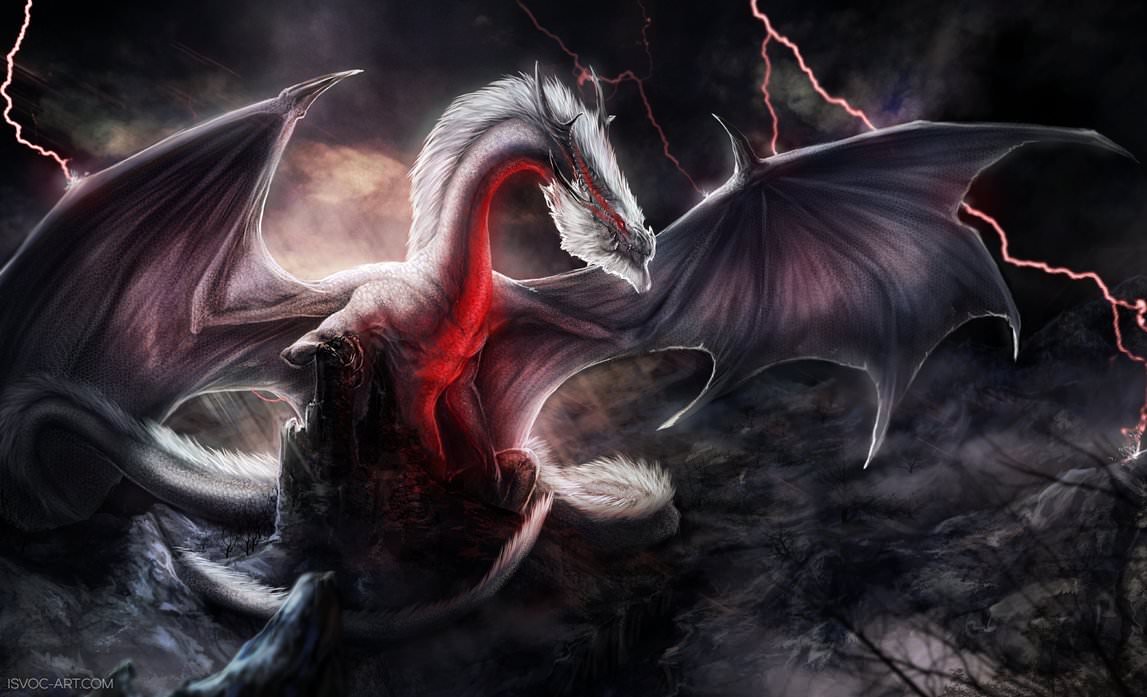
Table of Contents
-
Neopterons
- 2Altaroth (CR 0)
- 2Bnahabra (CR 1/4)
- 3Hornetaur (CR 1/4)
- 3Vespoid (CR 1/4)
- 4Vespoid Queen (CR 1)
- 4Great Thunderbug (CR 1/4)
- 5Konchu (CR 1/4)
- 6Seltas (CR 3)
- 7Seltas Queen (CR 11)
- 8Ahtal-Ka (CR 23)
- 11Ahtal-Nesto (CR 23)
-
Temnoceran
- 12Nerscylla (CR 6)
-
Elder Dragons
- 13Dire Miralis (CR 11)
- 14Kirin (CR 12)
- 15Lunastra (CR 12)
- 16Tempered Lunastra (CR 19)
- 17Teostra (CR 13)
- 19Chameleos (CR 14)
- 21Kushala Daora (CR 15)
- 23Valphalk (CR 16)
- 24Amatsumagatsuchi (CR 17)
- 26Dalamadur (CR 18)
- 27Yama Tsukami (CR 18)
- 29Gogmazios (CR 19)
- 31Nakarkos (CR 20)
- 33Alatreon (CR 21)
- 35Kulve Taroth (CR 21)
- 37Nergigante (CR 23)
- 38Vaal Hazak (CR 24)
- 39Xeno'jiiva (CR 25)
- 40Ceadeus (CR 26)
- 41Jhen Mohran (CR 26)
- 43Behemoth (CR 27)
- 45Fatalis (CR 28)
- 47Shah Dalamadur (CR 30)
- 49Lao-Shan Lung (CR 30)
-
Conditions
- 1Tarred
Condition: Tarred
A creature, object, or area who is tarred is covered in a dark brown or black viscous liquid. This liquid sticks to anything it touches and is highly flammable.
- A creature who is tarred is restrained, immune to being disarmed, and cannot use an object or weapon not already in hand.
- A tarred Object cannot be moved or used.
- An area that is tarred is considered difficult terrain.
- The condition ends if a creature, object, or area that has this condition takes fire damage. When the condition ends in this way the creature, object, or area ignite. Until a creature takes an action to douse the fire , the target takes 5 (1d10) fire damage at the start of each of its turns.
- When an area ignites, any object or creature in that area also ignite.
- An area that ignites in this way burns for 1 minute.
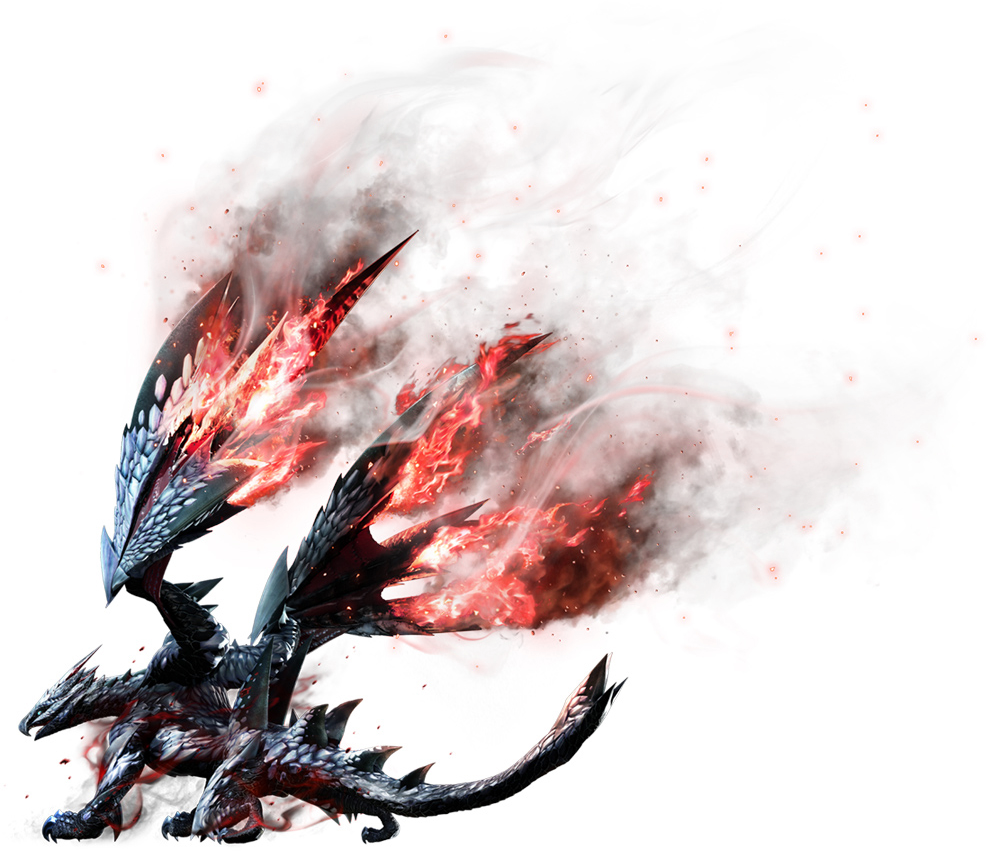
Neopterons
Neopterons are insectoid monsters known for their rigid carapaces. These monsters can range in size from tiny to enormous, and some species can fly, while others cannot. Neopterons are situated in large groups rather than individually. Most carry poisonous stingers that can paralyze prey, and their bodies are made up of acidic substances. Their weak outer-shell structures means that they are easily damaged, making it difficult to obtain adequate materials from their remains. Their materials are often used to make very sharp weapons.
Altaroth
Insects that widely inhabit many areas. Noted for absorbing fruit, mushrooms and honey, then carrying them back to their nest. Materials can thus be collected from their swollen abdomens, whose color is related to what is being carried. Altaroth have large mandibles used for absorbing their favorite foods. To help them feed, special enzymes are used to digest these foods. The foods are changed before they're held in Altaroth's abdomen and brought back to the colony. Altaroth are quite fragile in nature.
Altaroth
Small monstrosity (neopteron), unaligned
- Armor Class 12 (natural armor)
- Hit Points 4 (1d6 + 1)
- Speed 20 ft.
STR DEX CON INT WIS CHA 8 (-1) 10 (+0) 12 (+1) 1 (-5) 7 (-2) 3 (-4)
- Senses passive Perception 8
- Languages -
- Challenge 0 (10 xp)
Actions
Corrosive Spit. Range Weapon Attack. +2 to hit, range 20/40 ft., one target. Hit 2 (1d4) acid damage. If the creature is in either metal armor or has a metal shield being worn or carried, its takes a temporary -1 penalty to the AC it offers for 24 hours.
A altaroth is a nocturnal creature that can absorb mushrooms, berries, and other resources into the sacs on their backs. Alchemists and adventurers prize these creatures, for a altaroth sac contains a liquid said to cure any natural poison or disease. Though the sac is said to only hold its potency for ld6 days after the neopteron dies. Altaroth are most commonly found in forests and in mushroom groves.
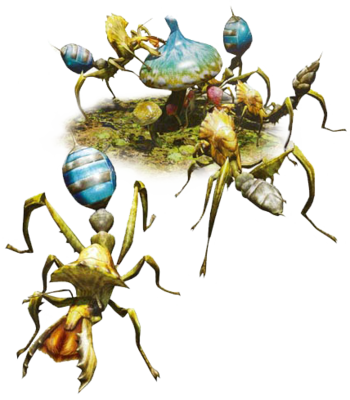
Bnahabra
Bnahabra are similar to the Vespoid. Bnahabra fly in a similar fashion, but there are various subspecies of the Bnahabra which vary between the regions, each with distinctly colored wings. Bnahabra are often seen attached to the sides of the walls seemingly lifeless, until a adventurer is close enough - then they fly away or attack. Unlike the Vespoid, Bnahabra can shoot a corrosive liquid which will reduce a adventurer's elemental resistance.
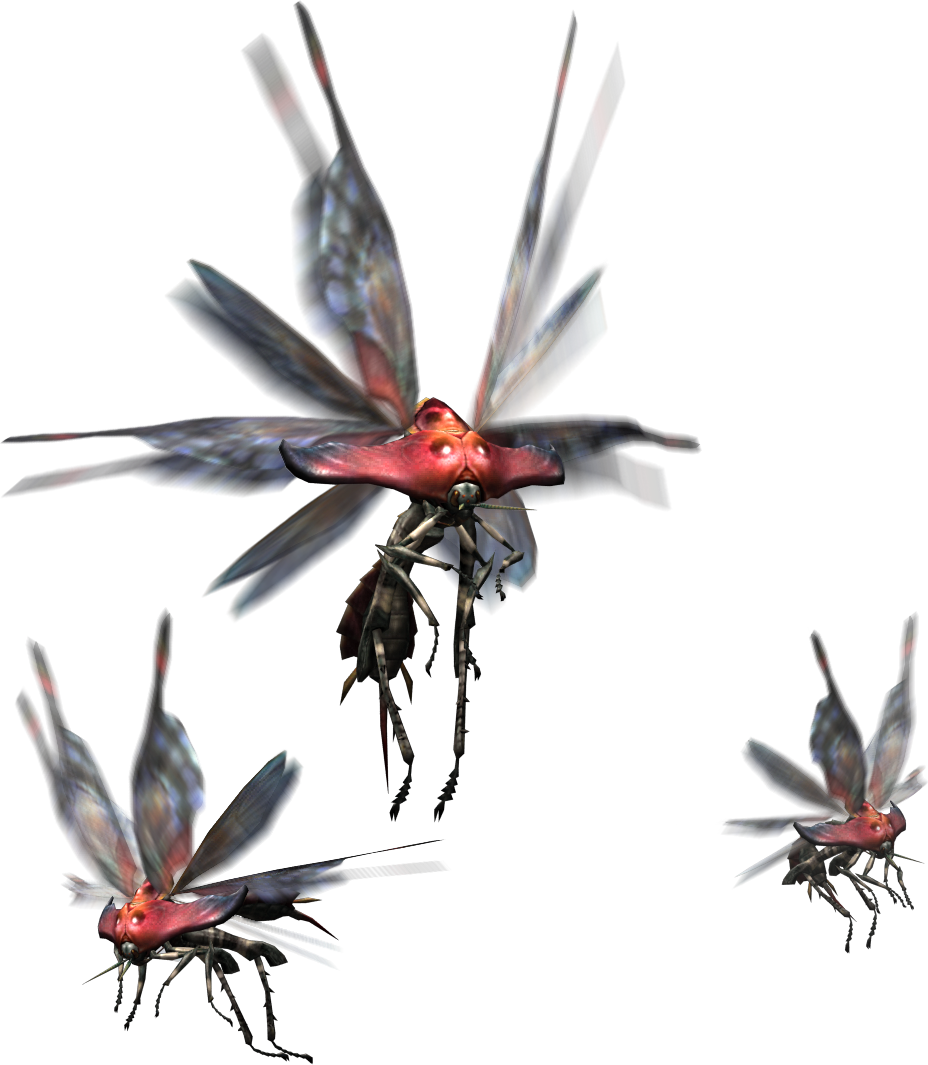
Bnahabra
Small monstrosity (neopteron), unaligned
- Armor Class 11 (natural armor)
- Hit Points 5 (1d6 + 2)
- Speed 0 ft., fly 30 ft.
STR DEX CON INT WIS CHA 5 (-3) 14 (+2) 14 (+2) 2 (-4) 12 (+1) 6 (-2)
- Senses passive Perception 11
- Languages -
- Challenge 1/4 (50 xp)
Flyby. The bnahabra doesn't provoke opportunity attacks when it flies out of an enemy's reach.
Actions
Corrosive Spray. Range Weapon Attack. +4 to hit, range 20/40 ft., one target. Hit 2 (1d4) acid damage. Roll 1d6, the number 1=fire; 2=poison; 3=lightning; 4=cold; 5=acid; 6=necrotic. Target creature is vulnerable to the damage type rolled for 1 hour.
Sting. Melee Weapon Attack. +4 to hit, reach 5 ft., one target. Hit 1 piercing damage plus 7 (3d4) poison damage.
Hornetaur
Hornetaurs sport a large horn for their size that may be used for defense. Their legs are strong, much like a Grasshopper's, so they can jump great distances. There wings are sharp enough to cut human skin just by brushing against them. Hornetaurs will frequently attack the adventurer in groups, making it irksome to fight other monsters in the area. Hornetaur are ravenous eaters that can eat away whole fields in a days time. They will pretty much eat everything in a area like a locust, causing major amounts of damage while doing so.
Hornetaur
Tiny monstrosity (neopteron), unaligned
- Armor Class 12 (natural armor)
- Hit Points 4 (2d4 - 1)
- Speed 20 ft.
STR DEX CON INT WIS CHA 7 (-2) 13 (+1) 9 (-1) 3 (-4) 5 (-3) 3 (-4)
- Skills Stealth +3
- Senses passive Perception 7
- Languages -
- Challenge 1/4 (50 xp)
Pack Tactics. The hornetaur has advantage on an attack roll against a creature if at least one of the hornetaur's allies is within 5 feet of the creature and the ally isn't incapacitated.
Actions
Horn. Melee Weapon Attack. +3 to hit, reach 5 ft., one target. Hit 6 (2d4+1) piercing damage.
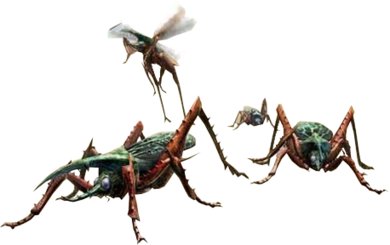
Vespoid
Tiny monstrosity (neopteron), unaligned
- Armor Class 11 (natural armor)
- Hit Points 5 (2d4)
- Speed 0 ft., fly 30 ft.
STR DEX CON INT WIS CHA 6 (-2) 14 (+2) 11 (+0) 2 (-4) 12 (+1) 6 (-2)
- Senses passive Perception 11
- Languages -
- Challenge 1/4 (50 xp)
Flyby. The vespoid doesn't provoke opportunity attacks when it flies out of an enemy's reach.
Actions
Sting. Melee Weapon Attack. +4 to hit, reach 5 ft., one target. Hit 1 piercing damage plus 7 (3d4) poison damage. On hit target must make a DC 10 Constitution saving throw, or become paralyzed for 1 minute. The target can repeat the saving throw at the end of each of its turns, ending the paralysis on itself on a success.
Vespoid
Vespoids are wasp-like insects roughly the size of a housecat. They have barbed stingers at the end of their abdomens, and fly using three pairs of wings. They are known to be a nuisance for adventurers, due to their stingers loaded with a neurotoxin that can paralyze foes. Vespoid are simple workers to a single large Vespoid Queen. They come in two varieties. The small worker Vespoid is charged with gathering food, maintaining the hive, and caretaking the queen and her eggs. The large, sturdier soldier vespoids exist for the sole purpose of defending the queen. They will frequently attack any intruders, no matter how large or small. Their stingers don't penetrate the thick shells of most wyverns, but pose a significant deterrent to humans and Fanged Beasts alike.
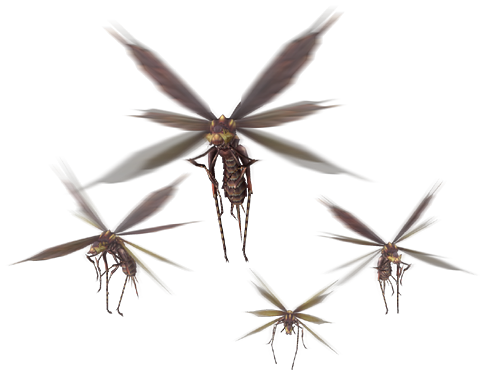
Vespoid Queen
The Vespoid Queen looks similar to the average Vespoid but is several times larger, with a more pronounced abdomen and giant, rainbow coloured wings. She has a rigid exoskeleton covering her soft innards and she has a crown-like structure atop her head.
Vespoid Queen rarely leave their nests as they send out workers to forage for food. They feed on smaller insects, birds, small mammals, lizards, and some vegetation. Whenever the queen does leave the nest she puts herself in serious danger as she can be preyed upon by creatures such as Gypceros, Yian Kut-Ku, Hypnocatrice, and Plesioth.
The Vespoid Queen rarely does battle; when it does, it essentially performs the same attacks as Vespoids with more power; however, it does possess an additional attack: it sprays body fluid at hunters that halves defense. It also produces a beating sound in order to command swarm of Vespoid in battle. The queen spends a vast majority of her time staying within the nest and laying eggs.
Vespoid Queen
Medium monstrosity (neopteron), unaligned
- Armor Class 14 (natural armor)
- Hit Points 27 (5d8 + 5)
- Speed 0 ft., fly 30 ft.
STR DEX CON INT WIS CHA 9 (-1) 18 (+4) 13 (+1) 10 (+0) 12 (+1) 9 (-1)
- Senses passive Perception 11
- Languages -
- Challenge 1 (200 xp)
Flyby. The vespoid queen doesn't provoke opportunity attacks when it flies out of an enemy's reach.
Actions
Sting. Melee Weapon Attack. +6 to hit, reach 5 ft., one target. Hit 1 piercing damage plus 11 (4d4) poison damage. On hit target must make a DC 11 Constitution saving throw, or become paralyzed for 1 minute. The target can repeat the saving throw at the end of each of its turns, ending the paralysis on itself on a success.
Corrosive Gas (Recharge 5-6). The vespoid Queen releases a corrosive gas from her stinger in a 30-foot cone. Each creature in that area must make a DC 14 Dexterity saving throw, taking 7 (2d6) acid damage on a failed save or half as much on a successful one. If a creature in that area has a nonmagical weapon made of metal, the weapon takes a permanent and cumulative -1 penalty to damage rolls. If its penalty drops to -5, the weapon is destroyed.
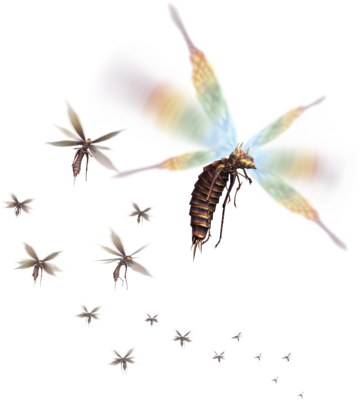
Great Thunderbug
Great Thunderbug are Thunderbug that have been living in a special environment, in most cases an Elder Dragon. From being in a special environment for so long, this Thunderbug has become giant, making it larger and brighter than other Thunderbugs. A Great Thunderbug's extracts still conduct electricity, even after dying.
Great Thunderbug can be seen most commonly and widespread in any location that is very warm and humid, and are known to feed on the electrical organs of other species, once the creature is dead.
Great Thunderbug are calm until threatened by a predator. n reality, there is only one Great Thunderbug in a swarm. Around this individual are smaller, normal Thunderbugs that are attracted to its glow. Due to the Great Thunderbug's glow, it becomes the leader of the Thunderbug swarm. By being together in a swarm, the Thunderbugs, along with their leader, the Great Thunderbug, are able to release powerful shocks that can actually paralysis threats quite easily. By swarming around a Great Thunderbug, the smaller Thunderbugs are able to generate a more powerful shock that is stronger than a regular Thunderbug's shock. The Great Thunderbug is always in the center of the swarm and if killed the other Thunderbugs will go their separate ways.
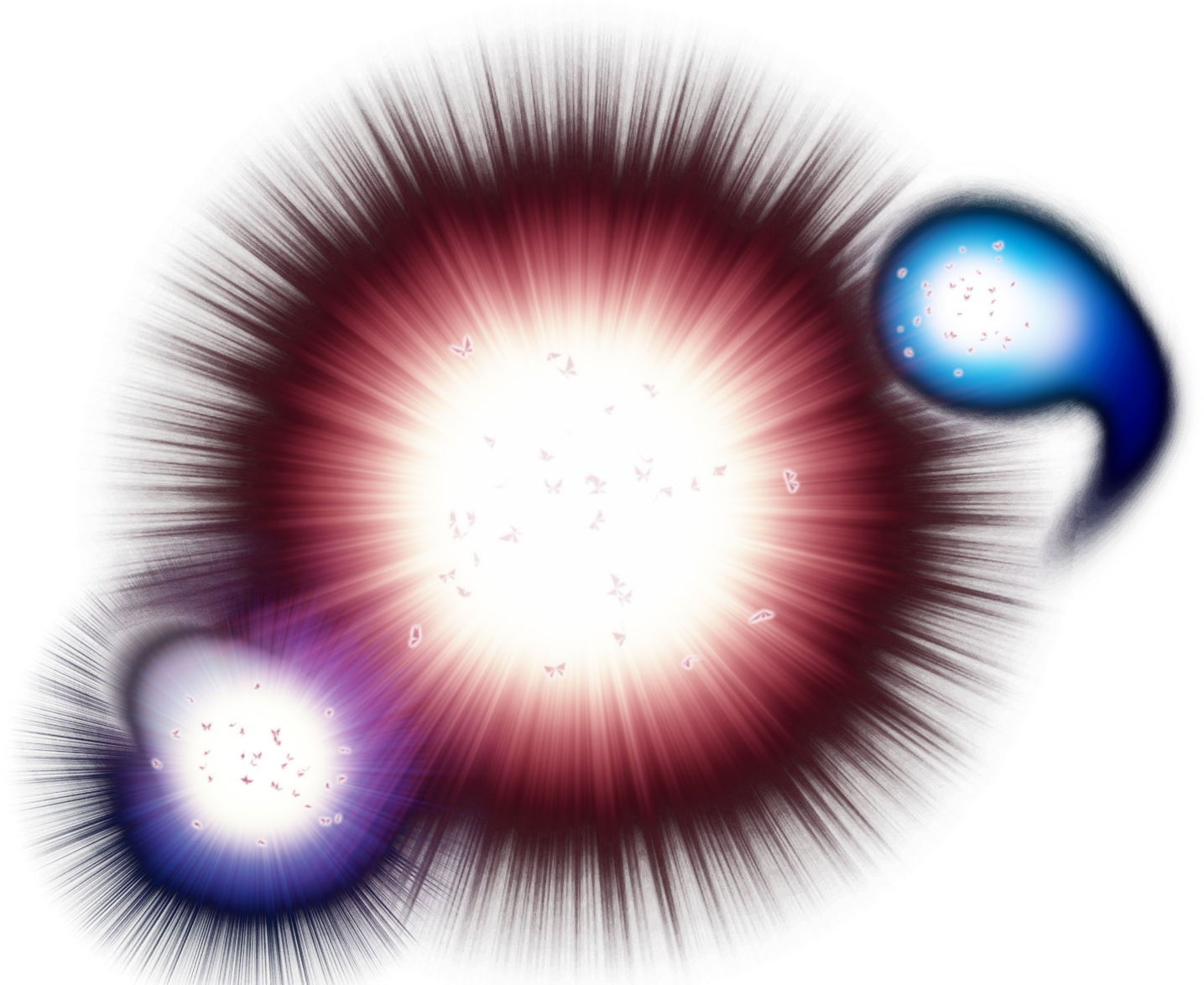
Great Thunderbug
Small monstrosity (neopteron), unaligned
- Armor Class 13 (natural armor)
- Hit Points 10 (3d6)
- Speed 0 ft., fly 30 ft.
STR DEX CON INT WIS CHA 6 (-2) 15 (+2) 10 (+0) 3 (-4) 14 (+2) 5 (-3)
- Skills Perception +4
- Senses passive Perception 14
- Languages -
- Challenge 1/4 (50 xp)
Actions
Shock. Melee Weapon Attack. +4 to hit, reach 5 ft., one target. Hit 1 piercing damage plus 5 (2d4) lightning damage. On hit target must make a DC 10 Constitution saving throw, or become paralyzed for 1 minute. The target can repeat the saving throw at the end of each of its turns, ending the paralysis on itself on a success.
Konchu
Konchu are highly adaptable and can be found in just about every type of environment. Interestingly. Konchu have a hard shell used for protection against threats. Konchu can curl themselves up into small balls, allowing them to roll around at high speeds. This adaptation can be used as both a means of escape and a form of attack. Konchu also possess powerful jaws used for grasping on to food. Variations of Konchu can have different colors depending on their environment, which they use as a form of camouflage to protect themselves from possible predators.
Konchu mostly stay hidden until they are threatened or smell food. Konchu will swarm around kills but they will wait until the predator is finished with that kill before feeding on the leftovers. When threatened, Konchu will attempt to frighten their attacker away by raising themselves onto their back feet and waving their fan-like pincers. If this does not work, they will proceed to launch themselves at their attacker in an attempt to tackle them. Oddly enough, some hunters have witnessed Konchu crawling on to the bodies of larger monsters and remaining there. This strange phenomenon seems to act as a natural form of armor for the large monsters on which the Konchu place themselves, making it difficult for hunters to damage the monster while it is covered in Konchu and their strong shells. It is uncertain whether this behavior is a sign of some sort of symbiotic relationship between Konchu and other monsters or not.
Konchu
Small monstrosity (neopteron), unaligned
- Armor Class 11 (natural armor)
- Hit Points 9 (2d6 + 2)
- Speed 40 ft.
STR DEX CON INT WIS CHA 13 (+1) 11 (+0) 12 (+1) 2 (-4) 9 (-1) 5 (-3)
- Skills Stealth +4
- Senses passive Perception 9
- Languages -
- Challenge 1/4 (50 xp)
Charge. If the konchu moves at least 20 feet straight toward a target and then hits it with a roll attack on the same turn, the target takes an extra 3 (1d6) bludgeoning damage. If the target is a creature, it must succeed on a DC 11 Strength saving throw or be knocked prone.
Actions
Roll. Melee Weapon Attack. +3 to hit, reach 5 ft., one target. Hit 4 (1d6+1) bludgeoning damage.
Claw. Melee Weapon Attack. +3 to hit, reach 5 ft., one target. Hit 5 (1d8+1) slashing damage.
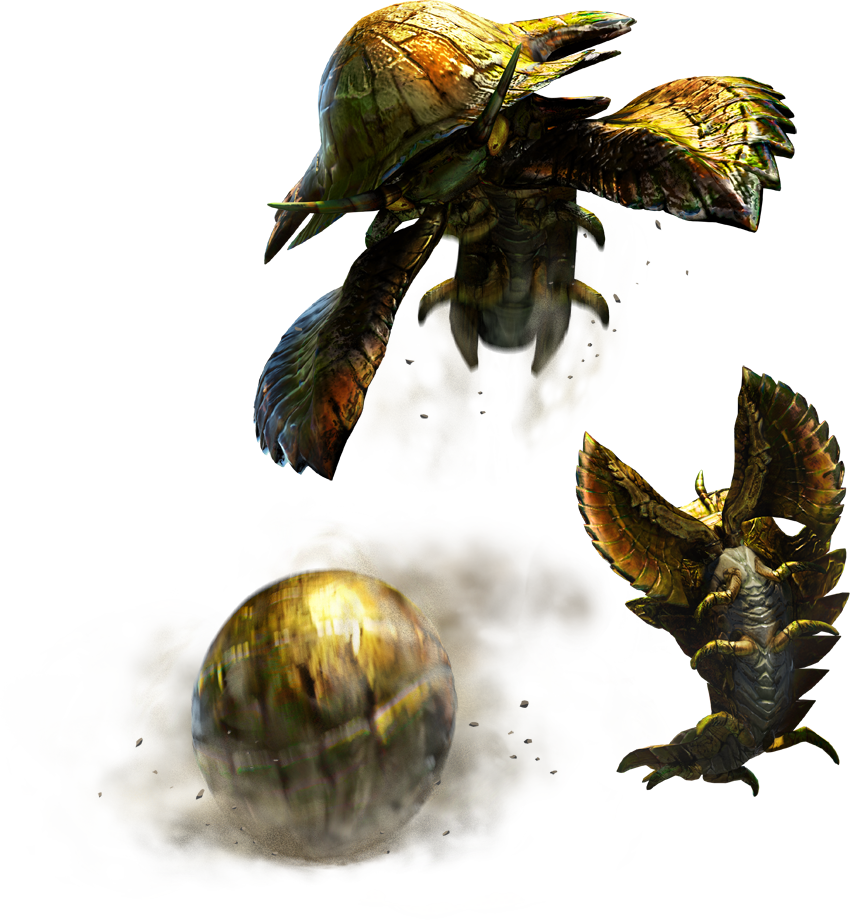
Seltas
Seltas is a large, mantis like insectoid with a brightly-colored, highly resistant exoskeleton, which is covered in spines and knobs. He has six legs, the foremost pair are armored and weaponized for combat, and a pair of collapsible wings. His head is hidden beneath a large, armored canopy that extends far beyond the rest of his upper body. He has a pair of compound eyes and powerful slicing mandibles. Seltas is the male counterpart to the Seltas Queen.
Seltas is predatory in nature, both large and powerful enough to prey on both hunters and small monsters alike. He is known to attack from the skies and use his weaponized forelimbs to attack. In addition, he is commonly known to attach himself to his massive female partner and transport her with his powerful wings.
When he is forced to merge with Seltas Queen, he will struggle at first to escape. But when the merge has been completed, he will fight alongside Seltas Queen without question as if hypnotized. He won't even fight back when being eaten by his mate, indicating that Seltas Queen has full control of Seltas.
Seltas possess an organ within their body that produces a disgusting liquid. This liquid can be used as a weapon, and as a means of feeding, as the liquid is highly corrosive by itself. Seltas have a long, armored canopy that can be used to pierce through predators and prey alike, which is also able to pierce through rock with their powerful speed. The main weapon of the Seltas, his claws, are used as weapon and as tool to hold down and subdue prey.
Seltas Queen
The Seltas Queen is a very large, beetle-like Neopteron with an armor-like exoskeleton covering its body. She is primarily a lustrous green color, but also features beige stripes and orange spines. She has six limbs, four of which make contact with the ground, the other two being used for digging and grasping prey. In addition, she has a long, segmented tail with a large pincer-like structure at the end. Seltas Queen is the female counterpart to Seltas, although she is physically very different.
These creatures are the largest known species of Neopteron to date. In fact, they are so heavy that whenever they walk the ground will shake. Seltas Queen have massive and powerful legs that end with two claws. These powerful limbs not only enable the giant insect to climb up rocky, uneven terrain, but greatly make the task of burrowing easy. The large pincers on the tail are mainly used for defense but, can also be used as a another limb for both grabbing objects and prey alike. In its tail, there are specialized organs that produce pheromones that'll send a Seltas flying to a female's exact location. When the male is within range, the female will quickly grab it and inject a special pheromone-like substance that causes the male to cease struggling. The male is then under the female's complete control and will do whatever she requires of him. If in battle, both the male and female will fight as one, this makes fighting the deadly Seltas Queen even deadlier as the two Neopterons will fight as one. A Seltas Queen is also capable of spitting balls of high-pressured watery mucus from its mandibles to slow down and injure prey.
Leading a mainly solitary lifestyle, Seltas Queen will only seek out the company of a Seltas if needed. Whether it be for food, mating, transportation, or added protection a Seltas Queen won't hesitate in releasing her specialized pheromones to bend a male to her will. Amazingly if in battle and in dire need of sustenance a Seltas Queen will not hesitate in violently killing and then eating her male counterpart to survive.
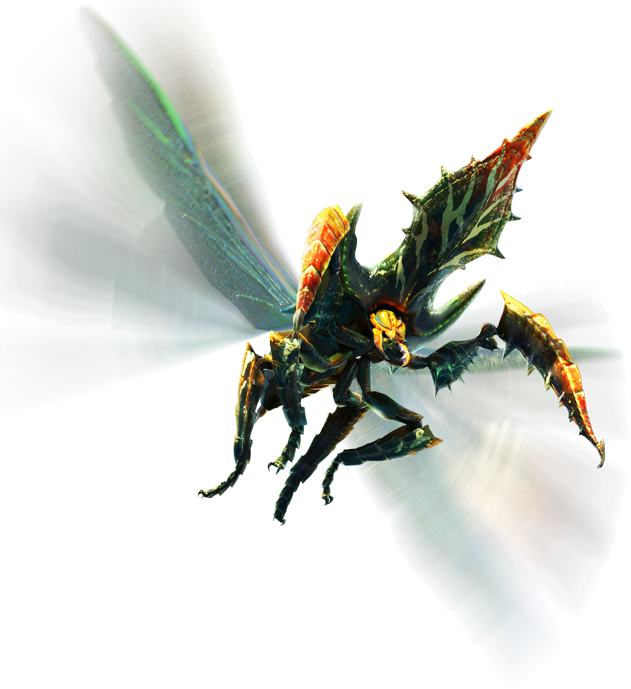
Seltas
Medium monstrosity (neopteron), unaligned
- Armor Class 15 (natural armor)
- Hit Points 32 (5d8 + 10)
- Speed 20 ft., fly 30 ft.
STR DEX CON INT WIS CHA 13 (+2) 15 (+3) 15 (+2) 8 (-1) 9 (-1) 3 (-4)
- Senses passive Perception 9
- Languages -
- Challenge 3 (700 xp)
Actions
Multiattack. The seltas makes three attacks, two with its Claws and one with its tail.
Claws. Melee Weapon Attack. +5 to hit, reach 5 ft., one target. Hit 6 (1d6 + 3) piercing damage.
Tail. Melee Weapon Attack. +5 to hit, reach 5 ft., one target. Hit 7 (1d8 + 3) piercing damage, and the target must make a DC 12 Constitution saving throw, taking 10 (3d6) poison damage, or half as much damage on a successful one.
Seltas Queen
Huge monstrosity (neopteron), unaligned
- Armor Class 18 (natural armor)
- Hit Points 142 (15d12 + 45)
- Speed 40 ft., burrow 30 ft., climb 30 ft.
STR DEX CON INT WIS CHA 15 (+2) 18 (+4) 17 (+3) 10 (+0) 12 (+1) 6 (-2)
- Senses passive Perception 11
- Languages -
- Challenge 11 (7,200 xp)
Drone Slave. As a Bonus Action, the seltas queen can take a seltas as a drone slave. the seltas and the queen take up the same spaces (though they can be targeted separately) and the seltas queen gains a flying speed of 60 feet. The seltas must use its action every turn to hold onto the seltas queen.
Actions
Multiattack. The seltas makes two attacks, one with its claws and one with its horn. Or three water orb attacks.
Claws. Melee Weapon Attack. +8 to hit, reach 5 ft., one target. Hit 16 (3d8 + 3) piercing damage.
Tail. Melee Weapon Attack. +8 to hit, reach 5 ft., one target. Hit 22 (3d12 + 3) piercing damage. If the target is large or smaller, it is grappled (escape DC 14) and restrained until the grapple ends. The seltas queen cannot use her tail attack on another target until this grapple ends.
Water Orb. Range Weapon Attack. +8 to hit, reach 40/160 ft., one target. Hit 10 (3d6) cold damage.
Call for Aid (1/day). The seltas queen calls out for assistance, summoning 2 seltas to aid her.
Legendary Actions
The seltas queen can take 3 legendary actions, choosing from the options below. Only one legendary action option can be used at a time and only at the end of another creatures turn. The seltas queen regains spent legendary actions at the start of its turn.
Attack. The seltas queen makes one water orb attack.
Devour. The seltas queen eat a seltas that is within 5 feet of her, healing for the seltas remaining hit points.
Release Pheromones (Costs 2 Actions). The seltas queen releases a cloud of pheromones in a 100 foot sphere around her. The cloud remains until the end of the seltas queen next turn. All creatures in the area, except for the seltas queen and other seltas, have disadvantage on concentration checks while in the cloud. If a seltas is charmed in the area, it is no longer charmed.
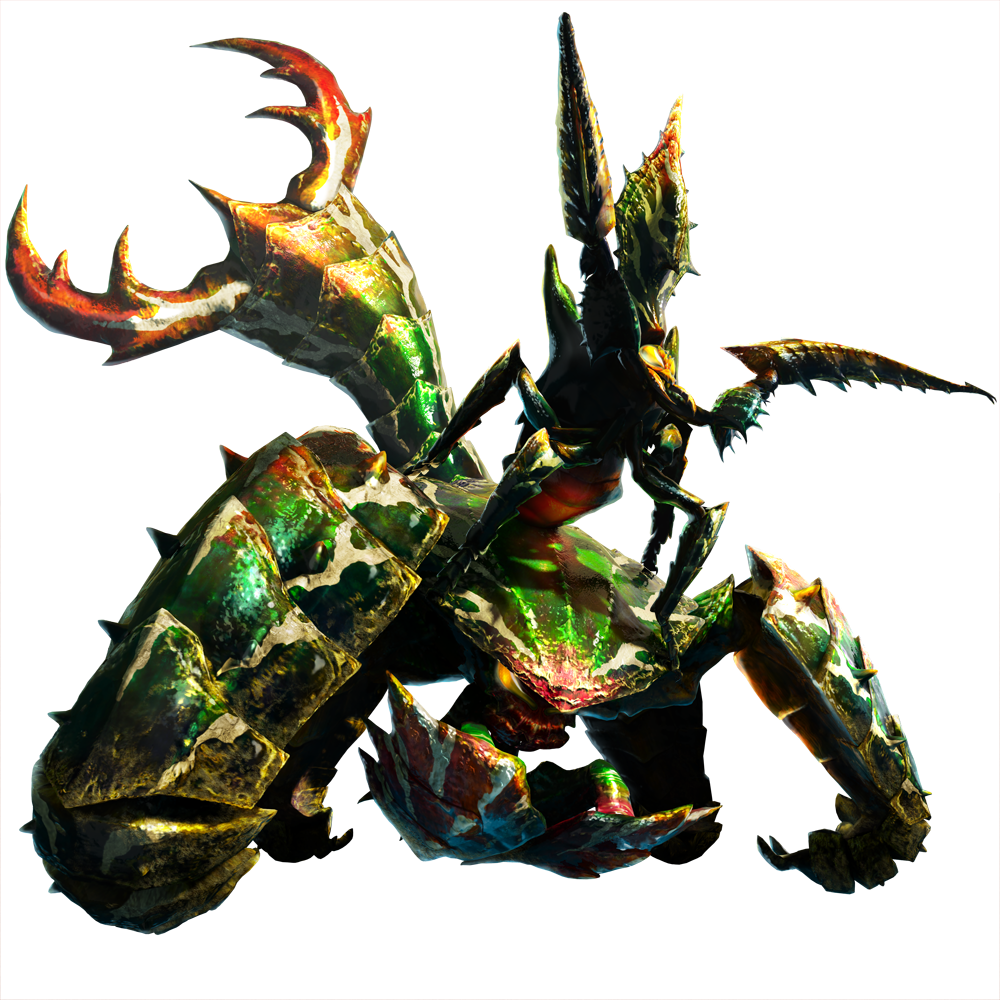
Ahtal-Ka
"In some places, there have been legends about this
Walking Treasure that wanders from place to
place. This treasure is said to raid fortresses,
leaving behind mass destruction, and defeat
whole armies in a matter of minutes. It is even capable of taking over a whole fortress if it wants to. Though
dangerous, inside this giant monster is a treasure that very few are lucky enough to see."
Ahtal-Ka is a legendary Mantis-like Neopteron that has been running wild for a few decades now.
Ahtal-Ka is a legendary Mantis-like Neopteron
that has been running wild for a few decades now.
Ahtal-Ka are predators, though it is unknown what
their common prey is. However, female Ahtal-Ka are well-known for feeding on males, showing that this species is cannibalistic in nature.
It somewhat resembles a devil's flower mantis in appearance and the color scheme is similar to that
of a classical Egyptian Pharaoh. The majority of
the body is golden. Its has a large headpiece that has alternating gold and blue lines like those on a
Pharaoh's crown. It has a pair of purple eyes, each
with a minuscule black pupil (much like a mantis).
It has six limbs, each of which are yellow with a
set of purple triangles beneath them. There are
four "legs" and two "claws"; at the end of the "legs"
are small claws/talons while the "claws" have elaborate
wing like extensions at the base and have a pair of large hooks at the ends. Though these claws are weapons,
they are mostly used as tools in manipulating the
goldensilk that Ahtal-Ka produces. This
beautiful silk is sticky and
strong, allowing for Ahtal-Ka
to pull and hold objects
together with little ease.
This silk is also strong enough
to hold a whole fortress
together. Ahtal-Ka mostly
uses the golden silk to
weave together debris it
has stolen from
fortresses. It uses
this debris to construct
something truly
monstrous, a "giant
walking puppet"
for itself called
Ahtal-Nesto.
Its "walking fortress'", the Ahtal-Nesto, is a towering war machine crudely assembled from scrap metal, debris from ruins, and the Ahtal-Ka's own silk. It is quadrupedal in structure, with a "head" vaguely reminiscent of a wyvern's and a tail tipped with metal spikes. The Ahtal-Ka's silk is visible through gaps in the joints and armor plating, and allows the Ahtal- Ka to control the movement of its creation like a marionette. When controlling the Ahtal-Nesto, the Ahtal-Ka itself is covered in a silken cocoon hidden in the "chest" of the machine.

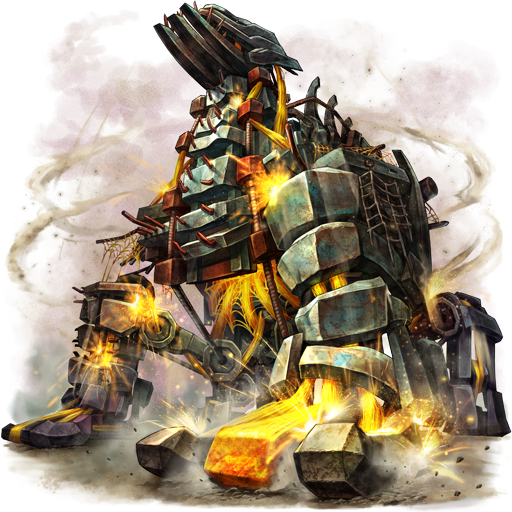
Ahtal-Ka
Huge beast (neopterons), chaotic evil
- Armor Class 22 (natural armor)
- Hit Points 310/310 (20d12 + 180)
- Speed 40 ft.
STR DEX CON INT WIS CHA 29 (+9) 14 (+2) 28 (+9) 16 (+3) 17 (+3) 21 (+5)
- Saving Throws Dex +9, Con +16, Wis +10, Cha +12
- Skills Perception + 17, Acrobatics +9
- Damage Resistances fire, necrotic; bludgeoning, piercing, and slashing from nonmagical attacks
- Condition Immunities charmed, frightened, stunned
- Senses darkvision 120 ft., passive Perception 27
- Languages -
- Challenge 23 (50,000 XP)
Legendary Resistance (3/Day). If the ahtal-ka fails a saving throw, it can choose to succeed instead.
Golden Silk. When a creature makes a melee weapon attack against the ahtal-ka's webbing and misses, the weapon becomes stuck to it, requiring an action and a successful DC 19 Strength check to pull free.
Magic Resistance. The ahtal-ka has advantage on saving throws against spells and other magical effects.
Paragon Creature. The ahtal-ka counts as a number of creatures equal to it's paragon multiplier (3 counting the ahtal-nest) for the purposes of determining combat encounters. The XP value for a ahtal-ka is multiplied by it's paragon multiplier.
Reel in. The ahtal-ka has a 10-foot beam on its back. When it throws the rusted beam it can pull it back to itself as a bonus action. Any creature in the path of the beam as it is pulled in must make a DC 26 Dexterity saving throw, taking 40 (9d8) bludgeoning damage on a failed save, or half as much on a successful one.
Actions
Multiattack. The ahtal-ka uses its dragonator lance and then makes four attacks: one claw swipe attack, two rusty beam attacks, and one spiderweb burst attack.
Claw swipe. Melee Weapon Attack: +16 to hit, reach 10 ft., one target. Hit: 19 (3d6 + 9) slashing damage. If there is another creature within 5 feet of the target, the other creature must make a DC 26 Dexterity saving throw, taking 19 (3d6+9) slashing damage on a failed save.
Rusted Beam. Melee Weapon Attack: +16 to hit, reach 20 ft., one target. Hit: 27 (4d8 + 9) bludgeoning damage.
Dragonator Lance. The ahtal-ka pulls a 20-foot long by 5-foot wide dragonator lance from the ground within 15 feet of it. It then sends it flying along a 120-foot line. Each creature along the line must make a DC 20 Dexterity saving throw, taking 22 (4d10) piercing damage on a failed save, or half as much on a successful one.
Throw (recharge 5-6). The ahtal-ka uses its claws to pull its webbing attached to the rusted beam sending it crashing down in a 10-foot cube within 60 feet of it. Each creature within the 10-foot cube must make a DC 26 Dexterity saving throw. On a failed save the creature is knocked prone and takes 40 (9d8) bludgeoning damage. On a successful save, the target takes half as much damage and is not knocked prone.
Spiderweb burst. Melee Weapon Attack: +16 to hit, reach 80/320 ft., one target. Hit:The target is Restrained by golden webbing. As an action, the Restrained target can make a DC 19 Strength check, bursting the webbing on a success. The webbing can also be attacked and destroyed (AC 20; hp 40; vulnerability to fire damage; immunity to bludgeoning, poison, and psychic damage).
Scatter Webs (recharge 6). The ahtal-ka releases ten 120-foot long 5-foot wide strands of golden webbing from its abdomen. Each strand goes in a different direction and if it impacts a hard surface, such as a wall, it immediately stops creating a line of webbing. Any creature that starts its turn within the line or moves into it for the first time, must make a DC 26 Dexterity saving throw or they are restrained by the webbing. As an action, the Restrained target can make a DC 19 Strength check, bursting the webbing on a success. The webbing can also be attacked and destroyed (AC 20; hp 40; vulnerability to fire damage; immunity to bludgeoning, poison, and psychic damage).
Paragon Trait
Paragon Fortitude. The ahtal-ka has multiple pools of hit points, each which is tracked separately. Damage and healing only applies to the current hit point pool. When a pool is depleted of all hit points, it becomes inactive. When this happens, the ahtal-ka immediately saves against all ongoing conditions and effects. If all hit point pools are inactive, the ahtal-ka dies. When it takes a long rest, the ahtal-ka heals all hit points in the current pool and fully heals one depleted hit point pool.
Paragon Fury. The ahtal-ka rolls initiative with advantage. The ahtal-ka starts with 1 paragon action. If a hit point pool is depleted, the ahtal-ka gains one additional paragon action. The ahtal-ka may use a paragon action after any other creature takes a turn. If the ahtal-ka does so, they regain their reaction. A paragon action is a complete turn. They have an action, bonus action and may move up to their full speed. The paragon actions refresh at the start of the ahtal-ka's turn and any remaining actions from the previous turn are lost.
Ahtal-ka stat block continued on next page.
Paragon Transformation. When the first pool of hit points becomes inactive, the ahtal-ka wrap itself in a cocoon and pull its collection of scrap metal, debris, and silk forming "walking fortress" known as the Ahtal-Nest. The ahtal-nest stat block can be found below.
When the ahtal-nest is destroyed or if it is unable to form it, the ahtal-ka enrages. While enraged, the ahtal-ka changes as follows:It gains the following abilities:
- Dragonator Barrier. Four dragonators constantly spin 5 feet above the ahtal-ka with the point of the lance cutting into the ground. When a creature starts its turn within 10 feet of the ahtal-ka or enters a space within 10 feet of the ahtal-ka for the first time on a turn they take 14 (2d6) slashing damage.
- Freedom of Movement. The ahtal-ka ignores difficult terrain, and magical effects can't reduce its speed or cause it to be restrained. It can spend 5 feet of movement to escape from nonmagical restraints or being grappled.
Its gains the following action:
- Dragonator Swarm. The ahtal-ka pulls out six dragonators from the ground attached to it by golden threads. When it uses this action, and as a bonus action on subsequent turns, the ahtal-ka can hurl up to two dragonators to a location within 120 feet of it. Each creature within 5 feet of the location must make a DC 26 Dexterity saving throw. The dragonator deals 22 (4d10) piercing damage on a failed save, or half as much damage on a successful save.
The following action change:
- Rusted Beam attack is renamed to Rusted Wheel.
- Multiattack. The ahtal-ka makes 5 attacks; two spiderweb burst attacks, one claw swipe attack, and two rusted wheel attacks.
- Throw (recharge 5-6). The ahtal-ka throws the 20-foot tall, 5-foot wide rusted wheel on its back. The rusted wheel travels along the ground for 120 feet in any direction. The ahtal-ka travels with the wheel without provoking attacks of opportunity, pulling it onto its back when the wheel stops. If the rusted wheel enters a creatures space during its travel, that creature must make a DC 26 Dexterity saving throw. On a failed save the creature is knocked prone and takes 81 (18d8) bludgeoning damage. On a successful save the creature takes half as much damage and is not knocked prone.
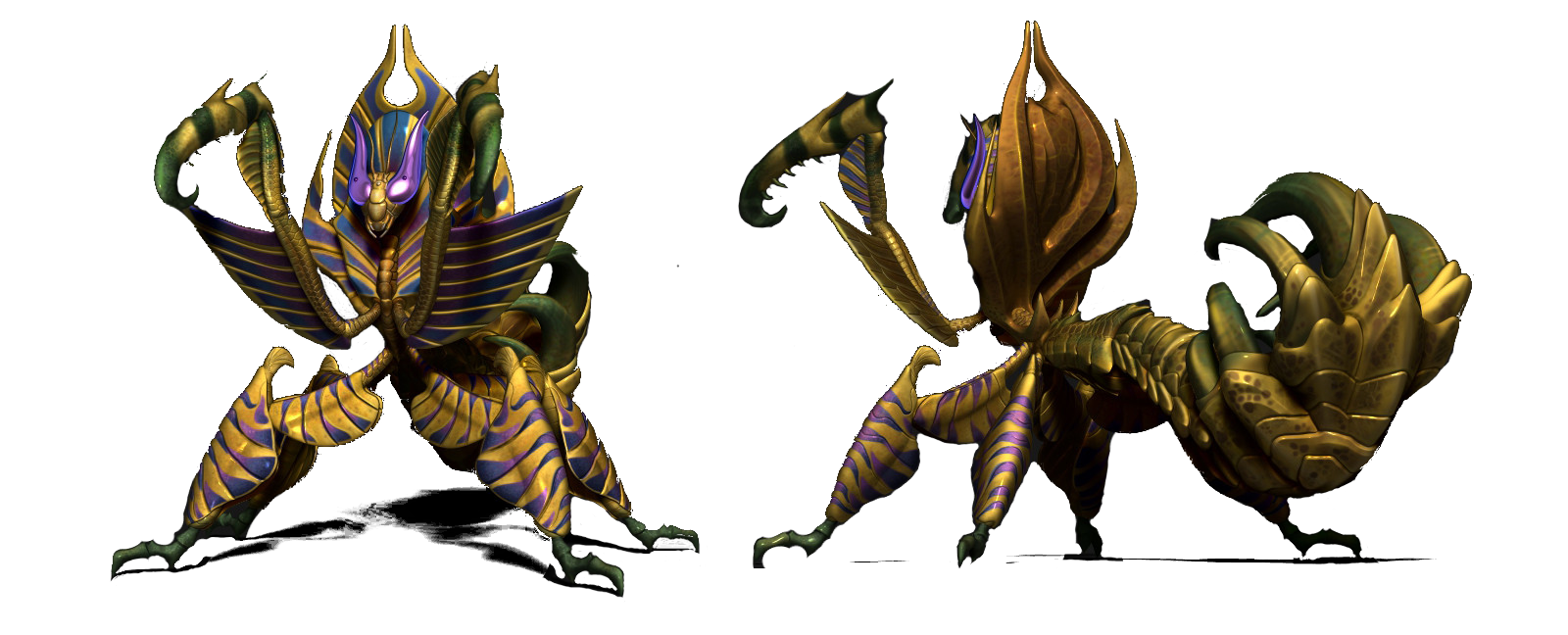
Ahtal-Nesto
Gargantuan Construct, unaligned
- Armor Class 23 (natural armor)
- Hit Points 259 (14d20 + 112)
- Speed 40 ft.
STR DEX CON INT WIS CHA 26 (+8) 12 (+1) 26 (+8) 16 (+3) 17 (+3) 21 (+5)
- Skills Skills Perception + 17
- Damage Resistances thunder; bludgeoning, piercing, and slashing from nonmagical attacks
- Damage Immunities poison
- Condition Immunities charmed, frightened, paralyzed, poisoned, unconscious
- Senses darkvision 120 ft., passive Perception 27
- Languages -
- Challenge 23 (50,000 XP)
Cocoon. At the heart of the ahtal-nesto, a ahtal-ka resides within a golden cocoon. This cocoon acts as a if it was a resilient sphere meant for a huge sized creature. While in the cocoon, the ahtal-ka controls the ahtal-nesto's actions and movement. Once the ahtal-nesto reaches 0 hit points, it falls apart and the ahtal-ka is released from its cocoon.
Immutable Form. The ahtal-nesto is immune to any spell or effect that would alter its form.
Golden Orb. The ahtal-nesto has 3 golden orbs made up of webbing, that fit in a 5 foot cube each, on its body; two are on either side of back between its front and hind leg, the other is located 15 feet above its back on its neck. Each orb has an AC of 20 and 50 hit points.
Golden Silk. When a creature makes a melee weapon attack against the ahtal-nesto's webbing and misses, the weapon becomes stuck to it, requiring an action and a successful DC 19 Strength check to pull free.
Golden Regeneration. The ahtal-nesto regenerates 90 hit points a round as it reconnects its scrap metal and debris with is golden threads. For each Golden Orb that is destroyed, the ahtal-nesto's regeneration is reduced by 30.
Axiomatic Mind. The ahtal-nesto can't be compelled to act in a manner contrary to its nature or its instructions from the ahtal-ka.
Siege Monster. The ahtal-nesto deals double damage to objects and structures.
Walking Fortress. The ahtal-nesto is a walking fortress, with four 20-foot tall climbable legs (Climb DC 20). Its back has two 20-foot long by 5-foot wide walkways adjacent to its legs.
At the start of the ahtal-nesto's turn. Each creature on it that cannot fly, or has not attached itself to the ahtal-nesto in some way, must succeed on a DC 20 athletics or acrobatics check or fall off the ahtal-nesto.Actions
Stomp. Melee Weapon Attack: +15 to hit, reach 10 ft., one target. Hit: 34 (4d12 + 8) bludgeoning damage.
Tail. Melee Weapon Attack: +15 to hit, reach 20 ft., one target on its body. Hit: The ahtal-nesto grabs a Large or smaller creature and throws it 60 feet in the direction of its choosing. If a thrown target strikes a solid surface, the target takes 3 (1d6) bludgeoning damage for every 10 feet it was Thrown. If the target is thrown at another creature, that is not on the ahtal-ka, that creature must succeed on a DC 18 Dexterity saving throw or take the same damage and be knocked prone.
Legendary Actions
The ahtal-nesto can take 2 legendary actions, choosing from the options below. Only one legendary action option can be used at a time and only at the end of another creatures turn. The ahtal-nesto regains spent legendary actions at the start of its turn.
Tail. The ahtal-nesto makes one tail attack.
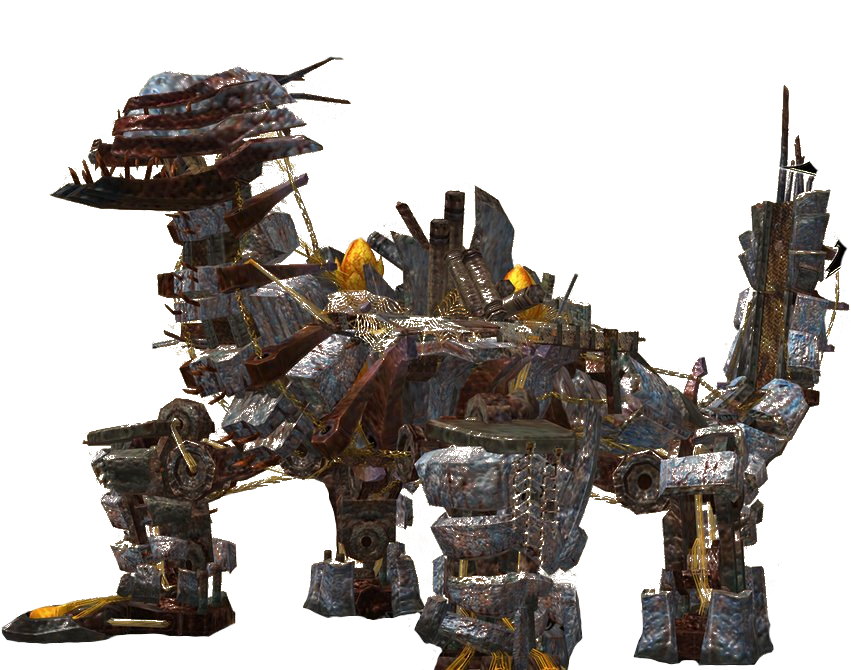
Temnoceran
Temnoceran, are a class of monster characterized by its arachnoid characteristics, such as the ability to produce silk, though they have six limbs similar to Neopterons or Carapaceons. This class includes only one type of monster, the Nerscylla.
Nerscylla
Nerscylla physically resembles a real life Arachnid, but is much larger in size. Nerscylla is armed with four powerful legs and two claws, each one tipped with a formidable barbed hook, used for holding prey as well as keeping its grip while scaling walls. In addition, it possesses a massive pair of retractable jaws which can inflict a poisonous bite. It can produce a strong, sticky webbing that it uses to trap prey and build nests.
Nerscylla physically resembles a real life Arachnid, but is much larger in size. Its long, strong legs allow it to move at fast speeds, even sideways. At the tip of its abdomen is a large stinger it may use to attack. Sharp, poisonous spikes protrude from its back.
Nerscylla is armed with four powerful legs and two claws, each one tipped with a formidable barbed hook, used for holding prey as well as keeping its grip while scaling walls. In addition, it possesses a massive pair of retractable jaws which can inflict a poisonous bite. It can produce a strong, sticky webbing that it uses to trap prey and build nests.
These large Temnocerans are ambush predators that will readily attack from behind, below, and above. When making a web they'll wisely construct it in an area where potential prey is most likely to appear. They are most commonly seen to construct their webs near farming settlements where they will attack and kill any livestock that wander into the vicinity of their web for food. Occasionally, they will even snatch away any unwary villagers/farmers that wander into their territory. As stated earlier Gypceros are the favorite prey of the Nerscylla but the food isn't the only reason why the Bird Wyvern is targeted. When killing a Gypceros the large arachnid not only eats it but disturbingly rips the skin off the avian Wyvern's body and wears it's skin as a cloak. This shocking behavior is both horrifying and intriguing to naturalists. The reason why Nerscylla do this is to increase their strength, use as camouflage, and for protection
Nerscylla
Large monstrosity (temnoceran), unaligned
- Armor Class 15 (natural armor)
- Hit Points 144 (17d12 + 34)
- Speed 30 ft., climb 30 ft.
STR DEX CON INT WIS CHA 17 (+3) 17 (+3) 14 (+2) 6 (-2) 12 (+1) 6 (-2)
- Skills Perception +4
- Damage Immunities poison
- Condition Immunities poisoned
- Senses passive Perception 14
- Languages -
- Challenge 6 (2,300 xp)
Reel in. As a bonus action, the nerscylla can pull a webbed target up to 15 feet towards the it. If the webbed creature is pulled within 5 feet of the nerscylla, it can make a stinger attack against it.
Spider Climb. The nerscylla can climb difficult surfaces, including upside down on ceilings, without needing to make an ability check.
Actions
Multiattack. The nerscylla makes three attack, one with its poisonous maw and two with its claws.
Poisonous Maw. Melee Weapon Attack: +6 to hit, reach 5 ft., one target. Hit 5 (2d4) piercing damage + 13 (3d8) poison damage
Claws. Melee Weapon Attack: +6 to hit, reach 5 ft., one target. Hit 10 (2d6 + 3) slashing damage. On hit, the target is grappled (escape DC 14).
Stinger. The nerscylla can only use its stinger on a webbed creature. The target creature must then make a DC 15 Constitution saving throw, taking 28 (8d6) poison damage and falls Unconscious for 1 hour on a failed save. On a successful save, the target takes half as much damage and remains conscious. The target is unconscious until they take damage, someone uses an action to shake or slap the sleeper awake.
Webbing Shot (recharge 5-6). Ranged Weapon Attack: +6 to hit, range 30/60 ft. , one Large or smaller creature. Hit: The creature is restrained by webbing. As an action, the restrained creature can make a DC 15 Strength check, escaping from the webbing on a success. The effect ends if the webbing is destroyed. The webbing has AC 12, 10 hit points, resistance to bludgeoning damage, and immunity to poison and psychic damage.
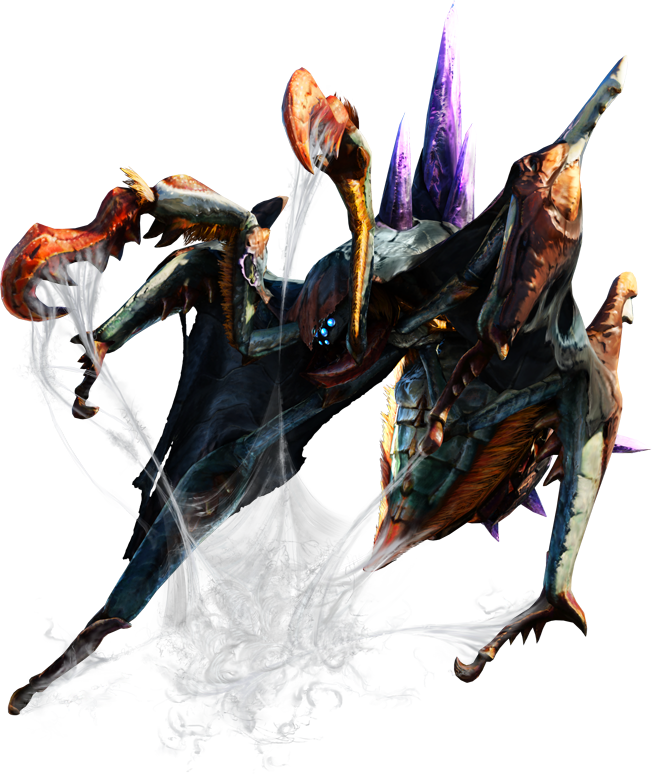
Elder Dragons
A very broad term, the only thing in common amongst all elder dragons is their power which seems to border the mystical as opposed to the wyverns which are all limited to natural laws. It is said that an elder dragons is powerful enough to single handedly bring about the destruction of an ecosystem. In ancient times, they would be mistaken for gods. Many elder dragons feature four legs and wings that are separate limbs, unlike wyverns with two legs and winged forelimbs.
Although all are called dragons, the genus isn't limited to four-legged, winged creatures. Spanning to beasts such as Kirin and Yama Tsukami as well as the more traditional Fatalis. Aside from these are the 'second generation' breed that all feature a similar build, the Teostra and Kushala Daora are members of this type with all featuring some form of barrier or aura to protect them.
Dire Miralis
Dire Miralis is a very large, semi-aquatic Elder Dragon. Its body structure is reminiscent of Fatalis, with relatively short limbs and a long tail and neck. Its body is filled with a magma-like substance which pools at the base of the tail, the chest, and at each shoulder. Each of these pools directs magma flow to certain parts of the body. On its back are a pair of wing-like appendages. Seemingly useless in terms of flight, these "wings" feature cannon-like chutes which can extrude globules of magma, both as a means of defense and as a way to jettison excess magma. Dire Miralis head features a frill-like structure and an upturned snout.
Due to the hot fluids inside of Dire Miralis, an intense heat is known to come from its body, boiling any sources of water around it. This intense heat can easily wipe out all living creatures within Dire Miralis's range.
Interestingly, long after a Dire Miralis dies, its heart continues to beat even if removed--just as legend states. It is said that Dire Miralis can regenerate its whole body with its heart alone, and that Dire Miralis is even immortal.
Dire Miralis is extremely hostile to all living things and can destroy an entire ecosystem just from its intense heat. A Dire Miralis actually destroyed the Tainted Sea and killed all living things in the area, filling the water with blood, until it was driven off in ancient times. This monster is one that many hunters don't live to tell about.
Dire Miralis
Gargantuan dragon (elder), unaligned
- Armor Class 18 (natural armor)
- Hit Points 155 (10d20+50)
- Speed 30 ft., swim 30 ft.
STR DEX CON INT WIS CHA 24 (+7) 16 (+3) 21 (+5) 12 (+1) 15 (+2) 9 (-1)
- Saving Throws Wis +6, Cha +3
- Damage Immunities fire
- Condition Immunities frightened
- Senses blindsight 120 ft., passive Perception 12
- Languages Draconic
- Challenge 11 (7,200 xp)
Legendary Resistance (2/Day). If the dire miralis fails a saving throw, it can choose to succeed instead.
Magma Armor. When the dire miralis is below half of its maximum hp, its body cools and AC increases by +4.
Siege Monster. The dire miralis deals double damage to objects and structures.
Actions
Multiattack. The dire miralis makes two claw attacks.
Claw. Melee Weapon Attack. +11 to hit, reach 5 ft., one target. Hit 25 (4d8+7) slashing damage.
Magma Glob. Range Weapon Attack. +7 to hit, reach 80/320 ft., one target. Hit The target and the space it is in, are covered in lava, taking 55 (10d10) fire damage. The space is covered in lava for 24 hours before cooling. Any creature that starts its turn or enters the space for the first time, takes 11 (2d10) fire damage. On a miss, an unoccupied space within 5 feet of the target is covered in lava. The lava ignites flammable objects in the area that aren't being worn or carried.
Crush. The dire miralis slams its body on the ground in a 40-foot square in front of it. Each creature in that areas must succeed on a DC 19 Strength or Dexterity saving throw (target's choice) or be knocked prone and take 18 (4d8) bludgeoning damage + 18 (4d8) fire damage. On a successful save, the creature takes only half the damage, isn't knocked prone, and is pushed 5 feet out of the dire miralis's space into an unoccupied space of the creature's choice. If no unoccupied space is with in range, the creature instead falls prone in the dire miralis's space.
Greater Fireball (recharge 5-6). The dire miralis exhales a massive fireball within 150 feet of its location. Each creature in a 25-foot radius Sphere centered on that point must make a DC 17 Dexterity saving throw. A target takes 38 (11d6) fire damage on a failed save, or half as much damage on a successful one.
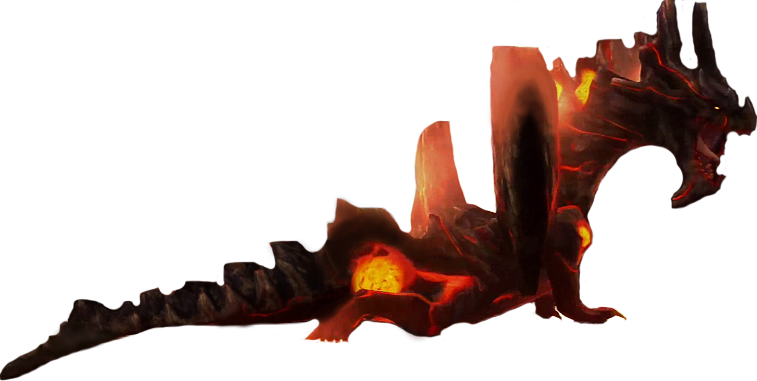
Kirin
Kirin resembles a unicorn, though a closer look reveals that it is covered in scales rather than a coat. Its majestic white mane and hair stand on end, as if charged with static. The monster often crackles with stray electricity.
Kirin have white fur used for picking up electricity. When enough electrical currents are picked up in the fur, Kirin will glow brightly and its hide will deflect most attacks. From this, the Adventurer's Guild believe that Kirin's high metabolism helps it pick up electricity as well. A Kirin's most vital feature is its longhorn. This horn is used to summon lightning from the sky, even when there isn't a storm cloud in sight, to strike any foes that threaten it. However, even if this horn is destroyed, Kirin can still summon lightning bolts with little effort.
Some of the more rare, older, or just stronger individuals are known for having unusually strong electrical powers that are yet to be fully understood. Some of the larger, more stronger muscles are located in its legs, capable of delivering deadly kicks. Equipped with such powerful legs, all Kirin possess the ability to run at speeds so unexpectedly fast they appear to teleport, leaving behind a trail of blue electricity.
Kirin are a highly unpredictable species. Sometimes Kirin are calm, other times they are aggressive. In one legend, it was said that a Kirin actually destroyed a whole village with its electrical powers.
Kirin
Large celestial (elder), unaligned
- Armor Class 17 (natural armor)
- Hit Points 127 (15d10+45)
- Speed 60 ft.
STR DEX CON INT WIS CHA 21 (+5) 16 (+3) 16 (+3) 19 (+4) 20 (+5) 20 (+5)
- Skills Perception +9, Insight +9, Religion +8
- Damage Immunities lightning
- Condition Immunities paralyzed
- Senses blindsight 30 ft., darkvision 120 ft., passive Perception 19
- Languages all, telepathy 120 ft.
- Challenge 12 (8,400 xp)
Control Lightning. The kirin can choose any location within 30 feet of it as the starting location of the lightning bolt spell.
Innate Spellcasting. The kirin's innate spellcasting ability is Wisdom. It can innately cast the following spells (spell save DC 17), requiring no material components:
At will: control weather, expeditious retreat, gust of wind, see invisibility
Legendary Resistance (3/Day). If the kirin fails a saving throw, it can choose to succeed in stead.
Magic Resistance. The kirin has advantage on saving throws against spells and other magical effects.
Magic Weapons. The kirin's weapon attacks are magical.
Spellcasting. The kirin is a 18th-level spellcaster. Its spellcasting ability is Wisdom (spell save DC 17, +9 to hit with spell attacks). It regains its expended spell slots when it finishes a short or long rest. It knows the following spells:
Cantrips (at will): light, shocking grasp, thaumaturgy, thunderclap
1st-5th level (4 5th-level slots): call lightning, destructive wave, elemental bane (lightning), lightning bolt, storm sphere, thunder step, thunder waveActions
Multiattack. The kirin makes three attacks: two with its hooves and one with its horn.
Hooves. Melee Weapon Attack. +9 to hit, reach 10 ft., one target. Hit 10 (2d4 + 5) bludgeoning damage.
Horn. Melee Weapon Attack. +9 to hit, reach 5 ft., one target. Hit 14 (2d8 + 5) piercing damage.
Legendary Actions
The kirin can take 3 legendary actions, choosing from the options below. Only one legendary action option can be used at a time and only at the end of another creatures turn. The kirin regains spent legendary actions at the start of its turn.
Detect. The kirin makes a Wisdom (Perception) Check.
Smite. The kirin makes a hoof attack or casts thunderclap.
Move. The kirin moves up to its half speed without provoking opportunity attacks.
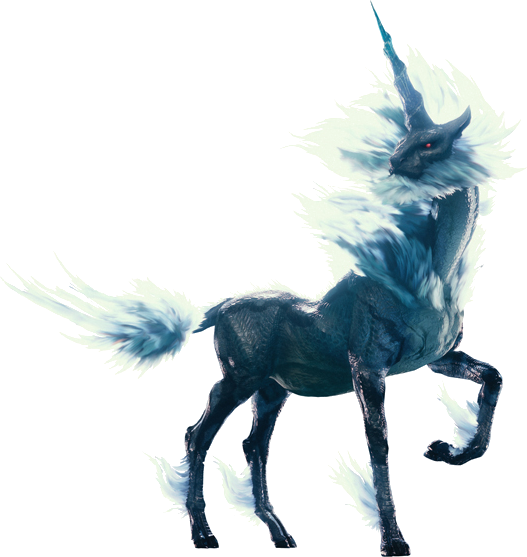
Lunastra
Lunastra is colored blue as opposed to Teostra who is red. Her horns are flatter and wider, making a sort of crown structure. They are known to breathe concentrated streams of fire, as well as cloak themselves in a scalding aura. Lunastra are high in the food chain, feeding on both coal, to fuel her fire abilities, and live prey like Apceros. Though Lunastra are powerful, they have to compete with other species like Rajang, Deviljho, and Akantor.
Lunastra, as a fire dragons, naturally have expert control over fire. They can use this ability when hunting to ensure quick and devastating kills. Despite her large size, she is quick on foot and can easily chase down fast moving prey. Lunastra can also generate a fire aura around their bodies from their horns, which helps prevent brazen monsters like Tigrex from dealing serious damage to them. These adaptations enable Lunastra to become a formidable apex predator wherever she is. Their wings are covered in a powder that can be released and, at will, set a flame burning in the air resulting in explosions. This explosive powder is actually the Lunastra's old skin.
Lunastra are brutal female elder dragons, quick to attack at the first sign of trouble, though not as much as Teostra. In the ruins of the old Towers, Lunastra are commonly found in their nest together with Teostra. This suggest that both actually stay in the nest together and guard their young. Though both haven't been seen in the nest together, both of their footprints can be found in the old nests and the active nests together.
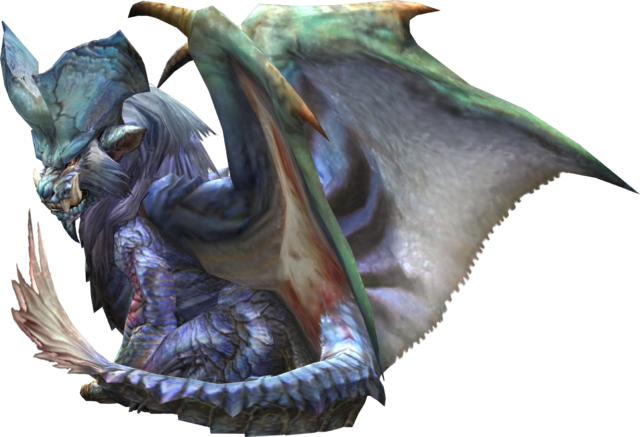
Lunastra
Huge dragon (elder), unaligned
- Armor Class 16 (natural armor)
- Hit Points 150 (12d12+72)
- Speed 50 ft., fly 40 ft.
STR DEX CON INT WIS CHA 21 (+5) 17 (+3) 22 (+6) 12 (+1) 18 (+2) 10 (+0)
- Saving Throws Str +9, Wis +6, Cha +4
- Skills Perception +6
- Damage Immunities fire
- Condition Immunities charmed, frightened
- Senses blindsight 60 Ft., darkvision 120 ft., passive Perception 16
- Languages Draconic
- Challenge 12 (8,400 xp)
Fire Aura. At the start of each of the lunastra's turns, each creature within 5 feet of it takes 3 (1d6) fire damage, and flammable objects in the aura that aren't being worn or carried ignite. A creature that touches the lunastra or hits it with a melee attack while within 5 feet of it takes 3 (1d6) fire damage.
Poison susceptibility. While poisoned, the lunastra's Fire Aura is deactivated, it must land on its next turn, and is unable to fly until the poisoned is removed. Once the poisoned condition is removed, the lunastra's Fire Aura once again takes effect.
Charge. If the lunastra moves at least 20 ft. straight toward a target and then hits it with a Bite attack on the same turn, the target takes an extra 13 (3d8) bludgeoning damage.
Actions
Multiattack. The lunastra makes three attacks; two claw attacks and one bite or one tail attack.
Bite. Melee Weapon Attack. +9 to hit, reach 10 ft., one target. Hit 18 (3d8 + 5) piercing damage.
Claws. Melee Weapon Attack. +9 to hit, reach 5 ft., one target. Hit 15 (3d6 + 5) slashing damage.
Tail. Melee Weapon Attack. +9 to hit, reach 10 ft., one target. Hit 18 (3d8 + 5) bludgeoning damage. On hit, the target must make a DC 17 Strength saving throw or be knocked prone.
Fire Breath (Recharge 5-6). The lunastra exhales fire in a 60-foot cone. Each creature in that area must make a DC 18 Dexterity saving throw, taking 36 (8d8) fire damage on a failed save, or half as much on a successful one.
Legendary Actions
The lunastra can take 3 legendary actions, choosing from the options below. Only one legendary action option can be used at a time and only at the end of another creatures turn. The lunastra regains spent legendary actions at the start of its turn.
Move. The lunastra moves up to its speed without provoking opportunity attacks.
Attack. The lunastra makes a bite attack.
Devil's Powder (Costs 2 Actions). The lunastra beats its wings releasing an explosive powder and creating a spark with her teeth. Each creature within 20 feet of the lunastra must succeed on a DC 18 Dexterity saving throw or take 11 (2d10) fire damage plus 11 (2d10) force damage and be knocked prone.
Tempered Lunastra
Huge dragon (elder), unaligned
- Armor Class 18 (natural armor)
- Hit Points 187 (15d12+90)
- Speed 50 ft., fly 40 ft.
STR DEX CON INT WIS CHA 21 (+5) 17 (+3) 22 (+6) 12 (+1) 15 (+2) 10 (+0)
- Saving Throws Str +11, Dex +9, Wis +8, Cha +6
- Skills Perception +8
- Damage Immunities fire
- Condition Immunities charmed, frightened
- Senses blindsight 60 Ft., darkvision 120 ft., passive Perception 18
- Languages Draconic
- Challenge 19 (22,000 xp)
Charge. If the tempered lunastra moves at least 20 ft. straight toward a target and then hits it with a Bite attack on the same turn, the target takes an extra 13 (3d8) bludgeoning damage.
Fire Aura. At the start of each of the tempered lunastra's turns, each creature within 5 feet of it takes 7 (2d6) fire damage, and flammable objects in the aura that aren't being worn or carried ignite. A creature that touches the tempered lunastra or hits it with a melee attack while within 5 feet of it takes 7 (2d6) fire damage.
Goddess of the Blue Flame. Fire damage dealt by the the tempered lunastra ignores fire resistance.
Legendary Resistance (3/Day). If the tempered lunastra fails a saving throw, it can choose to succeed instead.
Actions
Multiattack. The tempered lunastra makes three attacks; two claw attacks and one bite or one tail attack.
Bite. Melee Weapon Attack. +11 to hit, reach 10 ft., one target. Hit 18 (3d8 + 5) piercing damage plus 7 (2d6) fire damage.
Claws. Melee Weapon Attack. +11 to hit, reach 5 ft., one target. Hit 15 (3d6 + 5) slashing damage.
Tail. Melee Weapon Attack. +11 to hit, reach 10 ft., one target. Hit 18 (3d8 + 5) bludgeoning damage. On hit, the target must make a DC 17 Strength saving throw or be knocked prone.
Blue Flame Breath (Recharge 5-6). The tempered lunastra exhales blue flames in a 60-foot cone. Each creature in that area must make a DC 18 Dexterity saving throw, taking 45 (10d8) fire damage on a failed save, or half as much on a successful one.
Deadly Leap. If the tempered lunastra jumps at least 10 feet as part of its movement, it can then use this action to land on its feet in a space that contains one or more other creatures. Each of those creatures must succeed on a DC 19 Strength or Dexterity saving throw (target's choice) or be knocked prone and take 19 (4d6 + 5) bludgeoning damage plus 19 (4d6 + 5) fire damage. On a successful save, the creature takes only half the damage, isn't knocked prone, and is pushed 5 feet out of the tempered lunastra's space into an unoccupied space of the creature's choice. If no unoccupied space is with in range, the creature instead falls prone in the lunastra's space.
Supernova Pulse (1/day). The tempered lunastra beats its wings rising 20 feet into the air and releases a large burst of blue flames all around it. Each creature within 45 feet of the tempered lunastra must succeed on a DC 20 Dexterity saving throw, taking 45 (10d8) fire damage.
For the next 3 rounds, at the start of the tempered lunastra's turn, the blue flames pulse around her in a 30-foot radius. Each creature in that area must make a DC 20 Dexterity saving throw, taking 13 (3d8) fire damage on a failed save, or half as much on a successful one.Legendary Actions
The tempered lunastra can take 3 legendary actions, choosing from the options below. Only one legendary action option can be used at a time and only at the end of another creatures turn. The tempered lunastra regains spent legendary actions at the start of its turn.
Move. The tempered lunastra moves up to its speed without provoking opportunity attacks.
Attack. The tempered lunastra makes a bite attack.
Devil's Powder (Costs 2 Actions). The tempered lunastra beats its wings releasing an explosive powder and creating a spark with her teeth. Each creature within 20 feet of the tempered lunastra must succeed on a DC 20 Dexterity saving throw or take 16 (3d10) fire damage plus 16 (3d10) force damage and be knocked prone.
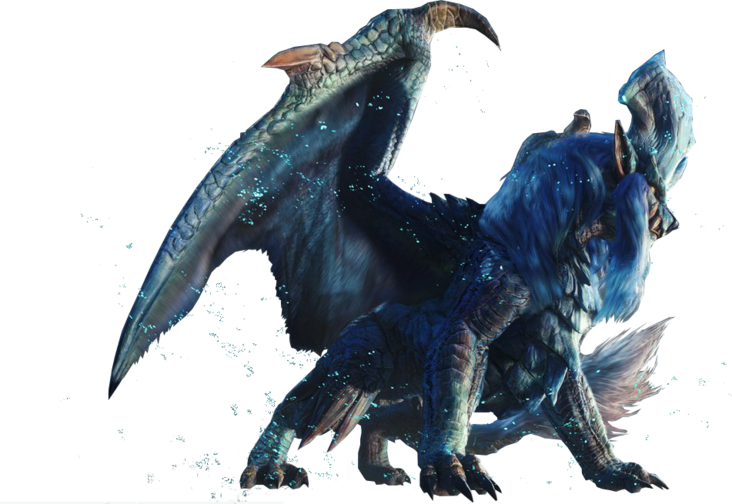
Teostra
Teostra is a dragon with leonine features and a fiery coloration. It has a grand mane, large fangs, and a pair of horns that curve backward. Its wings are covered in fur. Teostra is the male counterpart to Lunastra. Being predatory Elder Dragons Teostra are powerful top predators and are easily capable of killing weaker animals such as Aptonoth, Conga, Bulldrome, Iodrome, Apceros, and Cephadrome. Armed with razor sharp claws and flesh ripping teeth these Elder Dragons make short work of prey and smaller predators.
Possessing mastery over flame, there are few creatures that can hope to last against Teostra for long. To defend itself, the Teostra also utilizes a heat shield which damages enemies that get too close. To keep its flame powers going, they consume coal in volcanic environments. It also has detachable wing scales or powder that explode when ignited from a spark made when Teostra bites. It uses these to defend itself from attackers, although they give little protection against enemies with resilience to extreme heat such as Akantor or Lavasioth.
Teostra can even use the powder for many close range attacks but more skilled Teostra have learnt to use the powder at long range. When Teostra angered, it will fly into the air and ignite the powder all at once. When the powder is all ignited, Teostra will be covered in a large burst of fire, that is sometimes referred to as the Supernova.
Some extremely rare individuals have more control over their flaming powers than most. They have a different appearance also including more yellow wing webbing, a more reddish mane, red claws, orange tail end and golden eyes. New flame techniques include leaving pockets of explosive powder across the area in the air as it fights and setting them all a flame at will.
Teostra are a very aggressive monster. It will show dominance to anything that it encounters. Compared to Lunastra, who give warnings to get out of its territory, Teostra will ruthlessly attack intruders until they are dead. As one of the most aggressive Elder Dragons, Teostra are highly feared. It is not advised to go out into the Desert, Volcano, Swamp, or Tower when pairing with Lunastra, as the prospect of fighting both Lunastra and Teostra together is often considered suicidal.
A Teostra's Lair
Teostra's lair in high mountains or volcanoes, dwelling in caverns underground in the desert, or within the deep halls of abandoned mines and dwarven strongholds. Caves with volcanic or geothermal activity are the most highly prized teostra's lair, creating hazards that hinder intruders and letting searing heat and volcanic gases wash over a teostra as it sleeps. On rare occasions they can be seen living in more temperate areas such as a swamp or ancient forest, changing the area around it to suit its needs.
A teostra's lair is sometimes confused with the a red dragon's lair due to both of them mainly preferring areas with intense heat. On many occasions a teostra will attempt to take a red dragon's lair for its own, either by killing the red dragon or causing it to flee while gravely injured, leaving its horde of treasure behind. The teostra will guard this horde, mainly because it now belongs to him, but will typically not add to its treasure, being more concerned with intruders than riches.
A teostra encountered in its lair has a challenge rating of 14 (11,500 XP).
LAIR ACTIONS
On initiative count 20 (losing initiative ties), the teostra takes a lair action to cause one of the following effects; the teostra can't use the same effect two rounds in a row:
- A tremor causes the ground to crack and magma to bubble up in a 60-foot radius centered the teostra. That area becomes difficult terrain, and each creature there must succeed on a DC 15 Strength saving throw or be knocked prone.
- Magma erupts from a point on the ground within 120 feet of the teostra, The magma erupts in a 120-foot long, a 20-foot-high, 5-foot-wide line. Each creature in that line must make a DC 15 Dexterity saving throw, taking 11 (3d6) fire damage on a failed save, or half as much damage on a successful one. Flammable objects in the line that aren't being worn or carried ignite.
- Volcanic gases form a cloud in a 20-foot-radius sphere centered on a point the teostra can see within 120 feet of it. The sphere spreads around corners, and its area is lightly obscured. It lasts until initiative count 20 on the next round. Each creature that starts its turn in the cloud must succeed on a DC 13 Constitution saving throw or be poisoned until the end of its turn. While poisoned in this way, a creature is incapacitated.
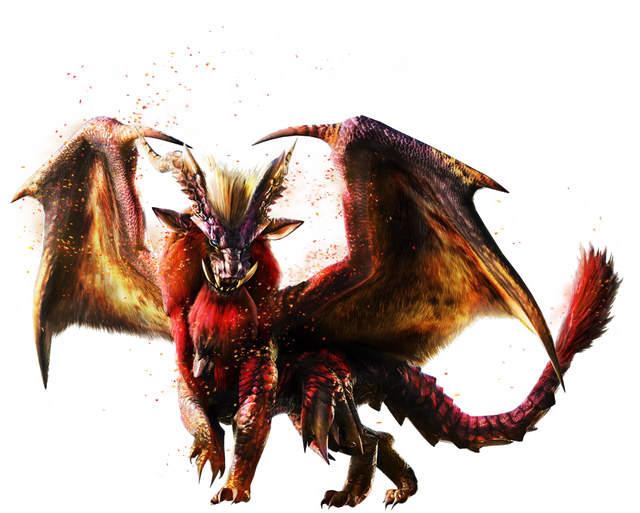
Teostra
Huge dragon (elder), unaligned
- Armor Class 16 (natural armor)
- Hit Points 156 (12d12+78)
- Speed 50 ft., fly 40 ft.
STR DEX CON INT WIS CHA 23 (+6) 17 (+3) 23 (+6) 14 (+2) 15 (+2) 10 (+0)
- Saving Throws Str +11, Wis +7, Cha +5
- Skills Perception +7
- Damage Immunities fire
- Condition Immunities charmed, frightened, poisoned
- Senses blindsight 60 Ft., darkvision 120 ft., passive Perception 17
- Languages Draconic
- Challenge 13 (10,000 xp)
Fire Aura. At the start of each of the teostra's turns, each creature within 5 feet of it takes 3 (1d6) fire damage, and flammable objects in the aura that aren't being worn or carried ignite. A creature that touches the teostra or hits it with a melee attack while within 5 feet of it takes 3 (1d6) fire damage.
Explosive Cloud. At the start of the teostra's turn, it beats its wings and four clouds of explosive powder appear in unoccupied 5-foot cubes of air within 60 feet of the teostra. Additionally every 15 feet the teostra moves, it leaves a cloud of explosive powder in a 5-foot cube. The clouds disperse after detonation, until a wind of moderate or greater speed (at least 10 miles per hour) disperses it, or when the teostra dies.
As a Bonus action, the teostra can move up to two of these clouds 10 feet in any direction.
Standing Leap. The teostra's long jump is up to 30 feet and its high jump is up to 15 feet, with or without a running start.
Actions
Multiattack. The teostra makes three attacks; two claw attacks and one bite or one tail attack.
Bite. Melee Weapon Attack. +11 to hit, reach 10 ft., one target. Hit 19 (3d8 + 6) piercing damage.
Claws. Melee Weapon Attack. +11 to hit, reach 5 ft., one target. Hit 16 (3d6 + 6) slashing damage.
Tail. Melee Weapon Attack. +11 to hit, reach 10 ft., one target. Hit 19 (3d8 + 6) bludgeoning damage. On hit, the target must make a DC 19 Strength saving throw or be knocked prone.
Fire Breath (Recharge 5-6). The teostra exhales fire in a 60-foot cone. Each creature in that area must make a DC 20 Dexterity saving throw, taking 32 (9d6) fire damage on a failed save, or half as much on a successful one.
Deadly Leap. If the teostra jumps at least 15 feet as part of its movement, it can then use this action to land on its feet in a space that contains one or more other creatures. Each of those creatures must succeed on a DC 19 Strength or Dexterity saving throw (target's choice) or be knocked prone and take 33 (6d8 + 6) bludgeoning damage. On a successful save, the creature takes only half the damage, isn't knocked prone, and is pushed 5 feet out of the teostra's space into an unoccupied space of the creature's choice. If no unoccupied space is with in range, the creature instead falls prone in the teostra's space.
Supernova. The teostra beats its wings rising 20 feet into the air and releases a large burst of fire all around it. Each creature within 25 foot radius of the teostra must succeed on a DC 20 Dexterity saving throw, taking 45 (10d8) fire damage and are pushed back 10 feet on a failed save, or half as much on a successful one and not pushed back.
Legendary Actions
The teostra can take 2 legendary actions, choosing from the options below. Only one legendary action option can be used at a time and only at the end of another creatures turn. The teostra regains spent legendary actions at the start of its turn.
Move. The teostra moves up to its speed without provoking opportunity attacks.
Attack. The teostra makes a bite attack.
Detonate (Costs 2 Actions). All Explosive Clouds detonate and burst into flames. Each creature within 10-feet of a explosive cloud must make a DC 17 Dexterity saving throw, taking 22 (4d10) fire damage on a failed save or half as much on a successful one. If a creature is within range of more than one explosive cloud, they take an additional 22 (4d10) fire damage for each additional cloud.
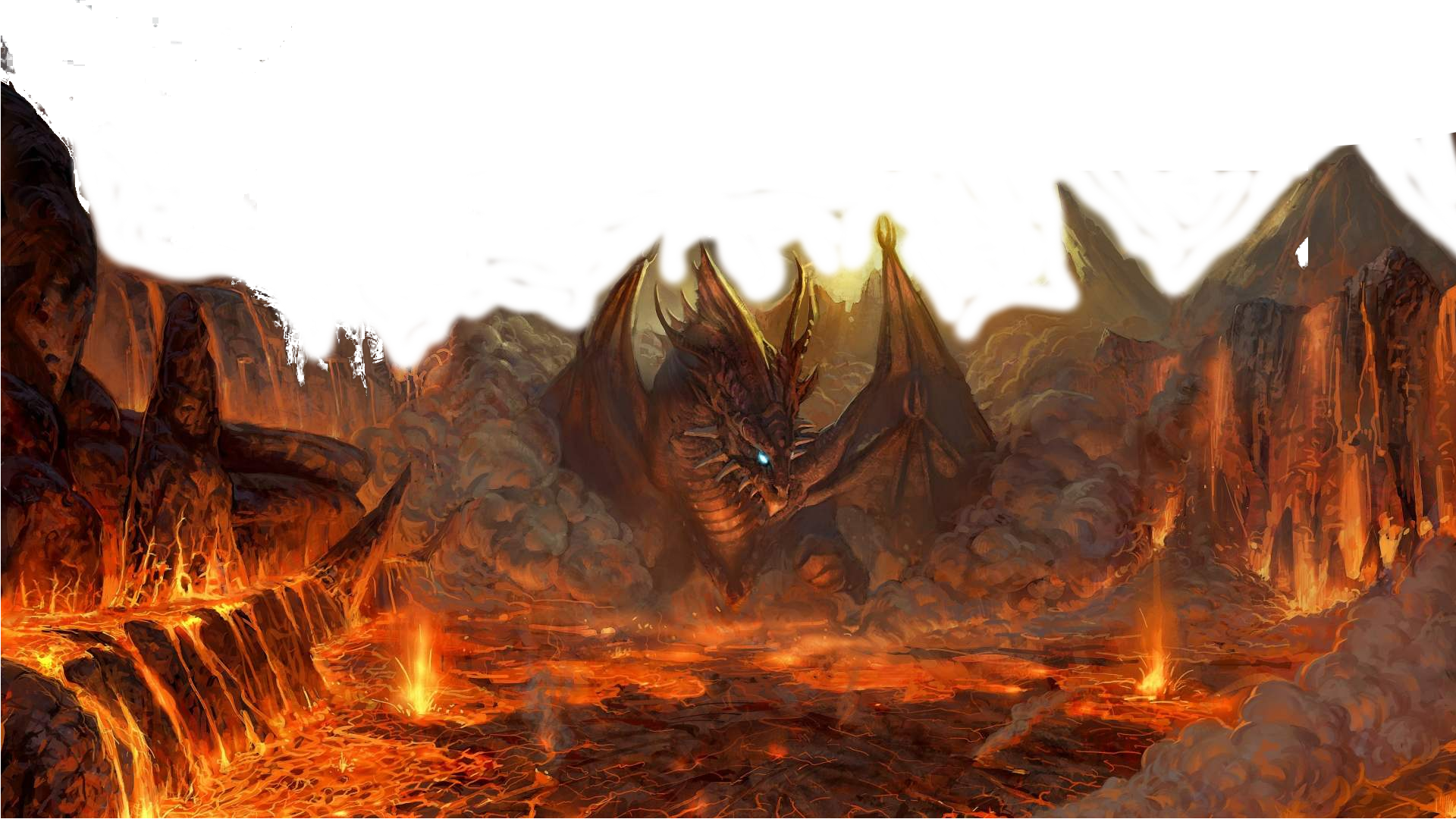
Chameleos
Chameleos's body is covered by a purple and white hide, and its head ends with a protruding horn at the tip of its nose. Its eyes are similar to a real life chameleon's; large and orb-like, with the ability to control eye movement individually. The long and elastic tongue can extend to grasp and steal items from a distance. Its wings are a purple color with a grayish white membrane, and are used for flight and controlling the direction of its poison fog. Chameleos's large tail is reminiscent of a leaf and has a curled, spiraling tip.
Chameleos are different from other Elder Dragons, as they are not nearly as "elegant" in their appearance as other Elder Dragon species. Chameleos have a number of biological adaptations that make them extremely unique. Most notably is the Chameleos's trademark camouflage mechanism. Each species of Chameleos has a different way of camouflaging itself. By generating a weak electric current in its skin that interacts with the mist it can breathe, the Elder Dragon can bend light around itself, rendering it effectively invisible. Some Chameleos use special ore to enable their camouflage. Chameleos have independently moving eyeballs that protrude from the sides of its head to create a wider field of vision. Chameleos have several nasty defenses should it ever come under attack. They possess an extremely strong poison, which can be released from its mouth at will and often whipped into a thick cloud by the dragon's wings. Some Chameleos also possess an extra vocal cord paralysis poison in their acid globs. Finally, it can exhale large amounts of mist to further hinder the vision of hunters, allowing it to either make a swift getaway or launch a surprise attack with ease.
Chameleos are ambush hunters, waiting patiently for prey to pass by while they blend perfectly into their surroundings. Chameleos can and will eat almost anything, and can use different tactics to take down varying sizes of prey. Should its prey be a Neopteron such as a Vespoid, Altaroth, Bnahabra, or Konchu it will simply snatch it out of the air using its long sticky tongue. If it is a supply camp, it'll steal with each opportunity it gets.
Chameleos are very intelligent creatures. They will wait patiently at a spot of importance such as a water source or natural crossroads, waiting for prey to pass by. Chameleos are well known for stealing items from adventurers. Chameleos do this in order for the adventurers to lose motivation in hunting them down.
A Chameleos's Lair
The Forest-Dwelling Chameleos very rarely share their territory with other dragons. With its ability to become invisible at will, it steals the treasures from anything that attempts to invade and take over. A chameleos lair is sometimes confused with the a green dragon's lair due to both of them having a perpetual fog hanging in the air, the chameleos carrying a sweeter whiff of its poison mist. Tiny mushrooms, known has toadstool, litter the ground releasing poisonous spores at the slightest touch. Growing bigger as you deeper into the forest.
At the center of the forest, the chameleos chooses a grove typically covered in mushrooms. The tree lining the grove are sparse, allowing the chameleos to move freely in and out. A hole has been dug out in the middle and has been filled with the treasures the chameleos has gathered from lost folk, adventurers, and anything else it has stolen in its travels
LAIR ACTIONS
On initiative count 20 (losing initiative ties), the chameleos takes a lair action to cause one of the following effects; the dragon can't use the same effect two rounds in a row:
- The Chameleos exhales a thick fog from its lungs filling the area. The fog is a 60-foot-radius, 30-foot-high cylinder centered on the chameleos, spreads around corners, and its area is heavily obscured. The fog lasts for 1 minute, until a wind of moderate or greater speed (at least 10 miles per hour) disperses it, or when the chameleos dies. While the chameleos remains in this fog, it can use its Invisible Passage as a free action at the end of its turn
- Poisonous mist billows around one creature the chameleos can see within 120 feet of it. The creature must succeed on a DC 15 Constitution saving throw or be poisoned until initiative count 20 on the next round.
- Chameleos causes 8 small poisonous mushrooms to grow in unoccupied spaces that it chooses within the lair. While the mushrooms are heavily obscured they are considered invisible. A creature that enters a space that the poisonous mushrooms occupy must make a DC 17 Constitution saving throw, taking 11 (3d6) poison damage and become poisoned for 1 minute on a failed save, or half as much damage and are not poisoned on a successful one. A creature can repeat the saving throw at the end of each of its turns, ending the poison on itself on a success.

Chameleos
Huge dragon (elder), unaligned
- Armor Class 16 (natural armor)
- Hit Points 178 (17d12+68)
- Speed 40 ft., fly 80 ft.
STR DEX CON INT WIS CHA 21 (+5) 14 (+2) 18 (+4) 16 (+3) 15 (+2) 14 (+2)
- Saving Throws Dex +7, Con +9, Wis +7, Cha +7
- Skills Perception +7
- Damage Immunities poison
- Condition Immunities poisoned
- Senses blindsight 60 Ft., darkvision 120 ft., passive Perception 17
- Languages Draconic
- Challenge 14 (11,500 xp)
Elder Sight. Magical Darkness doesn't impede the chameleos's darkvision.
Legendary Resistance (3/Day). If the chameleos fails a saving throw, it can choose to succeed instead.
Chameleon Skin. The chameleos has advantage on Dexterity (Stealth) checks made to hide.
Silent Step. While invisible, as a bonus action, the chameleos teleports up to 30 feet to an unoccupied space.
Actions
Multiattack. The chameleos makes three attacks: two with its horn and one with its tongue lash attack. It can replace any of these attacks with a poison spit attack.
Horn. Melee Weapon Attack. +10 to hit, reach 10 ft., one target. Hit 21 (3d10 + 5) piercing damage.
Tongue Lash. Melee Weapon Attack. +10 to hit, reach 15 ft., one target. Hit 15 (3d6 + 5) bludgeoning damage. On hit, if the target has an object in at least one hand, they must make a DC 15 Strength saving throw or have the object swallowed by the chameleos. If the chameleos takes 30 damage in one turn, it regurgitates all swallowed objects in an 5 foot area adjacent to it.
Poison Spit. Range Weapon Attack. +10 to hit, range 30/120 ft., one target. Hit 10 (3d6) poison damage. On hit, a poisonous cloud appears in a 5-foot-radius, 10-foot-high cylinder centered on the target that lasts for 24 hours or until strong wind disperses the cloud. On a miss, the cloud appears in an area adjacent to the target. A creature that starts its turn in the cloud or moves through it for the first time must make a DC 17 Constitution saving throw, taking 7 (2d6) poison damage and become poisoned on a failed save. On a successful save the creature takes half damage and is not poisoned.
Poison Mist(recharge 5-6). The chameleos exhales a poisonous mist in an 60-cone. Each creature in that area must make a DC 17 Constitution saving throw, taking 54 (12d8) poison damage on a failed save, or half as much damage on a successful one. The Mist lingers until the start of the chameleos next turn. A creature that starts its turn in the mist or move through it for the first time on a turn must make a DC 17 Constitution saving throw, taking 28(8d6) poison damage and become poisoned on a failed save. On a successful save the creature takes half damage and is not poisoned.
Invisible Passage. The chameleos magically turns invisible until it attacks or casts a spell, or until its concentration ends (as if concentrating on a spell). While invisible, the chameleos leaves no physical evidence of its passage, so it can be tracked only by magic.
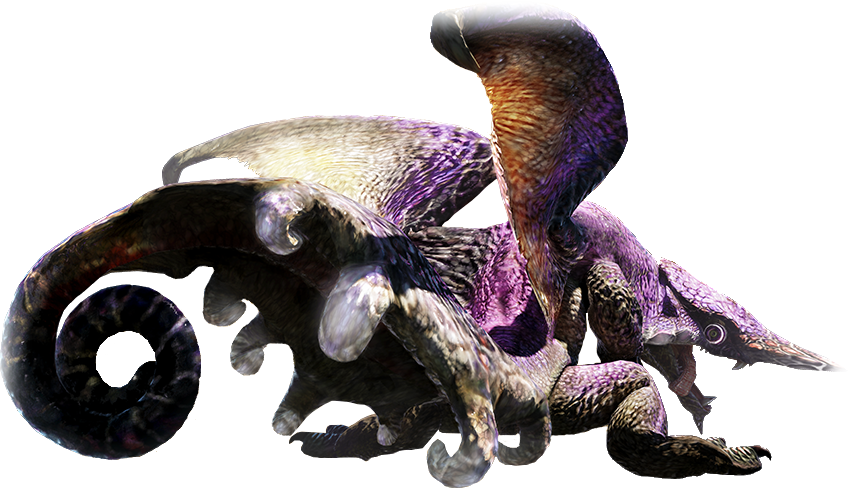
Kushala Daora
Kushala Daora is a four legged Elder Dragon with a pair of widely spreading wings. Its skin is plated with metal that makes weapons bounce off without enough sharpness. Kushala Daora has numerous horns lining its head and sharp claws on each of its legs. Kushala Daora have the ability to manipulate strong winds, creating a wind barrier that surrounds itself. The wind barrier can knock a adventurer back, making the adventurer vulnerable to Kushala Daora's attacks. The wind barrier also makes it difficult for the adventurer to attack its body.
Kushala Daora are rare top predators, and fear almost nothing. However, it is occasionally threatened by the large, fast and aggressive Tigrex and the rare powerful Rajang. They can compete with other elder dragons, especially Chameleos in the Jungle. There are reports of Kushala Daora eating mineral deposits, this may show how they manage to have a metal rust-able skin. Kushala Daora possesses some of the largest wings of any monster. It uses these to sail effortlessly in the air. It can hover off the ground and blast hunters with wind.
It uses a special organ to produce its famous wind based-attacks and abilities. When hit with poison, its organ will be weak and its shield will disappear for a short period of time while fighting the toxins. Kushala Daora have tough, metal filled skin, but suffer from a severe weakness to poison, which can easily enter the bloodstream through cracks created in the skin. Kushala Daora must infrequently shed their trademark skin as they grow. This can easily be spotted as the once shining silver scales will rust over due to oxidation with air. The most well-known ability about Kushala Daora is the storms it summons. These storms can easily destroy whole regions, varying from region to region. Kushala Daora can cause sandstorms, hurricanes, and snowstorms though it is unknown how.
Some extra rare individuals have increased storm and wind-creating abilities. Such as creating multiple free-roaming tornadoes and wind tunnels under multiple targets all at once using its wings to control the wind flow, they are able to blow a breath that is both extremely strong and cold to the point of freezing the ground and water it has breathed on.
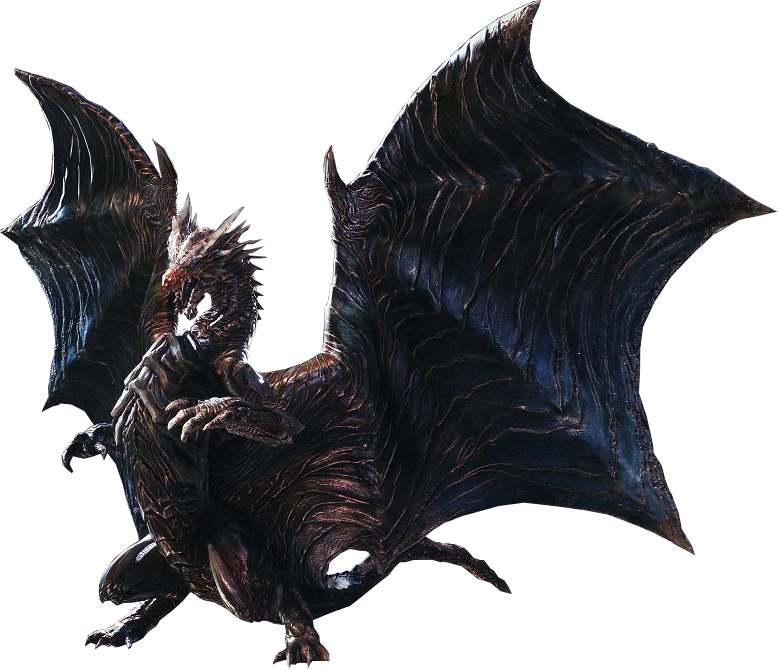
Kushala Daora
Huge dragon (elder), unaligned
- Armor Class 19 (natural armor)
- Hit Points 189 (18d12+72)
- Speed 40 ft., fly 80 ft.
STR DEX CON INT WIS CHA 23 (+6) 18 (+4) 19 (+4) 18 (+4) 15 (+2) 12 (+1)
- Saving Throws Str +11, Dex +9, Wis +7, Cha +6
- Skills Perception +7, Stealth +9
- Damage Vulnerabilities poison
- Senses blindsight 60 Ft., darkvision 120 ft., passive Perception 17
- Languages Draconic
- Challenge 15 (13,000 xp)
Wind Barrier. A barrier of strong wind surrounds the kushala daora in a 5-foot radius around it. The strong wind keeps fog, smoke, and other gases at bay. Small or smaller flying creatures or Objects can't pass through the barrier. Loose, lightweight materials brought into the barrier fly upward. Arrows, bolts, and other ordinary projectiles launched at the kushala daora are deflected upward and automatically miss. (Boulders hurled by Giants or siege engines, and similar projectiles, are unaffected.) Creatures in Gaseous Form can't pass through the barrier. When a Medium sized creature enters the Wind Barrier's area for the first time on a turn or starts its turn there, they must make a DC 19 Strength saving throw or be pushed back 10 feet. If a creature fails the saving throw by more than 5 they are also knocked prone.
Poison susceptibility. While poisoned, the kushala daora's Wind Barrier is deactivated, it must land on its next turn, and is unable to fly until the poisoned is removed. Once the poisoned condition is removed, the kushala daora's Wind Barrier once again takes effect.
Flyby. The kushala daora doesn't provoke opportunity attacks when it flies out of an enemy's reach.
Actions
Multiattack. The kushala daora makes two bite attacks.
Bite. Melee Weapon Attack. +11 to hit, reach 10 ft., one target. Hit 22 (3d10 + 6) piercing damage.
Barrage. The kushala daora rains the debris down to the ground in a 10-foot-radius, 20-foot-high cylinder centered on a point within 150 feet. Each creature in the cylinder must make a DC 16 Dexterity saving throw. A creature takes 16 (3d10) bludgeoning damage and 16 (3d10) slashing damage on a failed save, or half as much damage on a successful one.
Tornado (recharges after a long or short rest). The kushala daora conjures an tornado that lasts for 1 minute. The tornado is a 20-foot-radius, 60-foot-high spiraling cylinder of wind centered on a location within 100 feet of the kushala daora. This cylinder becomes difficult terrain for the duration, even for flying creatures. Unattended objects in this cylinder that are Large or smaller are pulled towards the center. When a creature enters the tornado's area for the first time on a turn or starts its turn there, it is struck by debris the tornado has picked up, and it must make a DC 19 Strength saving throw or taking 14 (4d6) bludgeoning damage plus 14 (4d6) slashing damage, they are pulled to the center of the cylinder, and are restrained on a failed save. On a successful save the creature takes half as much damage and they are not pulling into the center or restrained.
On each of the kushala daora's turns, it must use its bonus action to move the tornado 30 feet in any direction.
Wind Tunnel (recharge 5-6). The kushala daora blast of strong wind in a 90 foot line that is 10 feet wide. Each creature in the line must succeed on a DC 19 Strength saving throw, taking 49 (11d8) force damage and be pushed 15 feet away in a direction following the line on a failed save or half as much on a successful one and pushed away. Any creature in the line must spend 2 feet of movement for every 1 foot it moves when moving closer to the kushala daora. The wind tunnel disperses gas or vapor, and it extinguishes candles, torches, and similar unprotected flames in the area. It causes protected flames, such as those of lanterns, to dance wildly and has a 50 percent chance to extinguish them.
Legendary Actions
The kushala daora can take 3 legendary actions, choosing from the options below. Only one legendary action option can be used at a time and only at the end of another creatures turn. The kushala daora regains spent legendary actions at the start of its turn.
Move. The kushala daora can move all dust devil up to 30 feet in any direction.
Bite Attack. The kushala daora makes a bite attack.
Dust Devils (Costs 2 Actions). The kushala daora chooses 3 unoccupied 5-foot cube within 60 feet of it. An elemental force that resembles a dust devil appears in the cube and lasts for 1 minute. Any creature that starts its turn within 5 feet of the dust devil must make a DC 19 Strength saving throw. On a failed save, the creature takes 9 (2d8) bludgeoning damage and is pushed 10 feet away. On a successful save, the creature takes half as much damage and isn’t pushed.
If the dust devil moves over sand, dust, loose dirt, or small gravel, it sucks up the material and forms a 10-foot-radius cloud of debris around itself that lasts until the start of your next turn. The cloud heavily obscures its area.
Valphalk
Valphalk is a slender Elder Dragon covered in gleaming silver scales. Its most notable feature is its wings, which have fused into a trident-like structure. Its back is lined with fin-like projections. Its head has a small crest and its eyes are blue.
Valphalk is covered in reflective silver scales that give this monster its slim appearance. Like most other Elder Dragons, Valphalk has six limbs: four legs and a pair of wings. Unique to Valphalk are its trident shaped wings.The wings of the Valphalk are versatile and flexible being able to stretch the arm appendages to hit far-reaching targets, expanding its wings resembling a three-fingered claw for wider area of attack or closing the wings to make use of the blade-like tip on the frontal end of the wings that is commonly used with the stretching appendages as "jabs" akin to that of a spear for accurate attacks. On the ends of both of the wings are three openings that fire off energy produced via a special organ in its chest that sucks in the air before releasing it out through the wings as a form exhaust. This allows it to fly at outrageous speeds, making it the fastest flying monster known today. When flying at high speeds, it looks like a "red comet" in the sky, showing that at its highest speed no one can identify it easily.
Valphalk can also flip its wings in two different directions: Backwards; for flying at high speeds, and Forward; attacking foes from a distance by using the energy as projectiles. Valphalk's breathing methods are nearly identical to birds in a sense. The special organ in its chest is constantly glowing red and occasionally pulses whenever Valphalk decides to use it for certain actions, such as flying.
Valphalk are quite calm when not disturbed, but will turn extremely aggressive if they feel threatened in anyway. No matter the foe, Valphalk have a variety of ways of fighting off threats. This is the reason why it is sometimes called the Silver Wing of the Evil Star or Sky Comet Dragon. Though Valphalk are quite calm in the sky, they occasionally will mistakenly crash into objects in the air from their shocking flying speeds. These objects can be about the size of an Airship or even a Flying Wyvern.
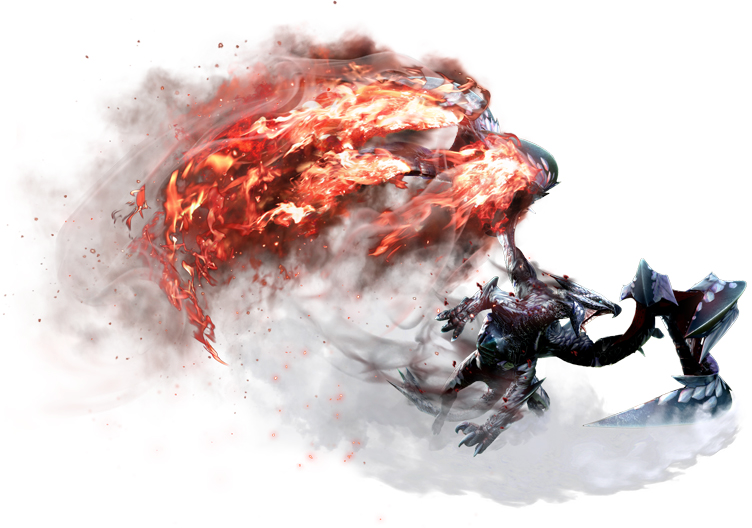
Valphalk
Huge dragon (elder), unaligned
- Armor Class 17 (natural armor)
- Hit Points 189 (18d12+72)
- Speed 40 ft., fly 90 ft.
STR DEX CON INT WIS CHA 19 (+4) 16 (+3) 18 (+4) 12 (+1) 10 (+0) 10 (+0)
- Skills Acrobatics +8, Perception +10
- Senses passive Perception 20
- Languages -
- Challenge 16 (15,000 xp)
Brutal Wings. The valphalk deals one extra die of its damage when the valphalk hits with its wing attack (included in the attack).
Legendary Resistance (2/Day). If the valphalk fails a saving throw, it can choose to succeed instead.
Actions
Multiattack. The valphalk makes five attacks: one bite attack, two claw attacks, and two wing attack.
Bite. Melee Weapon Attack. +9 to hit, reach 10 ft., one target. Hit 13 (2d8 + 4) piercing damage.
Claw. Melee Weapon Attack. +9 to hit, reach 5 ft., one target. Hit 11 (2d6 + 4) piercing damage.
Wing. Melee Weapon Attack. +9 to hit, reach 15 ft., one target. Hit 22 (4d8 + 4) piercing damage.
Firebolt. Range Weapon Attack. +8 to hit, reach 80/320 ft., one target. Hit 14 (4d6) fire damage.
Ignition (recharge 5-6). The valphalk spread its wings out around itself and ignites them. Fire spreads out from the wings in a 20-foot radius around the valphalk. Each creature in that area must make a DC 17 Dexterity saving throw, taking 41 (9d8) fire damage on a failed save or half as much on a successful one.
Legendary Actions
The valphalk can take 3 legendary actions, choosing from the options below. Only one legendary action option can be used at a time and only at the end of another creatures turn. The valphalk regains spent legendary actions at the start of its turn.
Detect. The valphalk makes a Wisdom (Perception) Check.
Attack. The valphalk makes a firebolt attack.
Dragon Rush (Costs 2 Actions). The valphalk moves up to half its fly speed in a straight line, during this move it may move through other creatures without provoking attacks of opportunity. Any creatures the valphalk moves through must succeed on a DC 17 Dexterity saving throw or take 22 (4d8+4) slashing damage plus 10 (3d6) fire damage and are knocked prone on a failed save. On a successful save, the target takes half damage and is not knocked prone.
Amatsumagatsuchi (Amatsu)
The Amatsumagatsuchi, Amatsu for short, have a unique body structure. The head itself is quite small, though it is adorned with massive golden horns, flanked by tendrils of flesh. Amatsu's body is largely pale white in color, and covered entirely in fins that stretch along all four limbs. From its back rise more pointed fins, whereas its underside is grey and scaled. because it flies through the air and spends no time on land, Amatsu has almost vestigial feet and small, nearly useless back legs. The front legs are bordered by more white fins. When angered, red veins stand out more prominently in its wing membranes, and when near death, its chest, horns and eyes shine with a faint golden luminescence.
The average size of an Amatsu is 3133.8cm. The Amatsu has a large number of fins and wings along its body, which contribute to its ability to fly smoothly through the air. Its horns are large compared to the size of its head, much closer to the size of the fins. These horns show that nothing will attack Amatsu due to its sheer power. Its forearms are long, they are slender and designed for flight, not for walking. The amount of webbing in its fins and wings makes the Amatsu seem larger than it actually is, as they billow out in the wind. Its actual body structure is very close to a Leviathan, long and curvy, with small back legs and a fairly large tail. Its control over storms surpasses even that of Kushala Daora, this power comes from a unique jade colored organ called the "Storm Vesicle".
This organ stores large amounts of water and is how Amatsu is able to produce its terrifying storms. Unlike Kushala Daora, its wind aura does not protect it from attacks; instead, it seems to be used more aggressively as a way of making its charging attacks more dangerous. Its most deadly form of attack is a massive beam of wind and water fired from its mouth; when the beam hits the ground, it releases a torrent of water on anything nearby the point of impact. Once a Amatsu dies, the storm it made will dissipate within seconds. Showing this unique hard jade colored organ has great power.
Living mainly in the sky and mountain tops, the Amatsu is a mainly passive Elder Dragon, but the frequency that it creates storms is dependent on its mood. It does not take kindly to anything invading its airspace, as shown when it shoots down an airship on a discovery mission. When truly angered, it does not calm down easily. It is also known to take claim of a resting ground for its territory going as far as chasing out predators as powerful as groups of Zinogre if it wants their home as its own.
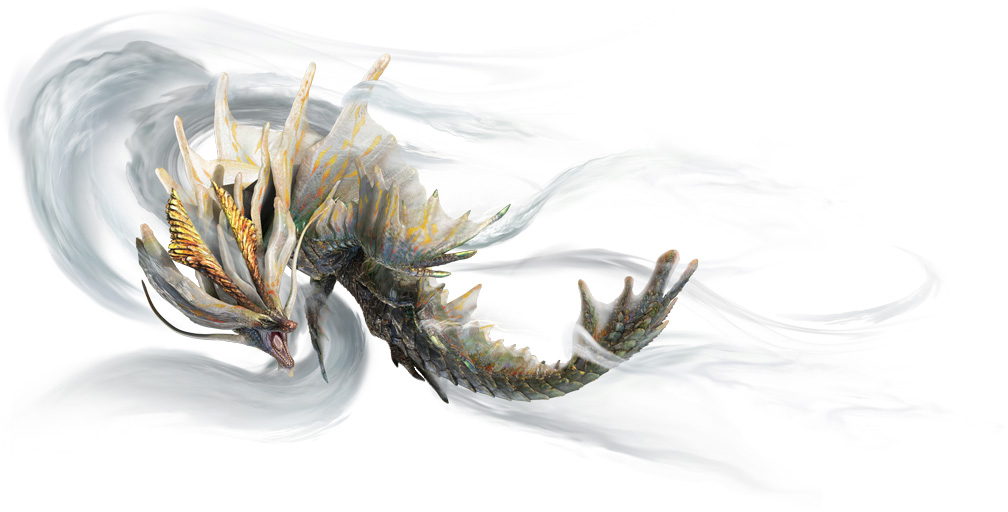
Amatsumagatsuchi
Gargantuan dragon (elder), unaligned
- Armor Class 17 (natural armor)
- Hit Points 181 (11d20+66)
- Speed 0 ft., fly 60 ft. (hover)
STR DEX CON INT WIS CHA 23 (+6) 10 (+0) 23 (+6) 16 (+3) 15 (+2) 17 (+3)
- Saving Throws Dex +6, Con +12, Wis +8, Cha +9
- Skills Acrobatics +6, Perception +8
- Damage Immunities radiant
- Condition Immunities charmed, exhaustion, frightened, prone
- Senses blindsight 60 ft., darkvision 120 ft., passive Perception 18
- Languages Draconic, Primordial
- Challenge 17 (18,000 xp)
Legendary Resistance (2/Day). If the amatsu fails a saving throw, it can choose to succeed instead.
Wind Barrier. A barrier of strong wind surrounds the amatsu in a 10-foot radius around it. The strong wind keeps fog, smoke, and other gases at bay. Small or smaller flying creatures or Objects can't pass through the barrier. Loose, lightweight materials brought into the barrier fly upward. Arrows, bolts, and other ordinary projectiles launched at the amatsu are deflected upward and automatically miss. (Magic arrows, boulders hurled by Giants or siege engines, and similar projectiles, are unaffected.) Creatures in Gaseous Form can't pass through the barrier.
Suppressed Power. The amatsu is unable to use its Grand Vortex Beam while it is above (90) half of its maximum hit points .
Actions
Multiattack. The amatsu makes one tail attack and one bite attack. It can replace any of these attacks with a water beam attack.
Bite. Melee Weapon Attack. +12 to hit, reach 15 ft., one target. Hit 19 (3d8 + 6) piercing damage.
Tail. Melee Weapon Attack. +12 to hit, reach 20 ft., one target. Hit 28 (4d10 + 6) bludgeoning damage. On hit, the target must make a DC 21 Strength saving throw or be knocked prone.
Water Beam. Range Weapon Attack. +6 to hit, reach 150/600 ft., one target. Hit 23 (5d8) cold damage.
Wind Vortex (recharge 5-6). The amatsu conjures an swirling vortex of hurricane winds centered on its self. Each creature within 100 feet of the amatsu must make a DC 20 Strength saving throw or are pulled 30 feet towards the amatsu. A creature that is pulled within 30 feet of the amatsu or is already within that range must make a DC 20 Strength saving throw or be thrown 130 feet straight up into the air on a failed save, or half as high on successful one. If a thrown target strikes a solid surface upon landing, the target takes 3 (1d6) bludgeoning damage for every 10 feet it fell.
Grand Vortex Beam (recharge 6). The amatsu exhales three high pressure beams of water in different directions in front of it. Each beam is a 60-foot line that is 5 feet wide. Each creature in a line must make a DC 20 Dexterity saving throw, taking 82 (15d10) cold damage on a failed save, or half as much damage on a successful one.
Control Weather (1/day). The amatsu can alter the weather in a 6-mile radius centered on it. The amatsu doesn't need to be outdoors; otherwise the effect is identical to the control weather spell.
Legendary Actions
The amatsu can take 3 legendary actions, choosing from the options below. Only one legendary action option can be used at a time and only at the end of another creatures turn. The amatsu regains spent legendary actions at the start of its turn.
Detect. The amatsu makes a Wisdom (Perception) Check.
Bite Attack. The amatsu makes a bite attack.
Whirlwind (Costs 3 Actions). The amatsu chooses 3 unoccupied 5-foot cube within 5 feet of it. An elemental force that resembles a dust devil appears in the cubes and they move in a straight line 60 feet away from the amatsu before dispersing. Each creature in one of the lines must make a DC 20 Strength saving throw, taking 18 (4d8) force damage on a failed save or half as much on a successful one.
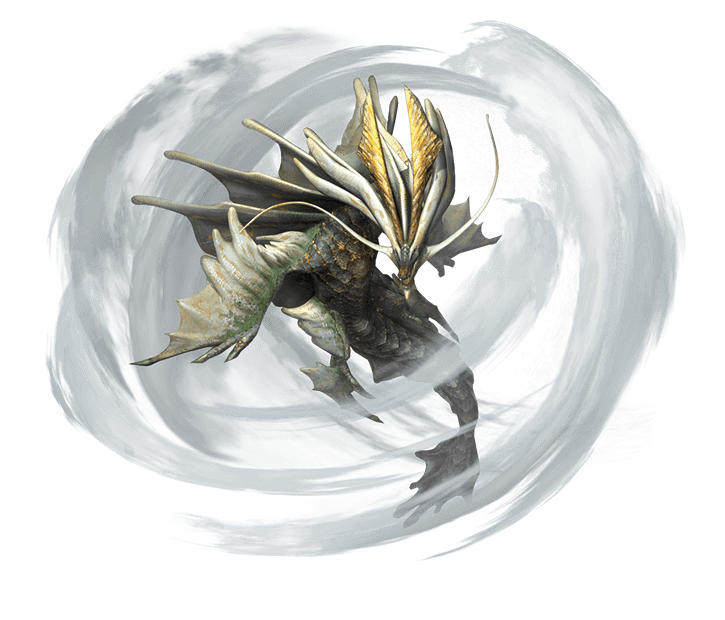
Dalamadur
The Dalamadur has a snake-like face, with bright red eyes, numerous fangs, and many hook-like spikes along its body which start out clustered around its head and neck, and becoming more spread out along its long body, with a small cluster near the tip of its tail, which is topped with a pair of red barbs that it can rattle in a manner similar to rattlesnakes. Its has a pair of large clawed forearms, but the only remnant of hind legs it has are small spurs, similar to anacondas. Its chest has glowing vents, which huff steam. Its face and tail will also glow red when in its Raged state.
Dalamadur are quite aggressive in nature, willing to destroy adventurers at all cost. Dalamadur can easily destroy whole mountains with their coils and cause pieces of rumble to fall from them. For unknown reasons, large numbers of Dalamadur are known to raise from underground during certain times of the year.
Dalamadur
Gargantuan dragon (elder), unaligned
- Armor Class 18 (natural armor)
- Hit Points 201 (13d20 + 65)
- Speed 60 ft., burrow 60 ft., climb 60 ft.
STR DEX CON INT WIS CHA 18 (+4) 24 (+7) 21 (+5) 18 (+4) 14 (+2) 14 (+2)
- Saving Throws Wis +8 Cha +8
- Skills Perception +14, Stealth +13
- Damage Resistances fire, poison
- Condition Immunities charmed, frightened, paralyzed
- Senses truesight 120 ft., passive Perception 24
- Languages Common, Draconic, Sylvan, Telepathy 120 ft.
- Challenge 18 (20,000 xp)
Legendary Resistance (3/Day). If the dalamadur fails a saving throw, it can choose to succeed instead.
Siege Monster. The dalamadur deals double damage to objects and structures.
Actions
Multiattack. The dalamadur can use its frightful presence. It then makes two attacks: one with its bite and one with its tail. It can't make both attacks against the same target.
Bite. Melee Weapon Attack. +13 to hit, reach 15 ft., one target. Hit 29 (4d10 + 7) piercing damage, and the target must make a DC 19 Constitution saving throw, taking 14 (4d6) poison damage on a failed save, or half as much damage on a successful one.
Tail. Melee Weapon Attack. +13 to hit, reach 25 ft., one target. Hit 25 (4d8 + 7) piercing damage.
Constrict. Melee Weapon Attack: +10 to hit, reach 10 ft., one creature. Hit: 18 (4d6 + 4) bludgeoning damage, and the target is grappled (escape DC 18). Until this grapple ends, the creature is restrained, and the dalamadur can't constrict another target.
Frightful Presence. Each creature of the dalamadur's choice that is within 120 feet of the dalamadur and aware of it must succeed on a DC 16 Wisdom saving throw or become frightened for 1 minute. A creature can repeat the saving throw at the end of each of its turns, ending the effect on itself on a success. If a creature's saving throw is successful or the effect ends for it, the creature is immune to the dalamadur's Frightful Presence for the next 24 hours.
Rattle. Using the hypnotic sounds from the rattle on its tail, the dalamadur chooses one humanoid it can see within 30 feet of it must succeed on a DC 16 Wisdom saving throw or be magically charmed for 1 day. The charmed target obeys the dalamadur's spoken and telepathic commands. If the target suffers any harm from the dalamadur or another creature or receives a suicidal command from the dalamadur, the target can repeat the saving throw, ending the effect on itself on a success. If a target's saving throw is successful, or if the effect ends for it, the creature is immune to the dalamadur's Fiendish Charm for the next 24 hours. A creature that is Deafened is immune to this effect.
Fire Breath (Recharge 5-6). The dalamadur exhales fire in a 90-foot cone. Each creature in that area must make a DC 19 Dexterity saving throw, taking 59 (17d6) fire damage on a failed save, or half as much damage on a successful one.
Legendary Actions
The dalamadur can take 3 legendary actions, choosing from the options below. Only one legendary action option can be used at a time and only at the end of another creatures turn. The dalamadur regains spent legendary actions at the start of its turn.
Squeeze. The dalamadur makes a Constrict attack.
Rattle (Costs 2 Actions). The dalamadur uses its Rattle.
Meteor (Costs 3 Actions). The dalamadur opens its mouth and magically creates three swirling balls of blue fire, launching them into the sky, each of which can strike a different target the dalamadur can see within 120 feet of it. A target must make a DC 21 Dexterity saving throw, taking 18 (4d8) lightning damage on a failed save, or half as much damage on a successful one.
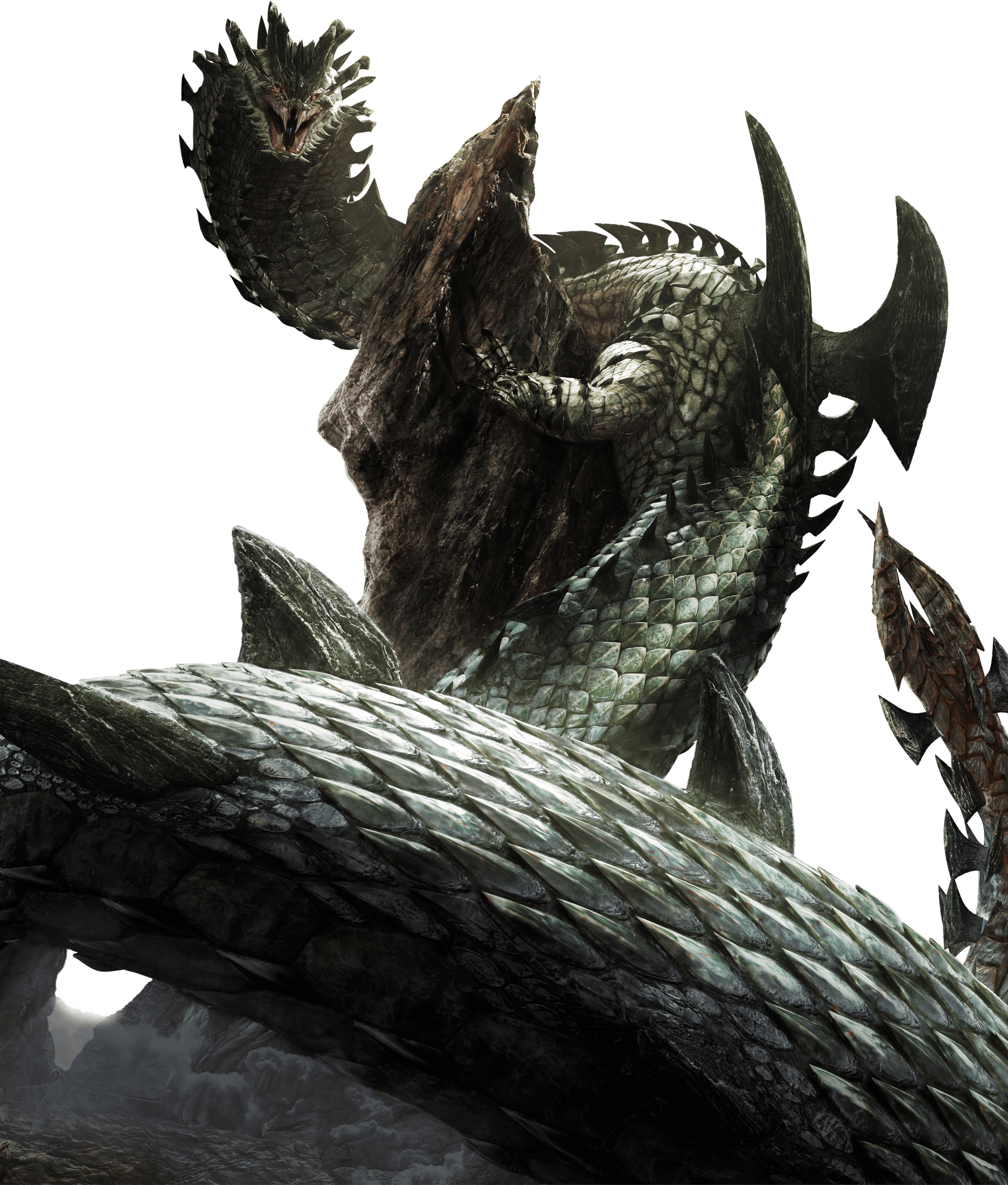
Yama Tsukami
Yama Tsukami is an unusual Elder Dragon with an octopus-like body. It is covered in moss, algae, and other plant life, and boasts a set of four thick tentacles. In addition, it possesses two large whiskers and an oddly human-like set of teeth and gums. It produces gas within its body in order to keep itself afloat.
Yama Tsukami are constantly traveling through different areas in order to find suitable fertile land for them to feed on, even traveling over vast seas. Yama Tsukami is a dangerous monster that can potentially swallow a whole village or town. However it is believed that the winds in environments can send Yama Tsukami unintentionally into some areas so it might not intentionally be heading to attack towns. Though, most heavily forested areas are most at risk of getting eaten by a Yama Tsukami. Strangely around parts of a Great Forest, Yama Tsukami of different colors and sizes have been seen. Its theorized that they are either adults and juveniles, subspecies, or just environmental conditions. Most believe that it is due to environmental conditions that there are many different Yama Tsukami.
Yama Tsukami's most notable adoption is its ability to float with no obvious method of propulsion. From the large amounts of dirt and rotting flesh that a Yama Tsukami has swallowed, it all produces a gas inside its body that allows it to float in the air without wings. It is able to control the amount of gas it uses and able to use it as a rudder as it floats in the air. It can even use the gas as a weapon and as a defensive shield. Despite being able to control it, Yama Tsukami can be knocked out the air if enough damage is done to it and even by crashing into the ground randomly. The creature has four large tentacles that may serve as multipurpose appendages. These tentacles are light yet very slimy It could use these to snare prey, uproot plants, or anchor itself to landmasses or trees. At the end of these tentacles, there seem to be claws. It also uses them like whips when defending itself, crushing anything that tries to challenge it. Yama Tsukami also has a pair of large whiskers, which it uses as tentacles as well. Yama Tsukami has the parasitic Dragonwood and the mysterious Dragonmoss growing from its back along with trees and many different plants. The exact cause of this is its feeding on forest and on lakes along with its blood which is the nutrients for many different species of plants. Due to this, Yama Tsukami have become a "special" environment for some living things such as the Great Thunderbug. Sometimes as it eats whole forests and lakes, Yama Tsukami will also suck up or eat Great Thunderbugs that are caught in its mouth. From the Yama Tsukami being a "special" environment for them, they become quite different from the normal Great Thunderbugs and develop differently compared to them. They even seem to develop a bond with Yama Tsukami and will defend it from any potential threats. Yama Tsukami have incredibly long lifespans numbering in the thousands of years.
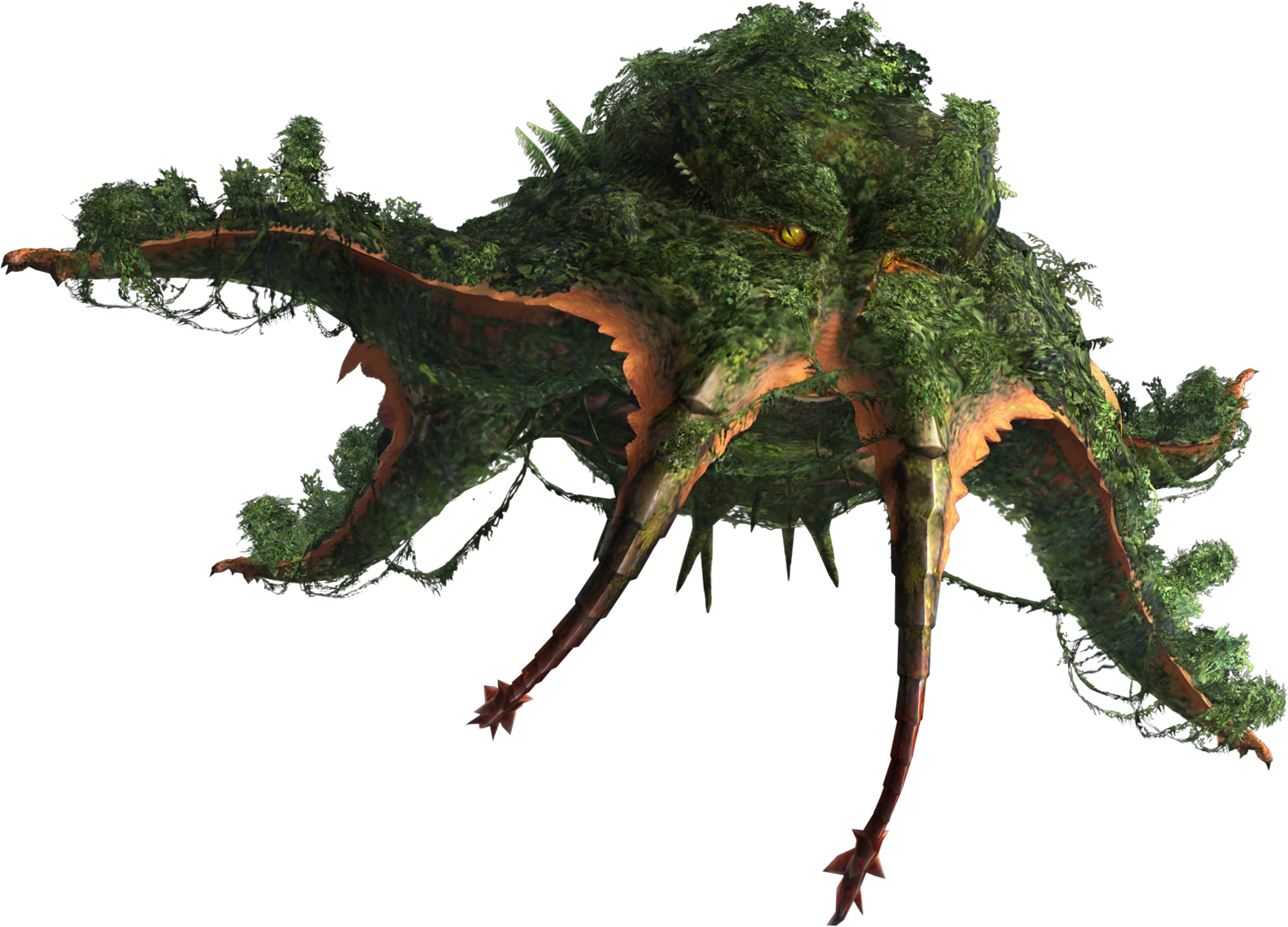
Yama Tsukami
Gargantuan monstrosity (Elder), unaligned
- Armor Class 17 (natural armor)
- Hit Points 264 (16d20+96)
- Speed 10 ft., fly 60ft. (hover)
STR DEX CON INT WIS CHA 28 (+8) 10 (+0) 23 (+6) 15 (+2) 16 (+3) 10 (+0)
- Saving Throws Str +14, Dex +6, Con, +12, Wis +9
- Damage Immunities lightning
- Condition Immunities charmed, frightened, paralysis, prone
- Senses truesight 120 Ft., passive Perception 13
- Languages Primordial but can't speak, telepathy 120 ft.
- Challenge 18 (10,000 xp)
Freedom of Movement. The yama tsukami ignores difficult terrain, and magical effects can't reduce its speed or cause it to be Restrained. It can spend 5 feet of Movement to escape from nonmagical restraints or being Grappled.
Siege Monster. The yama tsukami deals double damage to Objects and structures.
Actions
Multiattack. The yama tsukami makes three tentacle attacks, each of which it can replace with one use of Fling.
Tentacle. Melee Weapon Attack. +14 to hit, reach 20ft., one target. Hit 18 (3d6 + 8) bludgeoning damage, and the target is Grappled (escape DC 18). Until this grapple ends, the target is Restrained. The yama tsukami has six tentacles, each of which can grapple one target.
Fling. One Large or smaller object held or creature Grappled by the yama tsukami is Thrown up to 60 feet in a random direction and knocked prone. If a Thrown target strikes a solid surface, the target takes 3 (1d6) bludgeoning damage for every 10 feet it was Thrown. If the target is Thrown at another creature, that creature must succeed on a DC 18 Dexterity saving throw or take the same damage and be knocked prone.
Bite. Melee Weapon Attack. +14 to hit, reach 5 ft., one target. Hit 21 (3d8 + 8) piercing damage. If the target is a Large or smaller creature Grappled by the yama tsukami, that creature is swallowed, and the grapple ends. While swallowed, the creature is Blinded and Restrained, it has total cover against attacks and other effects outside the yama tsukami, and it takes 42 (12d6) acid damage at the start of each of the yama tsukami's turns. If the yama tsukami takes 40 damage or more on a single turn from a creature inside it, the yama tsukami must succeed on a DC 20 Constitution saving throw at the end of that turn or regurgitate all swallowed creatures, which fall prone in a space within 10 feet of the yama tsukami. If the yama tsukami dies, a swallowed creature is no longer Restrained by it and can escape from the corpse using 15 feet of Movement, exiting prone.
Summon Great Thunderbugs (recharge 6). The yama tsukami releases 6 (1d10) great thunderbugs from its mouth that occupy a space within 20 feet of the yama tsukami.
When a great thunderbug summoned by the yama tsukami dies, it explodes in a burst of lightning. Each creature within 10 feet of it must make a DC 13 Dexterity saving throw, taking 7 (2d6) lightning damage on a failed save, or half as much damage on a successful one.Fire Plume (recharge 5-6). The yama tsukami releases a plume of fire from its underside in a 30-foot radius around it. Each creature in that area must make a DC 20 Dexterity saving throw, taking 28 (8d6) fire damage on a failed save or half as much on a successful one.
Legendary Actions
The yama tsukami can take 3 legendary actions, choosing from the options below. Only one legendary action option can be used at a time and only at the end of another creatures turn. The yama tsukami regains spent legendary actions at the start of its turn.
Summon Great Thunderbugs or Fire Plume. The yama tsukami uses its Summon Great Thunderbugs or Fire Plume.
Tentacle Attack or Fling. The yama tsukami makes a tentacle Attack or uses its Fling.
Whirlwind (Costs 2 Actions). The yama tsukami extends out all of its tentacles and spins in circles. Each creature within a 20 foot radius of the yama tsukami must succeed on a DC 18 Dexterity saving throw, taking 22 (4d10) bludgeoning damage and are knocked prone on a failed save.
Gogmazios
Gogmazios is a massive Elder Dragon with a body structure similar in nature to that of Gore Magala and Shagaru Magala. It has a large, heavy head with red eyes and rows of sharp teeth. When it uses its Oil laser attack, a glowing pattern, reminiscent of a scowl, is present beneath its chin, giving it the semblance of a second face. Its wingarms feature membranes that almost completely retract when not in use, and its body is covered in thick, powerful scales, carapaces, and spines of an indigo colouration. Perhaps the most notable features of Gogmazios body are the ever-present covering of a sticky, tar-like substance which it uses to incapacitate prey. It is unknown where Gogmazios exactly lives but it is theorized by scholars that it comes from swamps along with some mountainous habitats.
Despite Gogmazios habitat being unknown, Gogmazios are known to feed sulfur, which can be found in gunpowder and explosives. This was discovered after one raided Dundroma's Weapon Warehouse for many years and was seen feeding on the explosives. From this it can be assumed that Gogmazios may also feed on ore though Gogmazios hasn't been seen interacting with other monsters so this is just a hypothesis by scholars.
Gogmazios aren't the most aggressive Elder Dragons, but certainly aren't harmless and will attack if threatened. Gogmazios are known to hibernate underground for a very long period of time, spanning to a few years or even several decades, when it has obtained enough food, but waking up to feed again when food is needed. This plus it destroying some villages while searching for food is the reason why it hasn't been seen very much by people.
An adult Gogmazios is approximately 4920.5cm long and standing at a height at about 1708.5cm. Unlike most other Elder Dragons, Gogmazios has an extra pair of limbs that allow it to walk better and allow it to walk upright. From the large amounts of muscles found inside these limbs, Gogmazios is able to walk upright with very much ease and to battle some threats at close range. These extra pair of limbs even allow Gogmazios to fly with its powerful wings. The wings of Gogmazios aren't tattered. The oil on its body has actually stuck the wings to its arms due to it hardening. When greatly angered, the heat will cause the oil to evaporate from its wings and Gogmazios forces itself in the air to fly. Gogmazios don't fly easily and rarely ever fly. Gogmazios has oil circulating throughout its body, while some of the oil pours out of its body. The oil coming out of a Gogmazios is impurities, such as waste or sweat, from its skin due to its diet. The oil pours out from its chest and back, dripping onto the ground below it. This oil is very sticky, attaching to anything that it touches. Inside some of the oil is objects that were picked up by Gogmazios accidentally. These objects can be weapons, artifacts, arrows, and living organisms. Some of the oil has hardened on Gogmazios body, increasing the strength of its scales and shell, giving it better defense against potential threats. Also, found inside of its body and inside its extra limbs are special organs that allow it to produce heated fire. Gogmazios uses this fire as a tool to ignite the oil and to make its attacks deadlier than before. When greatly enraged, Gogmazios's body temperature will increase greatly, making the oil it produces ignite faster and heat up faster without much warning.
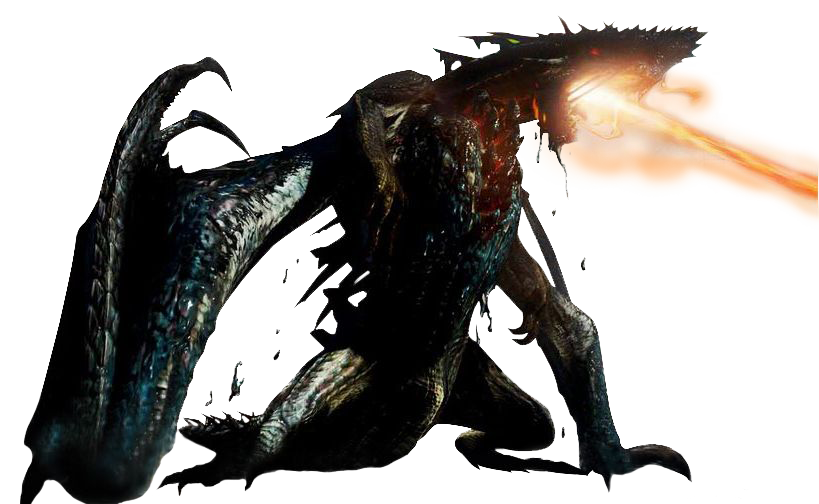
Condition: Tarred
A creature, object, or area who is tarred is covered in a dark brown or black viscous liquid. This liquid sticks to anything it touches and is highly flammable.
- A creature who is tarred is restrained, immune to being disarmed, and cannot use an object or weapon not already in hand.
- A tarred Object cannot be moved or used.
- An area that is tarred is considered difficult terrain.
- The condition ends if a creature, object, or area that has this condition takes fire damage. When the condition ends in this way the creature, object, or area ignite. Until a creature takes an action to douse the fire , the target takes 5 (1d10) fire damage at the start of each of its turns.
- When an area ignites, any object or creature in that area also ignite.
- An area that ignites in this way burns for 1 minute.
Gogmazios
Gargantuan dragon (elder), unaligned
- Armor Class 20 (natural armor)
- Hit Points 264 (16d20 + 96)
- Speed 40 ft., fly 80 ft.
STR DEX CON INT WIS CHA 23 (+6) 10 (+0) 22 (+6) 10 (+0) 16 (+3) 14 (+2)
- Saving Throws Dex +6, Wis +9, Cha +8
- Damage Resistances fire
- Senses darkvision 120 ft., passive Perception 13
- Languages -
- Challenge 19 (22,000 xp)
Legendary Resistance (2/Day). If the gogmazios fails a saving throw, it can choose to succeed instead.
Pitch. The gogmazios secretes tar from its body like sweat. Every 10 feet the gogmazios moves, it leaves tar in a unoccupied 5-foot area. Each creature in that enters the area or starts its turn in that area must make a DC 19 Strength saving throw, or become tarred.
Combustible. A creature with the tarred condition takes an additional 11 (2d10) fire damage if the tarred condition ends from taking fire damage.
Actions
Multiattack. The gogmazios can use its Frightful Presence. It then makes three attacks: one with its tail and two with its claws. It can't make a tail attack against the same target it used its claw attacks on.
Claw. Melee Weapon Attack. +12 to hit, reach 10 ft., one target. Hit 13 (2d6 + 6) slashing damage plus 5 (1d10) fire damage.
Tail. Melee Weapon Attack. +12 to hit, reach 15 ft., one target. Hit 24 (4d8 + 6) bludgeoning damage. and the target is tarred (escape DC 20).
Frightful Presence. Each creature of the gogmazios's choice that is within 120 feet of the gogmazios and aware of it must succeed on a DC 19 Wisdom saving throw or become frightened for 1 minute. A creature can repeat the saving throw at the end of each of its turns, ending the effect on itself on a success. If a creature's saving throw is successful or the effect ends for it, the creature is immune to the gogmazios's Frightful Presence for the next 24 hours.
Breath Weapons (Recharge 5-6). The gogmazios uses one of the following breath weapons:
- Fire Breath. The gogmazios exhales fire in a 90-foot line that is 5-feet wide. Each creature in that area must make a DC 20 Dexterity saving throw, taking 55 (10d10) fire damage on a failed save, or half as much damage on a successful one.
- Oil Breath. The gogmazios exhales tar in a 90-foot cone. That area becomes tarred for one hour. Each creature in that enters the area or starts its turn in that area must make a DC 20 Strength saving throw, or become tarred.
Legendary Actions
The gogmazios can take 3 legendary actions, choosing from the options below. Only one legendary action option can be used at a time and only at the end of another creatures turn. The gogmazios regains spent legendary actions at the start of its turn.
Detect. The gogmazios makes a Wisdom (Perception) check.
Tail Attack. The gogmazios makes a tail attack.
Wing Attack (Costs 2 Actions). The gogmazios beats its wings. Each creature within 15 feet of the gogmazios must succeed on a DC 21 Dexterity saving throw or take 20 (4d6 + 6) bludgeoning damage and be knocked prone. The gogmazios can then fly up to half its flying speed.
Nakarkos
Nakarkos are massive cephalopod-like monsters. They have glowing yellow eyes, and massive, sharp beaks. They have blue skin with spots of turquoise bioluminescence. The most unique feature of a Nakarkos body is its self-made covering of bones which it uses to protect and camouflage itself. Under normal circumstances, the Nakarkos face cannot be seen. Its two primary tentacles are covered in vertebrae and tipped with skulls, creating the appearance of a two-headed skeletal dragon. Nakarkos have been reported in many different regions by eyewitnesses, though Nakarkos are known to make huge bone-covered lairs in caves. These lairs are known as Wyvern's End. Nakarkos are also known to be found in the sea.
Nakarkos easily assert themselves as top predators, no matter what the environment is. These Elder Dragons have been identified feeding on the armored prey, such as Uragaan and Diablos, and even top predators like Glavenus, Brachydios, and Agnaktor. Even monster species capable of flight aren't safe from this monster. The most shocking creatures these Elder Dragons have been found to take down are Shen Gaoren and Ceadeus pups. Other prey includes Hermitaur and Daimyo Hermitaur. The only real likely things that could potentially threaten a Nakarkos are other Elder Dragons like older Ceadeus, their only known predator.
Nakarkos are gluttons that can eat a whole ecosystem if left unchecked. Due to Nakarkos having huge appetites, they can easily wipe out all life in surrounding areas. Nakarkos have even been reported shooting down airships for food. Though Nakarkos can destroy an ecosystem, it doesn't actually want to do that. It prefers to leave its nest in search of prey so, it still have plenty of food at the environment it is living within. If the adventurer's Guild finds a Nakarkos' lair, they will immediately send adventurer to repel it before it can bring further damage to that ecosystem. However, it is said that Nakarkos will eventually return to said area in order to feed themselves further.
Nakarkos is able to produce an eerie, blue mucus from its body. This mucus is sticky, allowing it to capture prey and even shoot prey items out of the air. Though this mucus is used for capturing prey, Nakarkos has another use for the mucus. This mucus is used to help prevent bones from corroding, sticking bones together, and to prevent the bones from collapsing. With this mucus, it can make a protective bone armor to protect its whole body from attacks and even use some bones as weapons. Like a cuttlefish, it has sticky tentacles used to drag prey back to its lair. These tentacles are usually covered in bones for protection, ending with a huge skull. But this isn't just limited to skulls. Nakarkos has been seen using various monster parts to attack foes or to kill prey with. Some of these parts are hard to identify due to Nakarkos altering their shapes in order for it to use them. Some parts that it has been seen using is a fused together Glavenus jaw and tail, a Lagiacrus shell shockers, a Brachydios pounders, and a Uragaan's chin.
These various parts give the appearance that it has "two heads" but Nakarkos's true head is hidden away underground most of the time. When it feels its life is truly in danger, it will eventually reveal its true face. Its true face is cephalopod-like, resembling a cuttlefish. By revealing its face, it can use its bone-crunching beak. So to make it easier for itself to use the Fire Beam, it will fire the element from its tentacles and build it up in its mouth before firing a massive beam. To move quickly, Nakarkos has jet propulsion like squids. It uses this to return to its nest at a quicker rate, so it can avoid getting eaten itself.
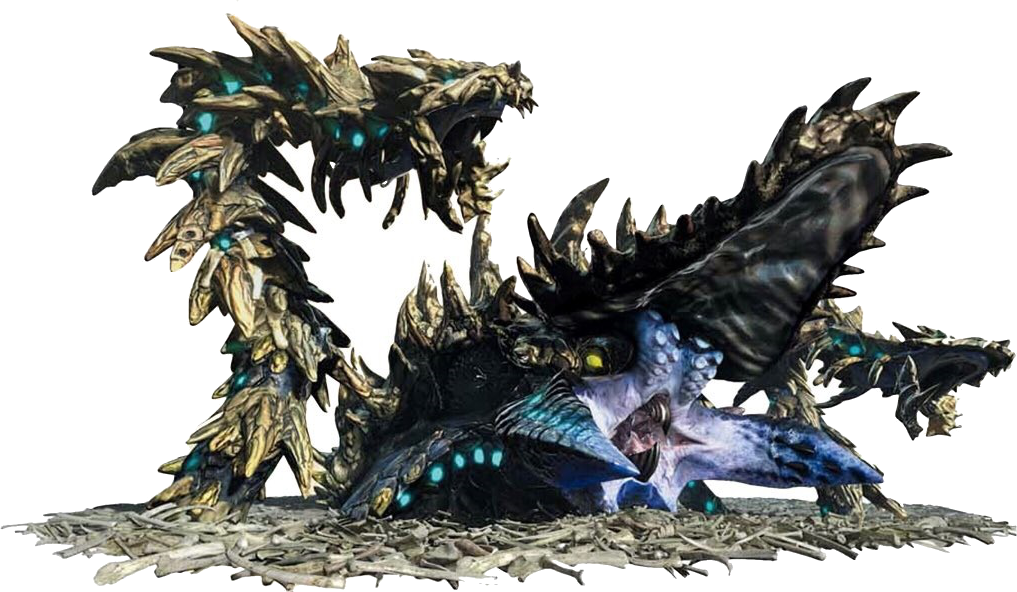
Nakarkos
Huge dragon (elder), Chaotic Evil
- Armor Class 22 (Dragon Bone)
- Hit Points 232 (16d12 + 128)
- Speed 40 ft., burrow 30 ft.
STR DEX CON INT WIS CHA 24 (+7) 14 (+2) 27 (+8) 12 (+1) 18 (+4) 16 (+3)
- Saving Throws Dex +8, Wis +10, Cha +9
- Damage Resistances bludgeoning, piercing, and slashing damage from nonmagical weapons
- Senses blindsight 60 ft., darkvision 120 ft., tremorsense 120 ft., passive Perception 14
- Languages Draconic
- Challenge 20 (25,000 xp)
Legendary Resistance (3/Day). If the nakarkos fails a saving throw, it can choose to succeed instead.
Poison Aura. At the start of each of the nakarkos's turns, each creature within 5 feet of its body takes 11 (3d6) poison damage. A creature that touches the nakarkos body or hits it with a melee attack while within 5 feet of it takes 7 (2d6) poison damage.
Bone Tentacles. The nakarkos has two tentacles (Size: Large, AC 22, HP 30). Damaging a bone tentacle deals no damage to the nakarkos. When a bone tentacle reaches 0 hit points, it becomes a Broken Tentacle. As a bonus action, the tentacles retract underground and reappear in an unoccupied space within 15 feet of the nakarkos body.
Broken Tentacles. A broken tentacle has had the bones protecting it destroyed reducing its AC by 2. (Size: Large, AC 20). Damaging a broken tentacle deals damage to the nakarkos. At the end of the nakarkos turn, a broken tentacle retracts into the ground. It reappears at the start of the nakarkos next turn with the bones of a new creature, roll a d4 to determine what type of tentacle it becomes. On a 1, Lagiacrus Tentacle; On a 2, Galvenus Tentacle; On a 3, Uragaan Tentacle; On a 4, Brachydios Tentacle.
True Face. The Nakarkos is sunken into the ground, revealing only its body parts that are covered in dragon bone giving the appearance that it has "two heads" but nakarkos's true head is hidden away underground. When the nakarkos is below half of its maximum hit points (131), it will reveal its unprotected true face reducing its AC by 2 and replacing its multiattack and fire beam with:
- Multiattack. The nakarkos makes two tentacle attacks and one beak attack. it can replace its tentacle attack with a sticky mucus attack.
- Fire Beam (recharge 5-6). The nakarkos exhales a beam of fire in a 90-foot line that is 10-feet wide. Each creature in that line must make a DC 22 Dexterity saving throw, taking 50 (9d10) fire damage on a failed save, or half as much damage on a successful one.
Actions
Multiattack. The nakarkos makes two tentacle attacks. it can replace either of these attacks with a Sticky Mucus attack.
Sticky Mucus. Range Weapon Attack. +8 to hit, range 30/120 ft. from tentacles location, one target. Hit 17 (5d6) poison damage. On hit, the target is grappled by the mucus (escape DC 20).
Beak. Melee Weapon Attack: +13 to hit, reach 10 ft., one target. Hit 29 (4d10 + 7) piercing damage.
Fire Beam (recharge 5-6). The nakarkos tentacles releases two beams of fire, one from each tentacle. Each beam fires in a 45-foot line that is 5-feet wide. Each creature in either line must make a DC 22 Dexterity saving throw, taking 44 (8d10) fire damage on a failed save, or half as much damage on a successful one.
Tentacles. The nakarkos uses one of the following tentacle attacks depending on which bones they are using:
- Broken Tentacle. Melee Weapon Attack. +13 to hit, reach 10 ft., one target. Hit 17 (3d6+7) bludgeoning damage.
- Lagiacrus Tentacle. Melee Weapon Attack. +13 to hit, reach 10 ft., one target. Hit 21 (4d6+7) piercing damage plus 5 (1d10) lightning damage.
- Galvenus Tentacle. Melee Weapon Attack. +13 to hit, reach 10 ft., one target. Hit 21 (4d6+7) slashing damage plus 5 (1d10) fire damage.
- Uragaan Tentacle. Melee Weapon Attack. +13 to hit, reach 10 ft., one target. Hit 28 (6d6+7) bludgeoning damage.
- Brachydios Tentacle. Melee Weapon Attack. +13 to hit, reach 10 ft., one target. Hit 21 (4d6+7) bludgeoning damage and each creature within 5 feet of the target, including the target, must make a DC 20 Dexterity saving throw, taking 7 (2d6) fire damage on a failed save, or half as much on a successful one.
Legendary Actions
The nakarkos can take 3 legendary actions, choosing from the options below. Only one legendary action option can be used at a time and only at the end of another creatures turn. The nakarkos regains spent legendary actions at the start of its turn.
Mucus Ball. The nakarkos launches a ball of mucus from its back at a target. The target must make a DC 19 Dexterity saving throw or become restrained by the mucus (escape 20).
Tentacle Attack (Costs 2 Actions). The nakarkos makes a tentacle attack.
Trample (Costs 2 Actions). The nakarkos moves up to its speed, during this move it may move through other creatures without provoking attacks of opportunity. Any creatures the nakarkos moves through must succeed on a DC 20 Dexterity saving throw or take 16 (2d8 + 7) bludgeoning damage and be knocked prone.
Alatreon
Known as the Blazing Black Dragon, Alatreon possesses control over the Fire, Thunder, and Ice elements, and is said to be elementally unstable. In its scales are each of the three elements which it constantly produces, even when it is dead. However, it is unknown how its scales are able to harness the elements.On top of Alatreon's head are two large horns, these horns seem to play some part in Alatreon's control over the three elements, however, it is unknown to scholars if they actually do.
From Alatreon living isolated from all other monsters, it is hard to say where it fits in the ecological niche. Due to Alatreon living in the Sacred Land, it has changed the area into an inhospitable environment. No living things, including plants, can live in the area due to the constant weather changes that occur in the Sacred Land. Alatreon are monsters capable of destroying the world. Some locals even believe that the Alatreon is a god or demon which is transformed into an Elder Dragon. Many of Alatreon's abilities seem to be unnatural, much like the Fatalis, but not much else is really known about the Elder Dragon.
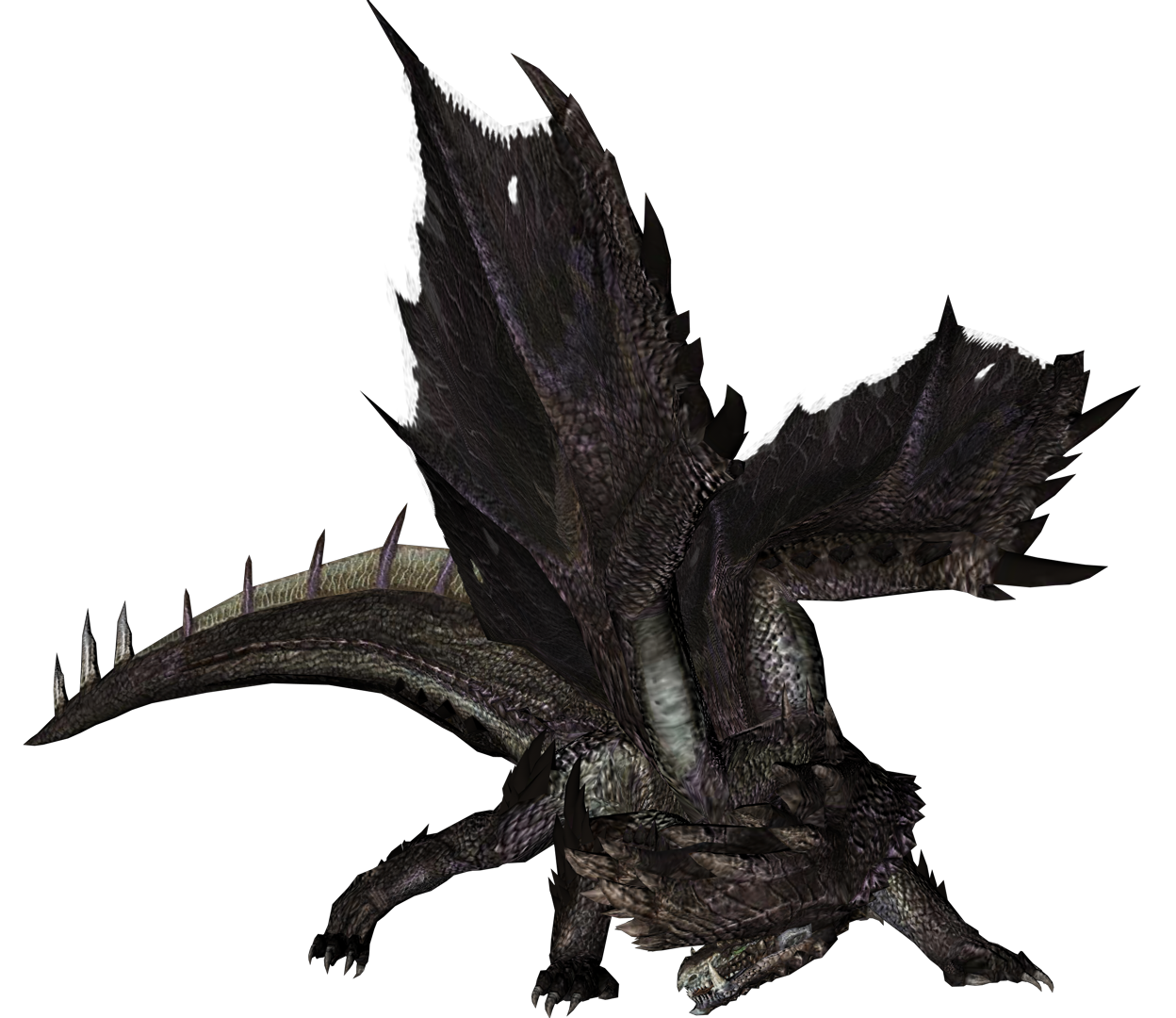
Alatreon
Huge dragon (elder), unaligned
- Armor Class 20 (natural armor)
- Hit Points 261 (18d12+144)
- Speed 60 ft., fly 60 ft.
STR DEX CON INT WIS CHA 27 (+8) 11 (+0) 26 (+8) 10 (+0) 15 (+2) 14 (+2)
- Saving Throws Dex +6, Con +12, Wis +8, Cha +8
- Skills Perception +14
- Condition Immunities charmed, frightened
- Senses blindsight 60 ft., darkvision 120ft., passive Perception 24
- Languages Draconic
- Challenge 21 (33,000 xp)
Legendary Resistance (3/Day). If the alatreon fails a saving throw, it can choose to succeed instead.
Actions
Multiattack. The alatreon makes three attacks; two claw attacks one bite or tail attack.
Bite. Melee Weapon Attack. +14 to hit, reach 15 ft., one target. Hit 22 (3d8 + 8) piercing damage. If the target is a large or smaller creature, it is grappled (escape DC 22). Until this grapple ends, the alatreon can't use its bite on another target.
Claws. Melee Weapon Attack. +14 to hit, reach 10ft., one target. Hit 19 (3d6 + 8) slashing damage.
Tail. Melee Weapon Attack. +14 to hit, reach 20ft., one target. Hit 22 (3d8 + 8) bludgeoning damage. On hit, the target must make a DC 22 Strength saving throw or be knocked prone.
Ice Storm. The alatreon magically creates a hail of rock-hard ice that pounds to the ground in a 20-foot-radius, 40-foot-high cylinder centered on a point within 120 feet of the alatreon. centered on a point within 150 feet. Each creature in the cylinder must make a DC 21 Dexterity saving throw. A creature takes 17 (3d10) bludgeoning damage and 17 (3d10) slashing damage on a failed save, or half as much damage on a successful one.
Lightning Storm. The alatreon magically creates three bolts of lightning, each of which can strike a target the alatreon can see within 120 feet of it. A target must make a DC 23 Dexterity saving throw, taking 22 (4d10) lightning damage on a failed save, or half as much damage on a successful one.
Flame Strike. The alatreon magically creates a vertical column of fire roars down from the heavens in a location you specify. Each creature in a 10-foot-radius, 40-foot-high cylinder centered on a point within 40 feet of the alatreon must make a DC 21 Dexterity saving throw, taking 41 (9d8) fire damage on a failed save, or half as much damage on a successful one.
Breath Weapons (Recharge 5-6). The alatreon uses one of the following breath weapons:
- Lightning Breath. The alatreon exhales lightning in a 120-foot line that is 10 feet wide. Each creature in that line must make a DC 22 Dexterity saving throw, taking 88 (16d10) lightning damage on a failed save, or half as much damage on a successful one.
- Cold Breath. The alatreon exhales an icy blast in a 90-foot cone. Each creature in that area must make a DC 22 Constitution saving throw, taking 72 (l6d8) cold damage on a failed save, or half as much damage on a successful one.
Legendary Actions
The alatreon can take 3 legendary actions, choosing from the options below. Only one legendary action option can be used at a time and only at the end of another creatures turn. The alatreon regains spent legendary actions at the start of its turn.
Attack. The alatreon makes a Bite attack.
Storm (Costs 2 Actions). The alatreon uses its Lightning Storm or Ice Storm.
Tail Sweep(Costs 3 Actions). The alatreon sweeps its tail and rises into the air. Each creature within 30 feet of the alatreon must succeed on a DC 20 Strength saving throw, taking 28 (5d10) bludgeonging damage and are knocked prone on a failed save. On a successful save the target takes half damage and isn't knocked prone. The alatreon can then rise 30 feet into the air.
Kulve Taroth
Kulve Taroth is an Elder Dragon that has a metallic coat that shines golden but is made up of a variety of metals and minerals that it uses to protect itself. It appears every so often to the surface and must be hunted quickly before it disappears into the depths of the earth again.
Kulve Taroth is unique among Elder Dragons in that does not interact with any monsters of any kind apart from the Gajalaka's that reside in the caves who mostly take pieces of her fallen metal coat for their own purposes. However considering her size, power, and speed it would be safe to assume she would be the top of the food chain along with most elder dragons. Curiously she seems to be utterly safe from the rabid hunger of the infamous Nergigante.
Even amongst Elder Dragons Kulve Taroth is a very passive aggressive monster, it will not attack until excessively provoked and once provoked it will not stop till it's aggressors are eliminated. Kulve Taroth once spotted will do all it can to escape conflict forcing hunters to retrack it again. Kulve Taroth has some displays of intelligence particularly when driven to a corner when she uses her breath to heat the ceilinig of caves to off-balance hunters.
The most strking trait of the Kulve is the metal coat which it wears like a royal robe fit for a queen. Kulve's body is covered by the same matierals that make up it's coat, which all shine a bright golden glow but is not gold itself. Another striking trait is Kulve's size, she is massive far larger than most elder dragons and is strong enough to carry her massive metal coat. Her horns are rather unique in that they must be broken twice the first time to get rid of the coating and the final time to remove the horns themselves. When removed of the coating they are a dazzling color of sapphire and emeralds. Kulve uses both her massive body and her coat as both a means of defense and attack, often diving down to ram her body against hunters while her coat allows her to attack in ranges she wouldn't normally be able to attack.
It's not until one removes her metal coat that we see the Kulve Taroth's true prowess, not only does she move much more nimbly but also more aggressively as well, using her horned head to ram and smash hunters with extreme agression. She also uses her breath more offensively heating up the floor and the ceiling to herd hunters into tight spaces to better smash them while they try to break her horns.
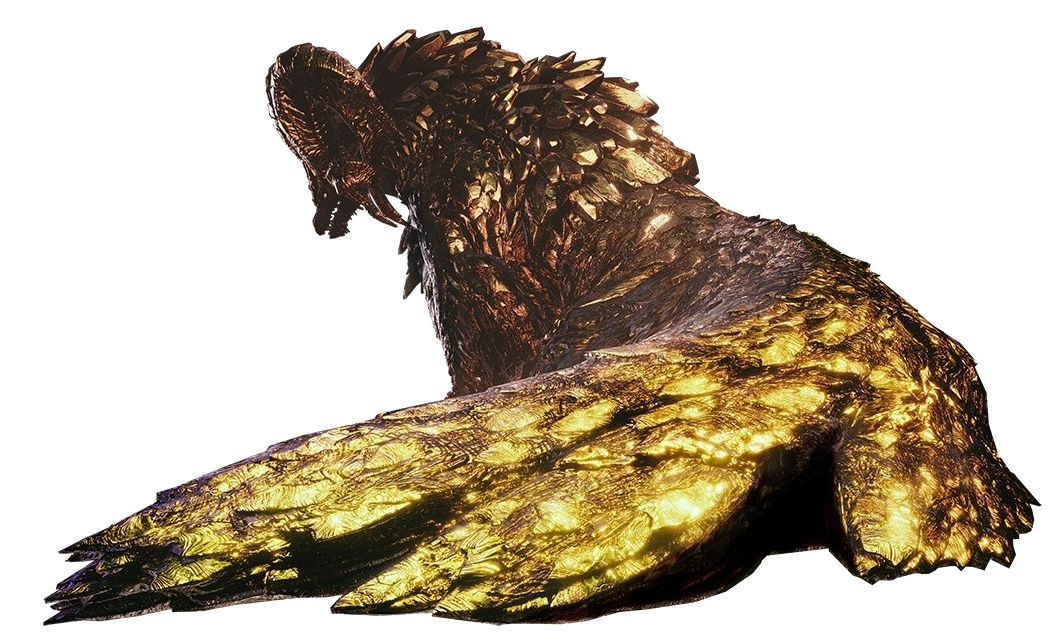
Kulve Taroth
Gargantuan beast (Elder), unaligned
- Armor Class 19 (22 with gold mantle)
- Hit Points 292/292/292 (15d20 + 135)
- Speed 60 ft. (40 ft with gold mantle)
STR DEX CON INT WIS CHA 27 (+8) 10 (+0) 29 (+9) 20 (+5) 21 (+5) 21 (+5)
- Saving Throws Str +15, Dex +7, Con +16, Wis +12
- Skills Perception + 12
- Damage Resistances cold; bludgeoning, piercing, and slashing from nonmagical attacks
- Damage Immunities fire
- Condition Immunities charmed, frightened, paralyzed, poisoned, stunned
- Senses darkvision 120 ft., passive Perception 22
- Languages Draconic
- Challenge 21 (33,000 XP)
Legendary Resistance (3/Day). If the kulve taroth fails a saving throw, it can choose to succeed instead.
Gold Mantle. The Kulve Taroth is covered in a gold plating While it remains intact, its AC is increased by 3 and its speed is reduced by 20 feet.
Magic Resistance. The kulve taroth has advantage on saving throws against spells and other magical effects.
Paragon Creature. The kulve taroth counts as a number of creatures equal to it's paragon multiplier (3) for the purposes of determining combat encounters. The XP value for a kulve taroth is multiplied by it's paragon multiplier.
Actions
Multiattack. The kulve taroth makes three attacks; one with its claw attack, one with its ram attack, and one with its tail attack.
Claw. Melee Weapon Attack: +15 to hit, reach 15 ft., one target. Hit: 25 (4d8 + 7) slashing damage.
Ram. Melee Weapon Attack: +15 to hit, reach 10 ft., one target. Hit: 33 (4d12 + 7) bludgeoning damage.
Tail. Melee Weapon Attack: +15 to hit, reach 20 ft., one target. Hit: 29 (4d10 + 7) bludgeoning damage and the target must make a DC 23 Strength saving throw or they are knocked prone.
Fireball. The kulve taroth exhales a fireball to a point within 120 feet of it. Each creature in a 20-foot radius Sphere centered on that point must make a DC 26 Dexterity saving throw. On a failed save, the creature takes 38 (11d6) fire damage, or half as much damage on a successful one.
Molten Gold Breath (recharge 5-6). The kulve taroth release a gout of molten gold across the ground in a 90 foot cone in front of it. Each creature in that area, that is touching the ground, must make a DC 26 Dexterity saving throw taking 67 (15d8) fire damage and begin to burn on a failed save. On a successful save, the target takes half as much damage and do not burn. A creature that is burning takes 6 (1d12) fire damage at the start of their turn. A creature can use its action on its turn to dose the flames.
Roll Over. The kulve taroth can move up to half its movement speed, without provoking an attack of opportunity, by rolling over and crushing anything in its path. Each creature in that area must make a DC 23 Dexterity saving throw, taking 45 (7d10+7) bludgeoning damage and are knocked prone on a failed save. On a successful save the creature takes half damage and is not knocked.
Paragon Trait
Paragon Fortitude. The kulve taroth has multiple pools of hit points, each which is tracked separately. Damage and healing only applies to the current hit point pool. When a pool is depleted of all hit points, it becomes inactive. When this happens, the kulve taroth immediately saves against all ongoing conditions and effects. If all hit point pools are inactive, the kulve taroth dies. When it takes a long rest, the kulve taroth heals all hit points in the current pool and fully heals one depleted hit point pool.
Paragon Fury. The kulve taroth rolls initiative with advantage. The kulve taroth starts with 0 paragon actions. If a hit point pool is depleted, the kulve taroth gains one additional paragon action. The kulve taroth may use a paragon action after any other creature takes a turn. If the kulve taroth does so, they regain their reaction. A paragon action is a complete turn. They have an action, bonus action and may move up to their full speed. The paragon actions refresh at the start of the kulve taroth's turn and any remaining actions from the previous turn are lost.
Paragon Transformation. When the kulve taroth has only one hit point pool remaining, its golden mantle breaks and falls off it, and gains the following actions:
Fire Lane. The kulve taroth rears up on her hind legs and releases an explosion of lava in a 120-foot line that is 10 feet wide. Each creature in that line must make a DC 26 Dexterity saving throw, taking 44 (8d10) fire damage and begin to burn on a failed save, or half as much damage on a successful one and does not burn. A creature that is burning takes 6 (1d12) fire damage at the start of their turn. A creature can use its action on its turn to dose the flames.
Consecutive Molten Pools (recharge 6). The kulve taroth rears up slightly, fires a an orb of molten gold at two creatures within 60 feet of it. The orb impactsimpact, the orb impacts the ground at the feet of the targets creating a pool of molten gold that speads out in a 20-foot radius. That area becomes difficult terrain for the duration. When a creature moves into or within the area, it takes 6 (1d12) fire damage for every 5 feet it travels.
At the start of the kulve taroth's next turn, the pool of molten gold begins to cool and harden.
At the start of its 2nd turn after using this action, the molten gold hardens and restrains (escape 20) any creature still standing within it.
Nergigante
Like most other Elder Dragons, Nergigante possesses six limbs; four legs and two wings. On its head are two large horns resembling a bull.
Nergigante is able to regenerate at a rapid rate. When the spikes on its tail, arms, or back are broken, they'll immediately grow back. These spikes are white in color when they regrow, but will turn black if left to harden. Once these spikes have hardened, they will deal more damage to foes and repel attacks. These spikes will also be launched from Nergigante's body when it performs certain attacks, giving these attacks more range and making them more dangerous.
Nergigante is an extremely aggressive monster that'll continue to fight, even if it means harming its own body. It'll attack anything without hesitation, especially if a creature dares attack it. Nergigante is particularly ferocious towards other Elder Dragons, since it feeds on them.
Nergigante
Huge dragon (elder), Chaotic Evil
- Armor Class 21 (natural armor)
- Hit Points 262 (21d12 + 126)
- Speed 40 ft., fly 80 ft.
STR DEX CON INT WIS CHA 25 (+7) 14 (+2) 23 (+6) 12 (+1) 18 (+4) 16 (+3)
- Saving Throws Str +16, Dex +9, Wis +11
- Damage Resistances bludgeoning, piercing, and slashing damage from nonmagical weapons
- Condition Immunities charmed, exhaustion, frightened, petrified
- Senses darkvision 120 ft., passive Perception 14
- Languages Draconic
- Challenge 23 (50,000 xp)
Legendary Resistance (3/Day). If the nergigante fails a saving throw, it can choose to succeed instead.
Magic Resistance. The nergigante has advantage on saving throws against spells and other magical effects.
Spiked Regrowth. The nergigante has spikes covering its body, granting it +2 AC. These spikes regrow at the start of the nergigante's turn if they are lost. After using an action or legendary action, the nergigante can use its spiked explosion as a bonus action.
Actions
Multiattack. The nergigante can use its frightful presence. It then makes four attacks: one with its bite, one with its horn, and two with its claws.
Frightful Presence. Each creature of the nergigante's choice that is within 120 feet of the nergigante and aware of it must succeed on a DC 20 Wisdom saving throw or become frightened for 1 minute. A creature can repeat the saving throw at the end of each of its turns, ending the effect on itself on a success. If a creature's saving throw is successful or the effect ends for it, the creature is immune to the nergigante's Frightful Presence for the next 24 hours.
Bite. Melee Weapon Attack: +14 to hit, reach 10 ft., one target. Hit 25 (4d8 + 7) piercing damage.
Horn. Melee Weapon Attack. +14 to hit, reach 5 ft., one target. Hit 29 (4d10 + 7) bludgeoning damage.
Claw. Melee Weapon Attack. +14 to hit, reach 5 ft., one target. Hit 14 (2d6 + 7) slashing damage.
Wing. Melee Weapon Attack. +14 to hit, reach 10 ft., one target. Hit 29 (4d10 + 7) piercing damage.
Meteor Crash (recharge 5-6). The nergigante leaps into the air using its wings to hover briefly and comes crashing down in a 15-foot square area within 60 feet of it. Each creature in that area must make a DC 22 Dexterity saving throw, taking 59 (17d6) bludgeoning damage on a failed save, or half as much damage on a successful one.
Spiked Explosion. The spikes on the nergigante explode outward, removing the AC bonus it receives spiked regrowth and strikes all targets within 30-foot sphere of it. Each creature in that area must make a DC 22 Dexterity saving throw, taking 10 (3d6) piercing damage on a failed save or half as much on a successful one.
Dragon Eater. The nergigante feeds on the corpse of a dragon. A large or smaller dragon is consumed whole, while the nergigante can feed on a Huge or bigger dragon for up to 30 seconds. For each round the Nergigante feeds on a dragon, it heals for an amount equal to the dragons Challenge rating.
Legendary Actions
The nergigante can take 3 legendary actions, choosing from the options below. Only one legendary action option can be used at a time and only at the end of another creatures turn. The nergigante regains spent legendary actions at the start of its turn.
Move. The nergigante moves up to its speed without provoking opportunity attacks.
Wing Attack. The nergigante makes a wing attack.
Trample (Costs 2 Actions). The nergigante moves up to its speed, during this move it may move through other creatures without provoking attacks of opportunity. Any creatures the nergigante moves through must succeed on a DC 20 Dexterity saving throw or take 29 (4d10 + 7) bludgeoning damage and be knocked prone.
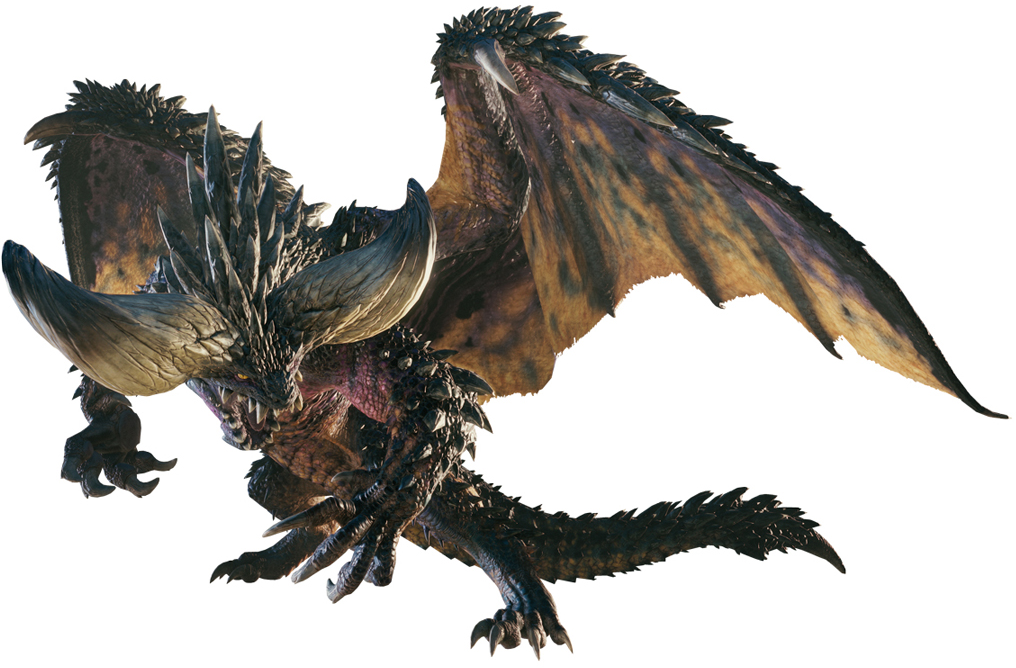
Vaal Hazak
Vaal Hazak is a dragon that appears to have long sickle-like claws on each finger. Its face has long, sinewy features that look like decaying tissue. When it flaps its wings, it appears to stir up toxic clouds, possibly exuding the Effluvium bacteria found in the Rotten Vale. It is shown to have a mottled maroon hide with a rather dull greenish-gray underbelly. Its wings are also sinewy — looking like spider webs when outstretched.
Vaal Hazak appears to consume the life force of other wildlife nearby in the form of a grayish ash-like fog that trails from the victim back to patches on Vaal Hazak’s body. It has also demonstrated necromancer-like abilities, bringing Girros corpses back to life as allies. The ash-fog it exudes limits the maximum life of Hunters in contact with it.
Vaal Hazak
Huge undead (elder), Chaotic Evil
- Armor Class 19 (natural armor)
- Hit Points 345 (30d12 + 150)
- Speed 40 ft., fly 80 ft.
STR DEX CON INT WIS CHA 23 (+6) 10 (+0) 20 (+5) 16 (+3) 18 (+4) 14 (+2)
- Saving Throws Dex +13, Con +12, Int +10, Cha +9
- Damage Immunities necrotic
- Condition Immunities charmed, frightened, petrified
- Senses darkvision 120 ft., passive Perception 14
- Languages Draconic
- Challenge 24 (62,000 xp)
Legendary Resistance (3/Day). If the vaal hazak fails a saving throw, it can choose to succeed instead.
Magic Resistance. The vaal hazak has advantage on saving throws against spells and other magical effects.
Effluvium Aura. At the start of each of the vaal hazak's turns, each creature within 5 feet of it takes 11 (3d6) necrotic damage. A creature that touches the vaal hazak or hits it with a melee attack while within 5 feet of it takes 11 (3d6) necrotic damage.
Regeneration. The vaal hazak regains 30 hit points at the start of its turn if it has at least 1 hit point. If the vaal hazak takes radiant damage or damage from holy water, this trait doesn't function at the start of the vaal hazak's next turn.
Actions
Multiattack. The vaal hazak makes four attacks: two with its bite and two with its claws.
Bite. Melee Weapon Attack: +13 to hit, reach 10 ft., one target. Hit 24 (4d8 + 6) piercing damage.
Claw. Melee Weapon Attack. +13 to hit, reach 5 ft., one target. Hit 20 (4d6 + 6) slashing damage.
Tail. Melee Weapon Attack. +13 to hit, reach 15 ft., one target. Hit 28 (4d10 + 6) bludgeoning damage. On hit, the target must make a DC 17 Strength saving throw or be knocked prone.
Effluvium Breath (recharge 5-6). The vaal hazak exhales a cloud of effluvium bacteria in a 90-foot cone. Each creature in that line must make a DC 20 Constitution saving throw, taking 70 (20d6) necrotic damage and are cursed as if by the bestow curse spell for 1 minute on a failed save, or half as much damage on a successful one and are not cursed.
Return from the Dead (3/day). The vaal hazak raises a recently deceased CR 6 or lower creature from the dead to fight by its side. A creature raised in this way is considered undead, heals to its hit point maximum and gains the undead fortitude trait.
Legendary Actions
The vaal hazak can take 3 legendary actions, choosing from the options below. Only one legendary action option can be used at a time and only at the end of another creatures turn. The vaal hazak regains spent legendary actions at the start of its turn.
Tail Attack. The vaal hazak makes a tail attack.
Frightening Gaze (Costs 2 Actions). The vaal hazak fixes its gaze on one creature it can see within 10 feet of it. The target must succeed on a DC 19 Wisdom saving throw against this magic or become frightened for 1 minute. The frightened target can repeat the saving throw at the end of each of its turns, ending the effect on itself on a success. If a target's saving throw is successful or the effect ends for it, the target is immune to the vaal hazak's gaze for the next 24 hours.
Disrupt Life (Costs 3 Actions). Each living creature within 20 feet of the vaal hazak must make a DC 20 Constitution saving throw against this magic, taking 38 (11d6) necrotic damage on a failed save, or half as much damage on a successful one.

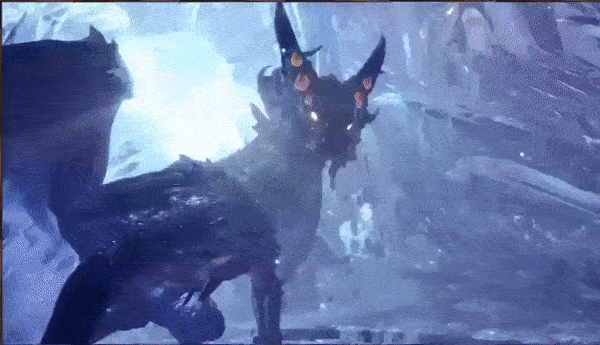
Xeno'jiiva
Gargantuan dragon (elder), unaligned
- Armor Class 18 (natural armor)
- Hit Points 425 (23d20 + 184)
- Speed 40 ft., fly 80 ft.
STR DEX CON INT WIS CHA 23 (+6) 10 (+0) 27 (+8) 3 (-4) 20 (+5) 14 (+2)
- Saving Throws Int +4, Wis +13, Cha +10
- Skills Perception +13
- Damage Resistances fire, cold, lightning; bludgeoning, piercing, and slashing damage from nonmagical weapons
- Condition Immunities charmed, frightened, paralyzed, poisoned
- Senses truesight 120 ft., passive Perception 23
- Languages -
- Challenge 25 (75,000 xp)
Legendary Resistance (3/Day). If the xeno'jiiva fails a saving throw, it can choose to succeed instead.
Magic Resistance. The xeno'jiiva has advantage on saving throws against spells and other magical effects.
Actions
Multiattack. The xeno'jiiva can use its frightful presence. It then makes five attacks: three with its bite, and two with its claws. Or it makes three blue flame attacks.
Bite. Melee Weapon Attack: +15 to hit, reach 10 ft., one target. Hit 27 (4d8 + 9) piercing damage. If the target is a creature, it is grappled (escape DC 19) . Until this grapple ends, the target is restrained, and the xeno'jiiva can't bite another target.
Claw. Melee Weapon Attack. +15 to hit, reach 5 ft., one target. Hit 19 (3d6 + 9) slashing damage.
Tail. Melee Weapon Attack. +15 to hit, reach 15 ft., one target. Hit 31 (4d10 + 9) bludgeoning damage.
Blue Flames. Ranged Weapon Attack. +8 to hit, range 80/320 ft., one target. Hit 36 (8d8) fire damage.
Fire breath (recharge 5-6). The xeno'jiiva exhales a beam of blue fire in a 120-foot line that is 10-feet wide. Each creature in that line must make a DC 20 Dexterity saving throw, taking 77 (14d10) fire damage on a failed save, or half as much damage on a successful one.
Frightful Presence. Each creature of the xeno'jiiva choice that is within 120 feet of the xeno'jiiva and aware of it must succeed on a DC 19 Wisdom saving throw or become frightened for 1 minute. A creature can repeat the saving throw at the end of each of its turns, ending the effect on itself on a success. If a creature's saving throw is successful or the effect ends for it, the creature is immune to the xeno'jiiva's Frightful Presence for the next 24 hours.
Swallow. The xeno'jiiva makes one bite attack against a Large or smaller creature it is grappling. If the attack hits, the target takes the bite damage, the target is swallowed, and the grapple ends. While swallowed, the creature is blinded and restrained, it has total cover against attacks and other effects outside the xeno'jiiva, and it takes 38 (11d6) acid damage at the start of each of the xeno'jiiva's turns. If the xeno'jiiva takes 50 damage or more on a single turn from a creature inside it, the xeno'jiiva must succeed on a DC 20 Constitution saving throw at the end of that turn or regurgitate all swallowed creatures, which fall prone in a space within 10 feet of the xeno'jiiva. If the xeno'jiiva dies, a swallowed creature is no longer restrained by it and can escape from the corpse by using 30 feet of movement, exiting prone.
Legendary Actions
The xeno'jiiva can take 3 legendary actions, choosing from the options below. Only one legendary action option can be used at a time and only at the end of another creatures turn. The xeno'jiiva regains spent legendary actions at the start of its turn.
Detect. The xeno'jiiva makes a Wisdom (Perception) check.
Tail Attack. The xeno'jiiva makes a tail attack.
Wing Attack (Costs 2 Actions). The xeno'jiiva beats its wings. Each creature within 15 feet of the dragon must succeed on a DC 23 Dexterity saving throw or take 28 (4d8 + 9) bludgeoning damage and be knocked prone. The dragon can then fly up to half its flying speed.
Chomp (Costs 2 Actions). The xeno'jiiva makes one bite attack or uses its Swallow.
Ceadeus
Ceadeus are giant sea dwelling Elder Dragons that have only been recently discovered. Older Ceadeus individuals are called Goldbeard Ceadeus. It is said that Ceadeus and Jhen Mohran share the same common ancestor.
Ceadeus is up to 5837.2cm in length. Ceadeus has a special relationship with an algae, which is the reason why it has its beard. It farms for the algae with its beard and uses the glow from the luminous bacteria as a form of photosynthesis. With this algae, Ceadeus can spend longer times under the depths without having to come up for air. When it needs air, it will swim up with a burst of speed and jump out of the water for a breath. It is estimated a Ceadeus can hold its breath for about several months. Ceadeus has powerful fins and a tail fin designed for swimming in the sea with both power and grace. The horns of a Ceadeus never stop growing, and at times, the Elder Dragon will grind them against the sea floor, with enough force to produce earthquakes and tsunamis. It is believed that this behavior resulted in the destruction of an island on at least one occasion. Throughout their years, Ceadeus are able to use an organ called the Luminous Organ. This organ is used to help farm the algae it uses to breath. The luminous bacteria on its body reacts to the organ by reflecting the light.
The Ceadeus is known to be a rather peaceful creature until provoked. It won't take notice of adventurers until it is greatly damaged by them. If Ceadeus is provoked, it'll try to kill its enemy with its immense strength.
Ceadeus
Gargantuan dragon (elder), unaligned
- Armor Class 15 (natural armor)
- Hit Points 604 (31d20+279)
- Speed 0 ft., swim 60 ft.
STR DEX CON INT WIS CHA 25 (+7) 10 (+0) 28 (+9) 9 (-1) 11 (+0) 10 (+0)
- Saving Throws Dex +9, Int +8, Wis +9, Cha +9
- Damage Immunities fire; bludgeoning, piercing, and slashing from nonmagical weapons
- Damage Resistances acid, cold, poison, thunder; bludgeoning, piercing, and slashing from magical weapons
- Condition Immunities charmed, frightened, paralyzed, poisoned, prone
- Senses blindsight 120 ft., passive Perception 10
- Languages Draconic
- Challenge 26 (90,000 xp)
Legendary Resistance (3/Day). If the ceadeus fails a saving throw, it can choose to succeed instead.
Magic Resistance. The ceadeus has advantage on saving throws against spells and other magical effects.
Siege Monster. The ceadeus deals double damage to objects and structures.
Actions
Multiattack. The ceadeus makes one tail attack and one bite attack.
Bite. Melee Weapon Attack. +16 to hit, reach 10 ft., one target. Hit 21 (4d6 + 7) piercing damage.
Tail. Melee Weapon Attack. +16 to hit, reach 20ft., one target. Hit 25 (4d8 + 7) bludgeoning damage.
Hydropump (recharge 5-6). The ceadeus releases a high pressure stream of water in an 120-foot line that is 10 feet wide. Each creature in that line must make a DC 17 Dexterity saving throw, taking 72 (16d8) cold damage on a failed save, or half as much damage and not on a successful one.
Legendary Actions
The ceadeus can take 3 legendary actions, choosing from the options below. Only one legendary action option can be used at a time and only at the end of another creatures turn. The ceadeus regains spent legendary actions at the start of its turn.
Detect. The ceadeus makes a Wisdom (Perception) check.
Tail Attack. The ceadeus makes one Tail attack.
Torpedo (Costs 2 Actions). The ceadeus swims up to its swim speed, during this move it may swim through other creatures without provoking attacks of opportunity. Any creatures the ceadeus moves through must succeed on a DC 17 Dexterity saving throw or take 21 (4d6 + 7) bludgeoning damage and be knocked prone.
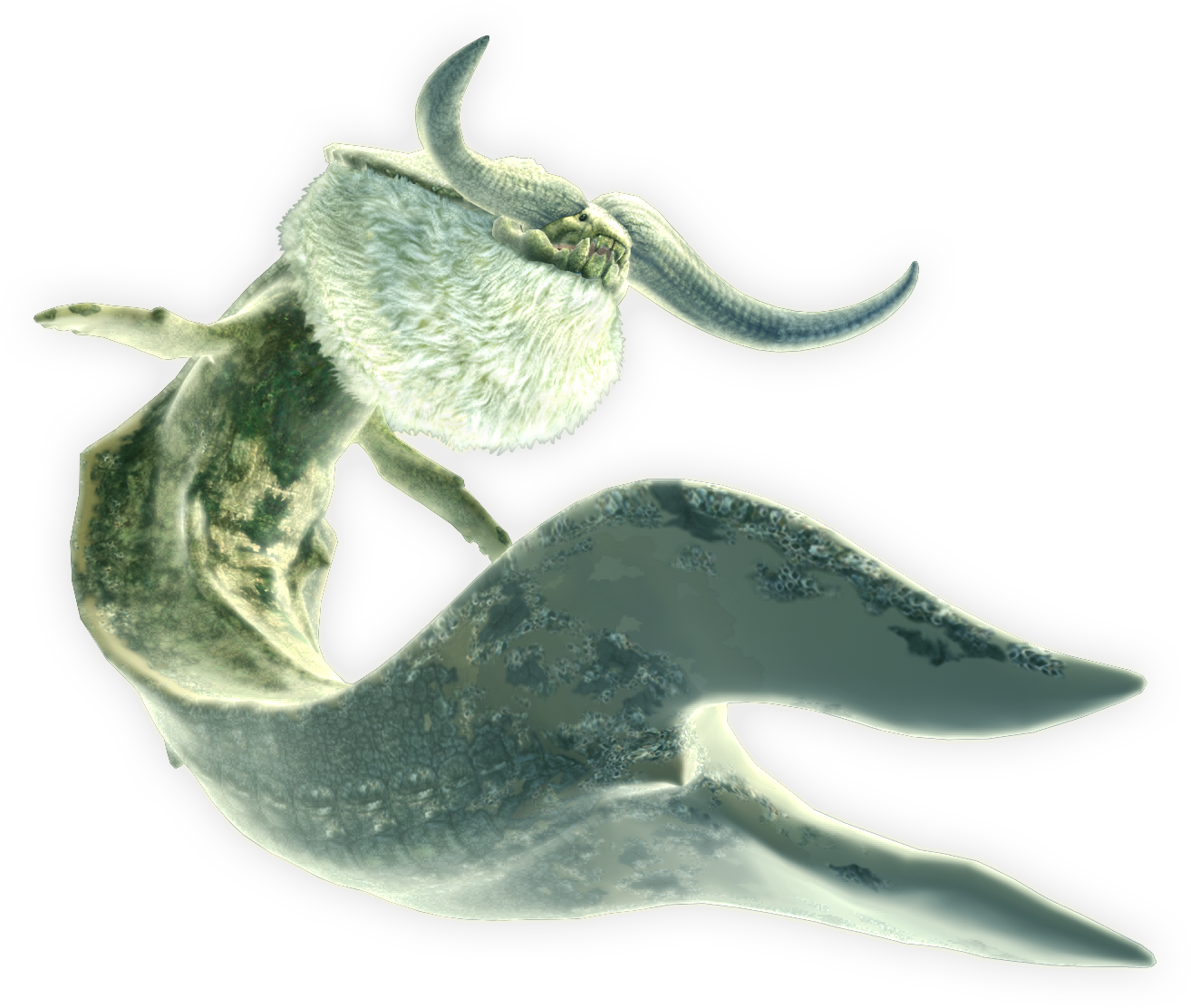
Jhen Mohran
Jhen Mohran is a giant Elder Dragon that swims within the sand. itfeeds very much like a baleen whale. It swallows large amounts of sand to filter in any type of nutrients found within the sands.
Jhen Mohran's main adaptation is its huge size. Jhen Mohran is up to 11161.9 cm, twenty percent of this length is its tusks. Its body is streamlined and equipped with immensely powerful limbs, which allows it to travel through the sand at great speeds. It uses the front limbs and tusks to push aside sand. Though Jhen Mohran feeds on the nutrients found within the sand, it will expel the unnecessary materials outside of its body with the help of multiple blowholes. The expelled sand alone can cause a change in flow to the quicksand in the Great Desert. Occasionally, seasonal winds can catch the expelled sands and blow the sands in the direction of settlements, causing massive sandstorms. Jhen Mohran has powerful lungs that helps it hold its breath for long periods of time. Some older Jhen Mohran can even use their lungs to fire a destructive beam of sand at foes. If sand wasn't covering Jhen Mohran than it would be a beautiful blue color. By spending long periods in the sand, the ore has formed from be polished by the sands.
Jhen Mohran is a relatively calm creature, but has been known to retaliate against Desert/Dragon Ships if attacked as they see them as potential rivals. It takes little notice of hunters climbing on its back, and will only occasionally try to fling them off.
Jhen Mohran
Gargantuan dragon (elder), unaligned
- Armor Class 20 (natural armor)
- Hit Points 553 (36d20 + 360)
- Speed 20 ft., swim 60 ft.
STR DEX CON INT WIS CHA 27 (+8) 10 (+0) 30 (+10) 9 (-1) 11 (+0) 10 (+0)
- Saving Throws Dex +9, Int +8, Wis +9 Cha +9
- Damage Immunities fire; bludgeoning, piercing, and slashing from nonmagical weapons
- Damage Resistances acid, lightning, poison, thunder; bludgeoning, piercing, and slashing from magical weapons
- Condition Immunities charmed, frightened, paralyzed
- Senses blindsight 120 ft., passive Perception 10
- Languages Draconic
- Challenge 26 (90,000 xp)
Legendary Resistance (3/Day). If the jhen mohran fails a saving throw, it can choose to succeed instead.
Magic Resistance. The jhen mohran has advantage on saving throws against spells and other magical effects.
Siege Monster. The jhen mohran deals double damage to objects and structures.
Siege Vulnerability. Siege weapons ignore jhen mohran immunities and resistances.
Sand Surfing. The jhen mohran can swim through desert terrain as if it was water.
Actions
Body Slam. Melee Weapon Attack. +17 to hit, reach 5 ft., one target. Hit 34 (4d12 + 8) bludgeoning damage.
Tusks. Melee Weapon Attack. +17 to hit, reach 30 ft., one target. Hit 30 (4d10 + 8) piercing damage.
Rock Toss. Range Weapon Attack. +9 to hit, reach 80/320 ft., one target. Hit 24 (7d6) bludgeoning damage.
Horn Sweep (recharge 5-6). The jhen mohran sweeps its tusks across an area that is 30-feet long and 40-foot wide in front of it. Each creature in that area must make a DC 23 Dexterity saving throw, taking 32 (4d10+10) bludgeoning damage and are knocked prone on a failed save or half as much on a successful one and are not knocked prone.
Legendary Actions
The jhen mohran can take 3 legendary actions, choosing from the options below. Only one legendary action option can be used at a time and only at the end of another creatures turn. The jhen mohran regains spent legendary actions at the start of its turn.
Summon Delex. Two delex emerge from underground to assist the jhen mohran.
Rock Toss. The jhen mohran makes a Rock Toss attack.
Shake Off (Costs 2 Actions). The jhen mohran thrashes around in an attempt to throw any object or creature that is on its body. Each creature on the jhen mohran must make a DC 25 Strength or Dexterity saving throw (creature's choice), or be thrown, up to 40 feet, off the jhen mohran. If a thrown target strikes a solid surface upon landing, the target takes 3 (1d6) bludgeoning damage for every 10 feet it was thrown.
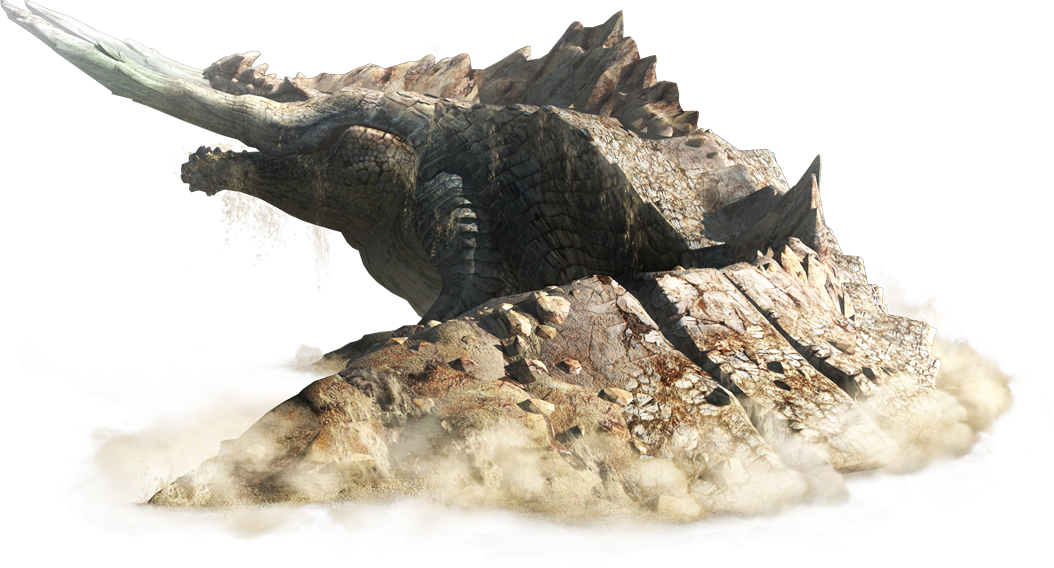
VARIANT: Dah'ren Mohran
A dah'ren mohran has a challenge rating of 27 (105,000 XP). It has the same statistics as a jhen mohran except that it adds +2 to its Armor Class (AC 22), loses its resistance to lightning but gains resistance to cold, and replaces the jhen mohran's action options with, the following action options.
Body Slam. Melee Weapon Attack. +17 to hit, reach 5 ft., one target. Hit 34 (4d12 + 8) bludgeoning damage.
Horn. Melee Weapon Attack. +17 to hit, reach 30 ft., one target. Hit 30 (4d10 + 8) piercing damage.
Rock Toss. Range Weapon Attack. +9 to hit, reach 80/320 ft., one target. Hit 24 (7d6) bludgeoning damage.
Horn Drill (recharge 5-6). The dah'ren mohran moves up to its swim speed while rotating at high speed. During this move it may swim through other creatures without provoking attacks of opportunity. Each creature the dah'ren mohran moves through must make a DC 23 Dexterity saving throw, taking 34 (4d12+8) bludgeoning damage and are knocked prone on a failed save or half as much on a successful one and are not knocked prone.
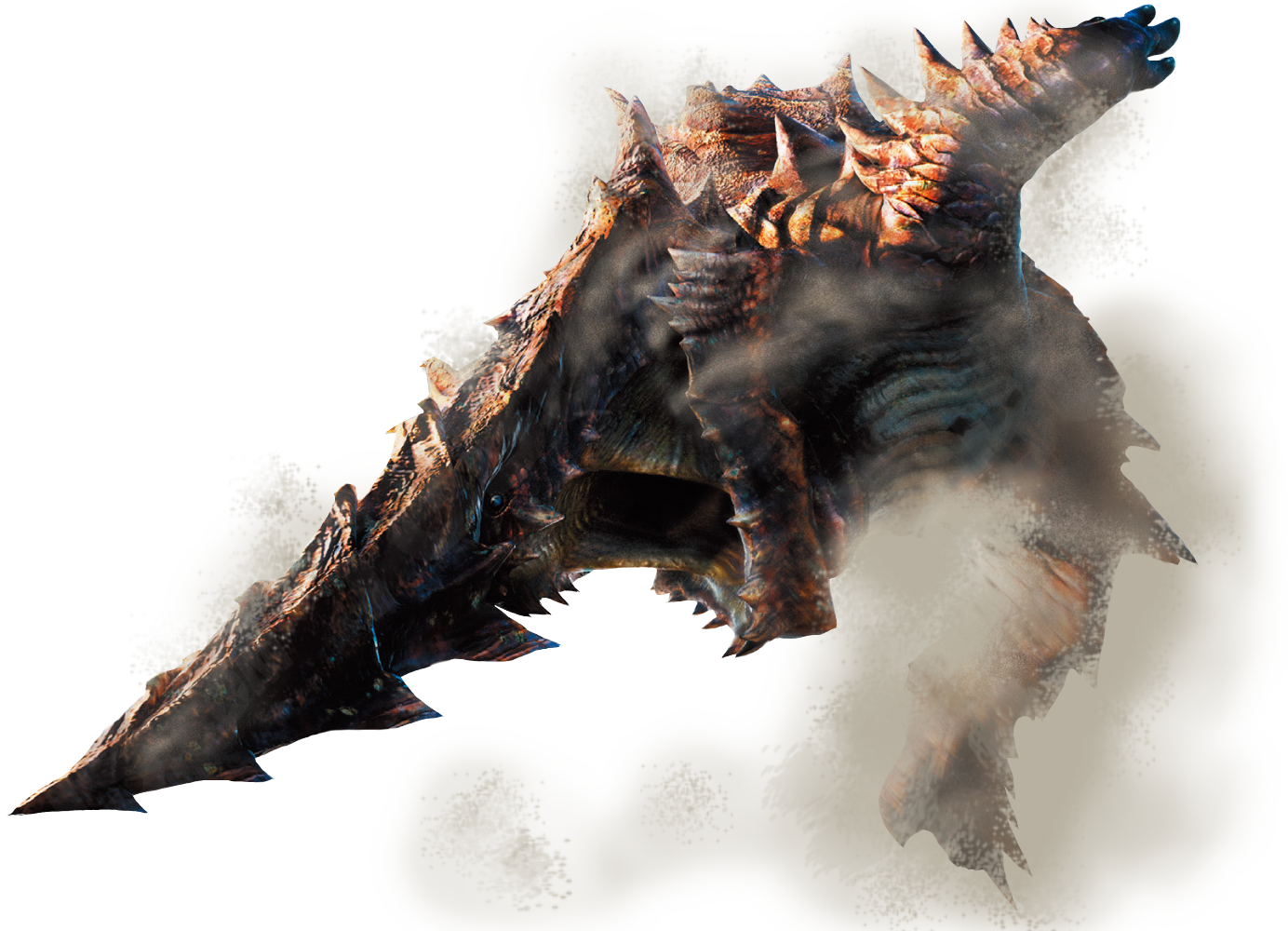
Behemoth
A powerful beast from another world. Its large horns and muscular frame defy nature. It is a ferocious beasts with regal, fluttering manes and roars violent enough to shake the earth itself. After rending foes with long claws and horns, they usually use their sharp teeth to deal the killing blow. Also known to use high-level magic, Behemoths are enemies of the top rank hunter.
Due to their great power, Behemoths usually attack alone, but occasionally attack in small groups of two or three. Behemoths use strong physical attacks and often counter attacks with an attack of their own. This is not their
only advantage, unlike most other Monsters, Behemoth
can cast spells. Hunters have reported seeing tornadoes
conjured from thin air under them, fire erupting from
solid stone below them, and large rocks
falling from the skies at extreme speeds.
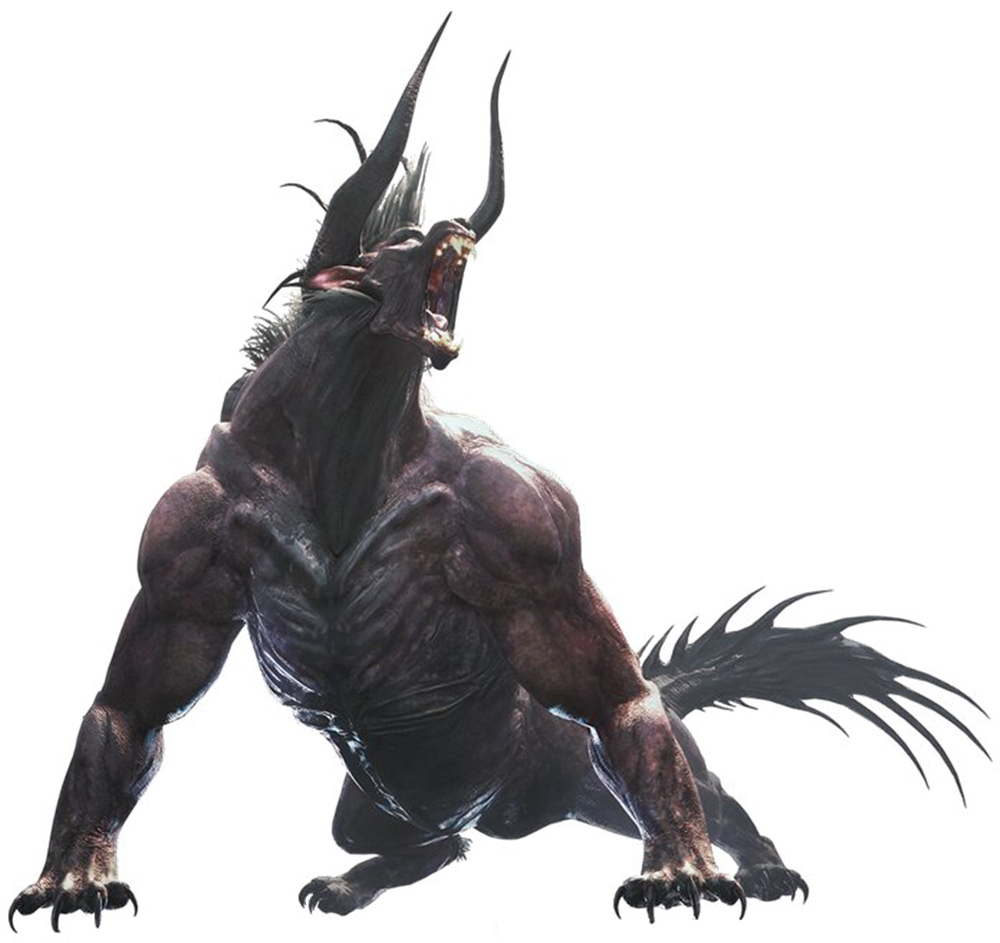
Behemoth
Gargantuan beast (elder), Chaotic Evil
- Armor Class 22 (natural armor)
- Hit Points 462 (25d20 + 200)
- Speed 40 ft., burrow 30 ft.
STR DEX CON INT WIS CHA 27 (+8) 14 (+2) 27 (+8) 16 (+3) 18 (+4) 22 (+6)
- Saving Throws Str +16, Con +16, Wis +12, Cha +14
- Skills Athletics +16, Investigation +12, Perception, +12
- Damage Resistances fire, thunder; bludgeoning, piercing, and slashing from nonmagical Attacks
- Senses truesight 120 ft., passive Perception 22
- Languages Abyssal, Deep Speech, Infernal
- Challenge 27 (105,000 xp)
Apocalypse. The behemoth can only use its Ecliptic Meteor if it is below one-quarter of its maximum hit points (112), or if it has used Comet action three times in the same battle.
Erupting Flames. When the behemoth makes a claw attack, flames erupt from the ground at the targets location. The target must make a DC 22 Dexterity saving throw, taking 27 (5d10) fire damage on a failed save.
Legendary Resistance (3/Day). If the behemoth fails a saving throw, it can choose to succeed instead.
Magic Resistance. The behemoth has advantage on saving throws against spells and other magical effects.
Siege Monster. behemoth deals double damage to objects and structures.
Actions
Multiattack. The behemoth makes three attacks, one with its horn and one with its tail and one with its claw.
Frightful Presence. Each creature of the behemoth's choice that is within 120 feet of the behemoth and aware of it must succeed on a DC 22 Wisdom saving throw or become frightened for 1 minute. A creature can repeat the saving throw at the end of each of its turns, ending the effect on itself on a success. If a creature's saving throw is successful or the effect ends for it, the creature is immune to the behemoth's Frightful Presence for the next 24 hours.
Horns. Melee Weapon Attack: +16 to hit, reach 10 ft., one target. Hit 30 (4d10 + 8) piercing damage.
Tail. Melee Weapon Attack. +16 to hit, reach 20 ft., one target. Hit 26 (4d8 + 8) bludgeoning damage. If the target is a creature, it must succeed on a DC 20 Strength saving throw or be knocked prone.
Claw. Melee Weapon Attack. +16 to hit, reach 15 ft., one target. Hit 15 (2d6 + 8) slashing damage.
Thunderbolt. The behemoth magically creates two bolts of lightning, each of which can strike a target the behemoth can see within 120 feet of it. A target must make a DC 22 Dexterity saving throw, taking 31 (9d6) lightning damage on a failed save, or half as much damage on a successful one.
Comet (Recharge 5-6). The behemoth conjures a 10-foot wide, 10-foot tall chunk of burning rock from the sky that strikes a location it can see within 120 feet of it. Each creature within a 30-foot radius of the impact must make a DC 22 Dexterity saving throw, taking 33 (6d10) bludgeoning damage and 33 (6d10) fire damage on a failed save, or half as much on a successful one.
Upon impact the comet becomes part of the environment, any creature that was directly under the comets impact pushed 5 feet out of the comets space into an unoccupied space of the creature's choice. If no unoccupied space is with in range, the creature instead falls is restrained (Escape DC 20) under the comet, taking 11 (2d10) fire damage at the start of each of its turns while restrained in this way.Ecliptic Meteor (1/day). The behemoth summons an enormous magic circle in the sky. From it a massive 30-foot wide meteor begins to fall from the sky. At the beginning of the behemoth's next turn, even if it dies, the meteor hits the ground in the location the behemoth summoned it from. Each creature, besides the behemoth, within a 300-foot sphere of the meteor's impact point must make a DC 22 Dexterity saving throw. On a failed save, the creature takes 58 (9d12) fire damage plus 65 (10d12) thunder damage and they are pushed 25 feet away from the meteor location. On a successful save the creature takes half damage and is not pushed back.
A creature that has full cover from the meteor, takes no damage and it is not knocked back.
All comets, tree, rocks, and smaller cover is destroyed with 300 feet of the meteor's impact.Legendary Actions
The behemoth can take 3 legendary actions, choosing from the options below. Only one legendary action option can be used at a time and only at the end of another creatures turn. The behemoth regains spent legendary actions at the start of its turn.
Tail Attack. The behemoth makes one tail attack.
Charybdis. The behemoth targets a creature within 120 feet of it. Magical winds begin to swirl around the creature. At the end of the creatures next turn, a small 5 foot wide, 10 foot tall tornado appears under them.
The tornado lasts for 1 minute, heavily obscures the area it is in, and a creature that starts its turn or enters a space within 10 feet of the tornado must make a DC 22 Strength saving throw or be pushed back 10 feet and knocked prone.Thunderbolt (Costs 2 Actions). The behemoth uses thunderbolt.
Fatalis
In legend, it is said that all living things fear Fatalis, including other Elder Dragons, such as Teostra and Lao-Shan Lung. All monsters are said to try to avoid Fatalis at all costs, leading to some leaving areas altogether simply to avoid it.
The Fatalis is a powerful, unnatural beast. The Fatalis scales are extremely thick, while its shell is very durable. This is due to Fatalis melting the armor of its fallen prey on its shell, increasing its protection against some attacks. Fatalis doesn't seem to have very good eyesight, though this may be partially be due to what its eyes are made of. Creepily, a Fatalis's eyes are made out of crystals. How is unknown. Fatalis's wing membrane is flexible, but as hard as metal. From this, Fatalis's wings don't break very easily, allowing it to fly at high speeds and support itself as it becomes airborne. Even on the ground, Fatalis is able to walk on all fours and rush prey at shocking speeds with sheer power behind its bulk. The most powerful feature is its powerful fiery breath. This fire is some of the strongest fire breath out of all monsters and can kill most enemies almost instantly. Recent encounters have revealed that Fatalis possess control over fire on par with Teostra and Lunastra. Its fire breath extends well beyond the length and height of the already large dragon.
In some legends about the Fatalis, there is a legend known by some as the shifting scales of fate. This legend claims that the Second Coming of Fatalis is infinite. The Fatalis in this legend is quite different from the Fatalis seen in the other legends. This Fatalis is described to have six horns, a glowing blue chest, a short mane in between its spikes, bizarre fluids flowing throughout its body, and the ability to shift its scales from black, red, or white. Each set of scales is said to grant the fatalis different abilities and protection. The most well known of these skills are the Black Flame and Crimson Demons breath that are said to combine the elements Fire and Death together, Despite both being combined together with the same elements, Each breath has a different element that seems to overtake this Fatalis's body, allowing it to do things not seen in other legends. This Fatalis is said to be able to send monsters running with a single flap of its wings.
A creepy light coming from its eyes invites those it stares at into its dark depths. The fluids are said to have no exact weight. Its shell is impervious to strikes from weapons and has terrifying power inside of it, which could be unleashed at anytime. The scariest part about this legend is that not only is its strength far beyond the ones from the other legends, but its body shows signs of possible regenerative powers. This means that this Fatalis maybe able to regenerate after taking large amounts of damage, just like Dire Miralis can regenerate from its still beating heart. Thankfully, this legend hasn't been proven as of yet so the Guild has nothing to worry about.
One thing that all the legends share about Fatalis is its equipment. This equipment is much more than what it appears to be. When adventurers wear this monster's armor, they are known to disappear mysteriously without a trace or even die if the armor is worn for too long. Some who have worn the Fatalis's armor report having terrible nightmares, unsettling strength, and a feeling as if they were being possessed by something. They also report feeling a familiar pulse coming from the armor, a feeling as if their legs were taken from them. With some adventurers wearing the armor of the Black Flame, they report feeling as if their body was taken over while they were unconscious. It is said that this equipment might be alive, meaning that Fatalis might not truly be dead. In Pokke Village, a giant black blade embedded in the ice is known to regenerate days after being mined once, which supports this claim that Fatalis is still alive. Other Fatalis weapons also seem to suggest that Fatalis is still alive in some form. Some weapons despair eat at the user's hands while other weapons, when held, have hideous abyssal screams coming from them. Some weapons even have a thirst for blood. From this, it is said that it's best to not to use any equipment from Fatalis in any form at all.
Fatalis is extremely hostile to all living things. It threatens the very existence of not only the Castle Schrade, but the very world around it. In legend, it is said Fatalis could scorch the whole world with its flames in a few days, burning all lands to a crisp. Due to this, the Guild will secretly send adventurers to hunt it down to prevent public panic. However, most adventurers never return. Due to many incidents surrounding Schrade Kingdom and Fatalis, the Adventurer's Guild has classified everything about both away from the public. Fatalis's armor and quest are only allowed to those that have proven they are quite credible.
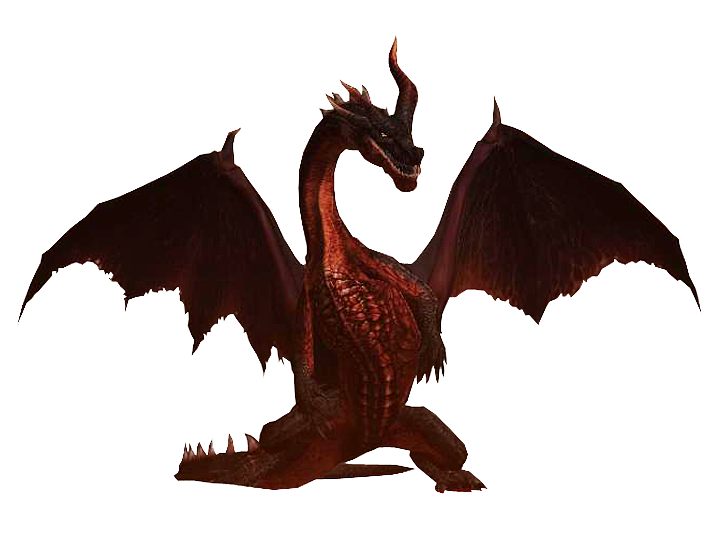
Fatalis
Gargantuan dragon (elder), chaotic evil
- Armor Class 22 (natural armor)
- Hit Points 536 (29d20+232)
- Speed 40 ft., fly 80 ft.
STR DEX CON INT WIS CHA 28 (+9) 10 (+0) 26 (+8) 19 (+4) 17 (+3) 20 (+5)
- Saving Throws Dex +8, Con +16, Wis +11, Cha +13
- Skills Insight +10, Intimidation +12, Perception +11
- Damage Immunities determined by Shifting Scales
- Senses blindsight 60 ft., darkvision 120 ft., passive Perception 21
- Languages Common, Draconic
- Challenge 28 (120,000 xp)
Legendary Resistance (3/Day). If the fatalis fails a saving throw, it can choose to succeed instead.
Magic Resistance. The fatalis has advantage on saving throws against spells and other magical effects.
Shifting Scales. The fatalis has three forms; black, crimson, and white. At the start of the fatalis turn its scales shift, black to crimson, crimson to white, or white to black. The Fatalis loses its breath weapon, damage immunities, and elemental damage from their bite or claw attacks and gain the benefits below of its new scale color. Breath attacks all share the same recharge.
Black Scales
- Black Fire (Recharge 5-6). The fatalis exhales a black flame in a 90-foot cone. Each creature in that area must make a DC 24 Dexterity saving throw, taking 55 (10d10) necrotic damage plus 28 (8d6) fire on a failed save, or half as much damage on a successful one.
- Bite. attacks deal an additional 11 (2d10) necrotic damage (not included in the attack action).
- Damage Immunities. necrotic, bludgeoning
Crimson Scales
- Crimson Demons Breath (Recharge 5-6). The fatalis exhales 90-foot line that is 10 feet wide. Each creature in that area must make a DC 24 Dexterity saving throw, taking 54 (12d8) fire damage plus 28 (8d6) necrotic on a failed save, or half as much damage on a successful one.
- Bite. attacks deal an additional 11 (2d10) fire damage (not included in the attack action).
- Damage Immunities. fire, slashing
White Scales
- Emperor's Roar (Recharge 5-6). The fatalis calls down a giant bolt of red lightning enveloping the area around the fatalis with a bright red glow. Each creature in a 20-foot-radius, 100-foot-high cylinder centered on the ground below the fatalis must make a DC 24 Dexterity saving throw, taking 56 (16d6) lighting damage plus 22 (5d8) fire on a failed save, or half as much damage on a successful one.
- Claw. attack deals an additional 7 (2d6) lightning damage (not included in the attack action).
- Damage Immunities. lightning, piercing
Actions
Multiattack. The fatalis can use its Frightful Presence. It then makes three attacks: one with its bite and two with its claws.
Frightful Presence. Each creature of the fatalis's choice that is within 120 feet of the fatalis and aware of it must succeed on a DC 21 Wisdom saving throw or become frightened for 1 minute. A creature can repeat the saving throw at the end of each of its turns, ending the effect on itself on a success. If a creature's saving throw is successful or the effect ends for it, the creature is immune to the fatalis's Frightful Presence for the next 24 hours.
Bite. Melee Weapon Attack: +17 to hit, reach 15 ft., one target. Hit 25 (3d10 + 9) piercing damage.
Claw. Melee Weapon Attack: +17 to hit, reach 10 ft., one target. Hit 19 (3d6 + 9) slashing damage.
Tail. Melee Weapon Attack: +17 to hit, 20 ft., one target. Hit 27 (4d8 + 9) bludgeoning damage.
Fireball. The fatalis exhales a fireball radius within 120 ft of its location. Each creature in a 10-foot radius Sphere centered on that point must make a DC 24 Dexterity saving throw. A target takes 31 (9d6) fire damage on a failed save, or half as much damage on a successful one.
Legendary Actions
The fatalis can take 3 legendary actions, choosing from the options below. Only one legendary action option can be used at a time and only at the end of another creatures turn. The fatalis regains spent legendary actions at the start of its turn.
Detect. The fatalis makes a Wisdom (Perception) check.
Tail Attack. The fatalis makes a tail attack.
Wing Attack (Costs 2 Actions). The dragon beats its wings. Each creature within 15 feet of the fatalis must succeed on a DC 24 Dexterity saving throw or take 19 (3d6 + 9) bludgeoning damage and be knocked prone. The fatalis can then fly up to half its flying speed.
Shah Dalamadur
Shah Dalamadur sport a lighter, sand-colored hide with red-orange spines after molting out of their old skin. After molting, Shah Dalamadur have no control over their metabolism, meaning their body temperature will constantly change. When cold, a Shah Dalamadur's hide can repel most attacks. When hot, the hide of a Shah Dalamadur is vulnerable to most attacks. From their body temperature constantly changing, Shah Dalamadur are able to perform an ability never seen before by a normal Dalamadur. Shah Dalamadur are able to burn the very ground with their powerful heated metabolism through just about any part of their body that is heated. This heat can leave behind powerful flames with just a single touch.
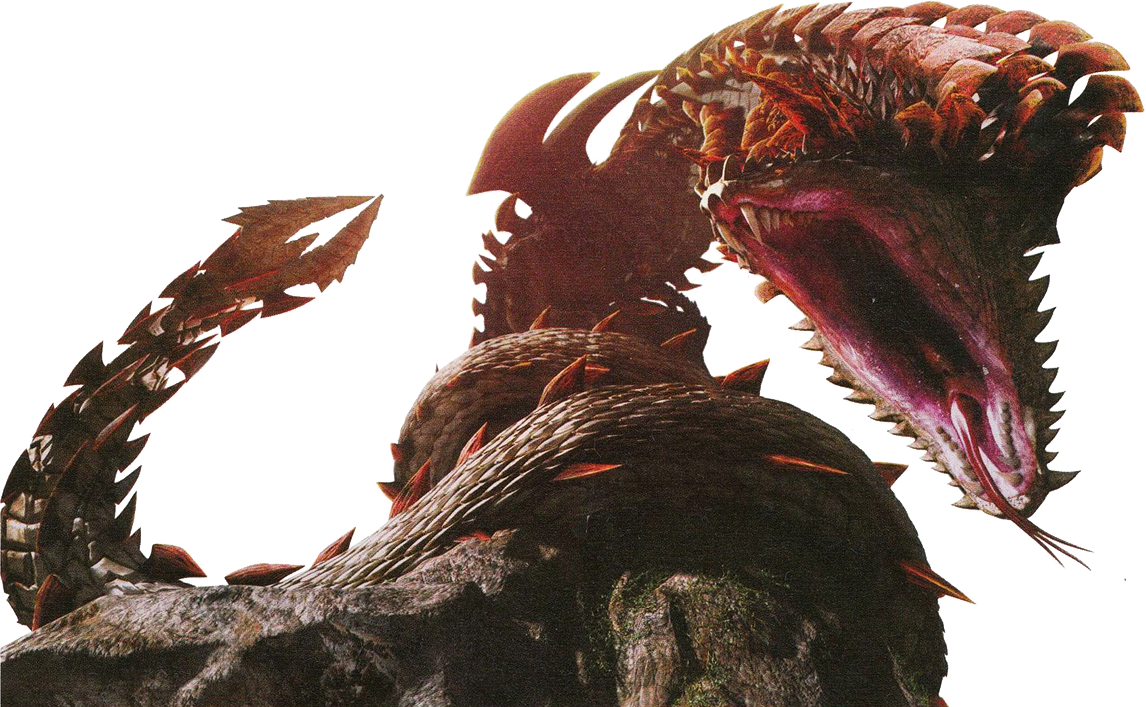
Shah Dalamadur
Gargantuan dragon (elder), unaligned
- Armor Class 23 (natural armor)
- Hit Points 594 (29d20 + 290)
- Speed 60 ft., burrow 60 ft., climb 60 ft.
STR DEX CON INT WIS CHA 20 (+5) 28 (+9) 30 (+10) 26 (+6) 21 (+5) 20 (+5)
- Saving Throws Str +14, Wis +14 Cha +14
- Skills Perception +23, Stealth +18
- Damage Resistances fire, poison
- Condition Immunities charmed, frightened, paralyzed
- Senses truesight 120 ft., passive Perception 33
- Languages Common, Deep Speech, Draconic, Sylvan, Telepathy 120 ft.
- Challenge 30 (155,000 xp)
Aggressive. As a bonus action, the shah dalamadur can move up to its speed toward a hostile creature that it can see.
Legendary Resistance (3/Day). If the shah dalamadur fails a saving throw, it can choose to succeed instead.
Magic Resistance. The shah dalamadur has advantage on saving throws against spells and other magical effects.
Siege Monster. The shah dalamadur deals double damage to objects and structures.
Uncontrolled Metabolism. The shah dalamadur have no control over their metabolism. At the start of its turn roll a d4;
On a 1-2,
The shah dalamadur overheats and gains the following benefits and loses any benefits it had from the previous turn:
Fire Aura. At the start of each of the shah dalamadur's turns, each creature within 10 feet of it takes 14 (4d6) fire damage, and flammable objects in the aura that aren't being worn or carried ignite. A creature that touches the shah dalamadur or hits it with a melee attack while within 5 feet of it takes 14 (4d6) fire damage.
Burn. When the shah dalamadur hits a creature with a bite attack, tail attack, or with its constrict; that creature begins to burn, taking 5 (1d10) fire damage at the start of each of its turns until a creature takes an action to douse the fire.On a 3-4,
The shah dalamadur cools to almost freezing temperatures and gains the following benefit and loses any benefits it had from the previous turn:
Frozen Hide. The shah dalamadur hide repels most attacks. It has resistance to all damage except psychicActions
Multiattack. The shah dalamadur can use its frightful presence. It then makes two attacks: one with its bite and one with its tail. It can't make both attacks against the same target.
Bite. Melee Weapon Attack. +18 to hit, reach 15 ft., one target. Hit 31 (4d10 + 9) piercing damage, and the target must make a DC 27 Constitution saving throw, taking 28 (8d6) poison damage on a failed save, or half as much damage on a successful one.
Tail. Melee Weapon Attack. +18 to hit, reach 25 ft., one target. Hit 27 (4d8 + 9) piercing damage.
Constrict. Melee Weapon Attack: +14 to hit, reach 10 ft., one creature. Hit: 31 (4d12 + 5) bludgeoning damage, and the target is grappled (escape DC 22). Until this grapple ends, the creature is restrained, and the shah dalamadur can't constrict another target.
Frightful Presence. Each creature of the shah dalamadur's choice that is within 120 feet of the shah dalamadur and aware of it must succeed on a DC 22 Wisdom saving throw or become frightened for 1 minute. A creature can repeat the saving throw at the end of each of its turns, ending the effect on itself on a success. If a creature's saving throw is successful or the effect ends for it, the creature is immune to the shah dalamadur's Frightful Presence for the next 24 hours.
Rattle. Using the hypnotic sounds from the rattle on its tail, the shah dalamadur chooses one humanoid it can see within 30 feet of it must succeed on a DC 22 Wisdom saving throw or be magically charmed for 1 day. The charmed target obeys the shah dalamadur's spoken and telepathic commands. If the target suffers any harm from the dalamadur or another creature or receives a suicidal command from the shah dalamadur, the target can repeat the saving throw, ending the effect on itself on a success. If a target's saving throw is successful, or if the effect ends for it, the creature is immune to the shah dalamadur's Fiendish Charm for the next 24 hours. A creature that is Deafened is immune to this effect.
Fire Breath (Recharge 5-6). The shah dalamadur exhales fire in a 90-foot cone. Each creature in that area must make a DC 27 Dexterity saving throw, taking 88 (16d10) fire damage on a failed save, or half as much damage on a successful one.
Legendary Actions
The shah dalamadur can take 3 legendary actions, choosing from the options below. Only one legendary action option can be used at a time and only at the end of another creatures turn. The shah dalamadur regains spent legendary actions at the start of its turn.
Squeeze. The shah dalamadur makes a constrict attack.
Rattle (Costs 2 Actions). The shah dalamadur uses its Rattle.
Meteor (Costs 3 Actions). The shah dalamadur opens its mouth and magically creates three swirling balls of blue fire, launching them into the sky, each of which can strike a different target the shah dalamadur can see within 120 feet of it. A target must make a DC 22 Dexterity saving throw, taking 31 (7d8) lightning damage on a failed save, or half as much damage on a successful one.
Lao-Shan Lung
An Elder Dragon, albeit a gigantic specimen. Lao-Shan Lung was once considered the largest monster in the world until recently. Lao-Shan Lung specializes in feeding on different types of ore and minerals, no matter what region it goes to. Though its size surpasses most other species, it has one natural predator that is considered a myth. That predator is Fatalis.
Huge. One of the largest dragons ever documented, rivaled only by colossi such as Ceadeus, Dalamadur, Laviente, Jhen Mohran and Zorah Magdaros. Lao-Shan Lungs are very well armored, although their bellies are vulnerable, as are their heads. Their shells only thicken as the time passes by. A Lao-Shan Lung shell coloration is determined by the kind of mineral particles that float in the atmosphere and get attached to its body as the dragon ages: the ones who dwell in the mountains are colored red because of the abundance of iron particles, while the ones that live near the Volcanic Belt are mostly grey due to ash. Like most dragons, their roar is very loud and can affect adventurers a good distance away. Because of their size, getting stepped on or whipped by the tail is very damaging or possibly fatal if the adventurer's armor is low grade.
Extremely docile even when facing multiple foes. They appear to care little about adventurers, as they mainly ignore them on their way to the town fortress. That said, they will put in a great deal of effort to break the fort rather than simply run away. Despite their low aggression, their immense size poses a tremendous risk to adventurers in their general vicinity.
Lao-Shan Lung
Gargantuan dragon (elder), unaligned
- Armor Class 28 (natural armor)
- Hit Points 615 (30d20 + 300)
- Speed 30 ft.
STR DEX CON INT WIS CHA 30 (+10) 10 (+0) 30 (+10) 9 (-1) 11 (+0) 10 (+0)
- Saving Throws Dex +9, Int +8, Wis +9 Cha +9
- Damage Immunities fire; bludgeoning, piercing, and slashing from nonmagical weapons
- Damage Resistances acid, cold, lightning, poison, thunder; bludgeoning, piercing, and slashing from magical weapons
- Condition Immunities charmed, frightened, paralyzed, poisoned
- Senses blindsight 120 ft., passive Perception 10
- Languages Draconic
- Challenge 30 (155,000 xp)
Legendary Resistance (4/Day). If the lao-shan lung fails a saving throw, it can choose to succeed instead.
Magic Resistance. The lao-shan lung has advantage on saving throws against spells and other magical effects.
Siege Monster. The lao-shan lung deals double damage to objects and structures.
Siege Vulnerability. Siege weapons ignore lao-shan lungs immunities and resistances.
Casual Stroll. the lao-shan lung cannot take the dash action, unless it is fleeing.
Walking Disaster. The lao-shan lung can enter a Large or smaller creature's space. The first time it enters a creature's space on a turn, or begins its turn adjacent to or on a creatures space turn it can make a Stomp attack against the creature.
Natural Instinct. lao-shan Lung ignores medium size or smaller creatures and attempts to flee when it reaches (153) 1/4 of its maximum hit points . While fleeing, the lao-shan Lung speed increases to 50 feet and it can only use its action to dash.
Actions
Stomp. Melee Weapon Attack: +19 to hit, reach 10 ft., one target. Hit 23 (2d12 + 10) bludgeoning damage. If the target is a creature, it must make a DC 23 Strength saving throw or be pushed back 10 ft and knocked prone.
Body Slam. Melee Weapon Attack. +19 to hit, reach 5 ft., one target. Hit 36 (4d12 + 10) bludgeoning damage.
Headbutt. Melee Weapon Attack. +19 to hit, reach 5 ft., one target. Hit 32 (4d10 + 10) bludgeoning damage.
Legendary Actions
The lao-shan lung can take 3 legendary actions, choosing from the options below. Only one legendary action option can be used at a time and only at the end of another creatures turn. The lao-shan lung regains spent legendary actions at the start of its turn.
Move. The lao-shan lung moves up to half its speed.
Stomp Attack. The lao-shan lung makes one Stomp attack.
Shake Off (Costs 2 Actions). The lao-shan lung thrashes around in an attempt to throw any object or creature that is on its body. Each creature on the lao-shan lung must make a DC 25 Strength or Dexterity saving throw (creature's choice), or be thrown off the lao-shan lung taking 14 (4d6) fall damage upon hitting the ground.
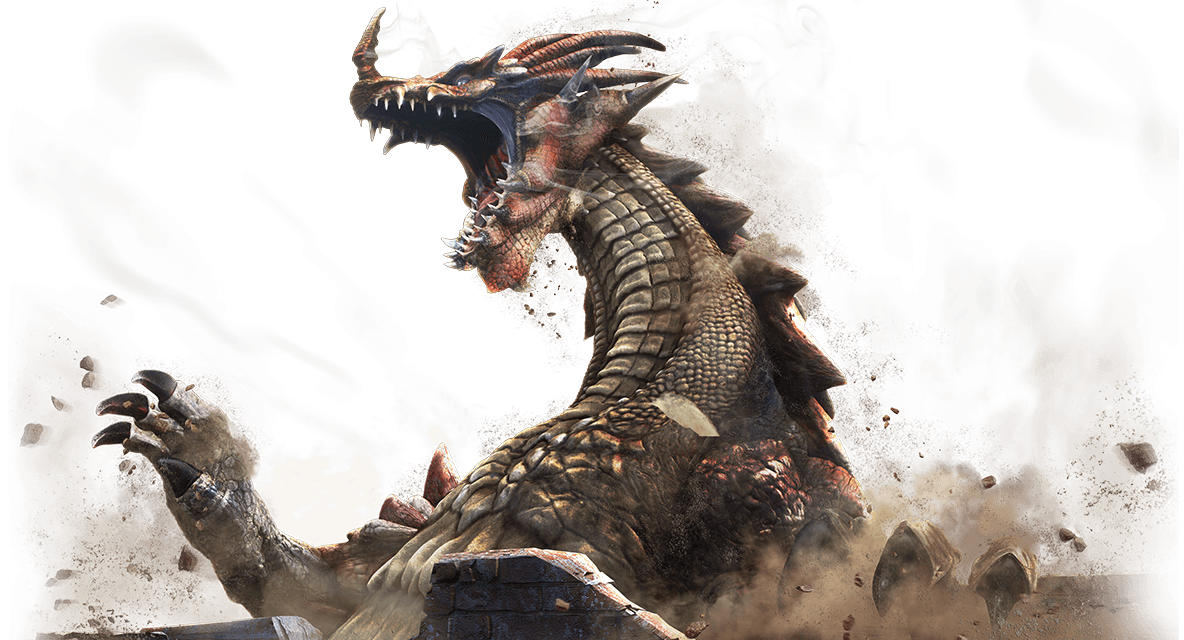

Thank you
For
Checking this out
Thank you all for using this Monster hunter Monster Manual. I created a few monsters originally because I wanted to use them in my own campaign and progressed into this Monster Manual we have today.
This section is 49 pages of monsters from the series and I am pretty proud to say I created them. I hope you all enjoy using these creatures as much as I plan too and this is not the end.
The Monster Manual might be done, but thanks to a few ideas from users on Reddit. I plan on creating a compendium with loot tables for materials, all of the weapons from the videogame series, and rules for using these monsters in your own Monster Hunter D&D game.
If you are interested in letting me know what you think. Feel free to stop by my Twitch channel or check out my Patreon. Thank you for reading and I hope this book serves you well.
Art
Most art, except the cover art, has been gathered from https://monsterhunter.wikia.com website and edited if needed to fit the page. The few others are listed below.
Lore
Most Lore, about these monsters, was also gathered from https://monsterhunter.wikia.com and then edited to omit any mention of missing skills and make the lore more in line with a D&D setting.